Just like the rest of the world, Japan seems to have Avengers Fever at the moment. Mr K is a huge fan so of course, we had to try and find a cinema to go see it. After much clever navigating of Osaka’s train system, we managed to find an enormous cinema complex in Namba down near Dontonburi that was showing it in numerous cinemas, seeming back to back all day long.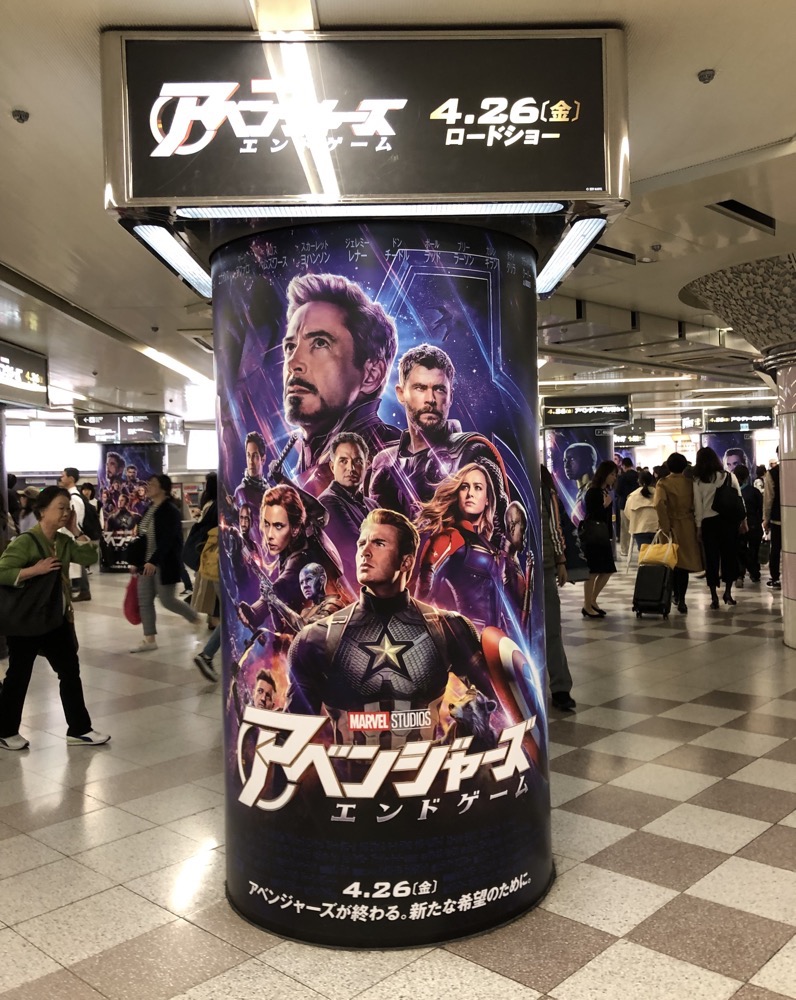 So we had popped down there yesterday afternoon and bought some tickets using an online ticket machine that wasn’t in English. As we walked away Y5400 lighter, I found myself wondering if they were indeed tickets to see ‘Avengers, End Game’ or could we have found ourselves going to see some other random crap instead! I’m always apprehensive about going to see movies in foreign countries, especially non-English speaking ones – I think it’s some sort of delayed reaction to the Munich Forest Gump Incident of ’95…
So we had popped down there yesterday afternoon and bought some tickets using an online ticket machine that wasn’t in English. As we walked away Y5400 lighter, I found myself wondering if they were indeed tickets to see ‘Avengers, End Game’ or could we have found ourselves going to see some other random crap instead! I’m always apprehensive about going to see movies in foreign countries, especially non-English speaking ones – I think it’s some sort of delayed reaction to the Munich Forest Gump Incident of ’95…
But who knows? Looking at these tickets, it could be anything – it’s a mystery!
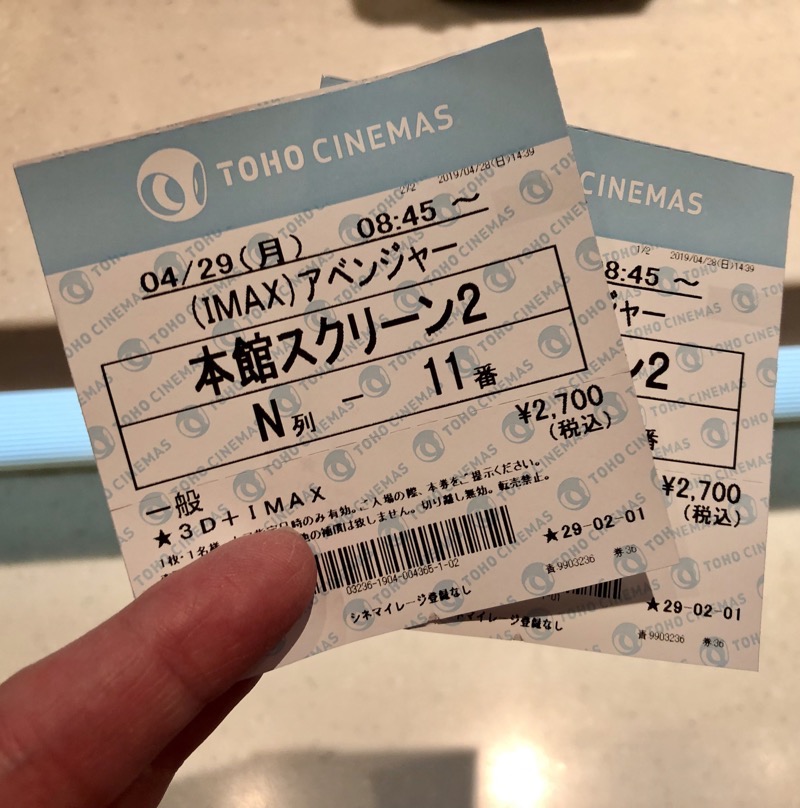 But fortunately, when we arrived this morning for our 0845 session *insert eye rolling here over the hour*, we discovered that our tickets were indeed for the correct film – in IMAX 3D… because many of the 2D sessions looked like they were dubbed.
But fortunately, when we arrived this morning for our 0845 session *insert eye rolling here over the hour*, we discovered that our tickets were indeed for the correct film – in IMAX 3D… because many of the 2D sessions looked like they were dubbed.  A couple of curiosities I noted at Japanese cinemas – there’s film merchandise for sale in the foyer…
A couple of curiosities I noted at Japanese cinemas – there’s film merchandise for sale in the foyer…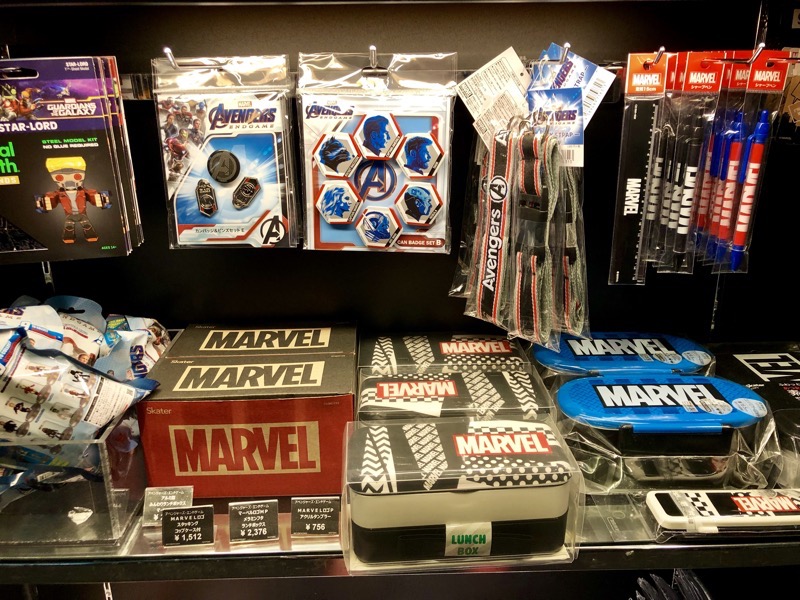
 And your candy bar selections come in a convenient little plastic tray that fits neatly into your seat drinker holder and becomes a little moveable table, like a student desk.
And your candy bar selections come in a convenient little plastic tray that fits neatly into your seat drinker holder and becomes a little moveable table, like a student desk.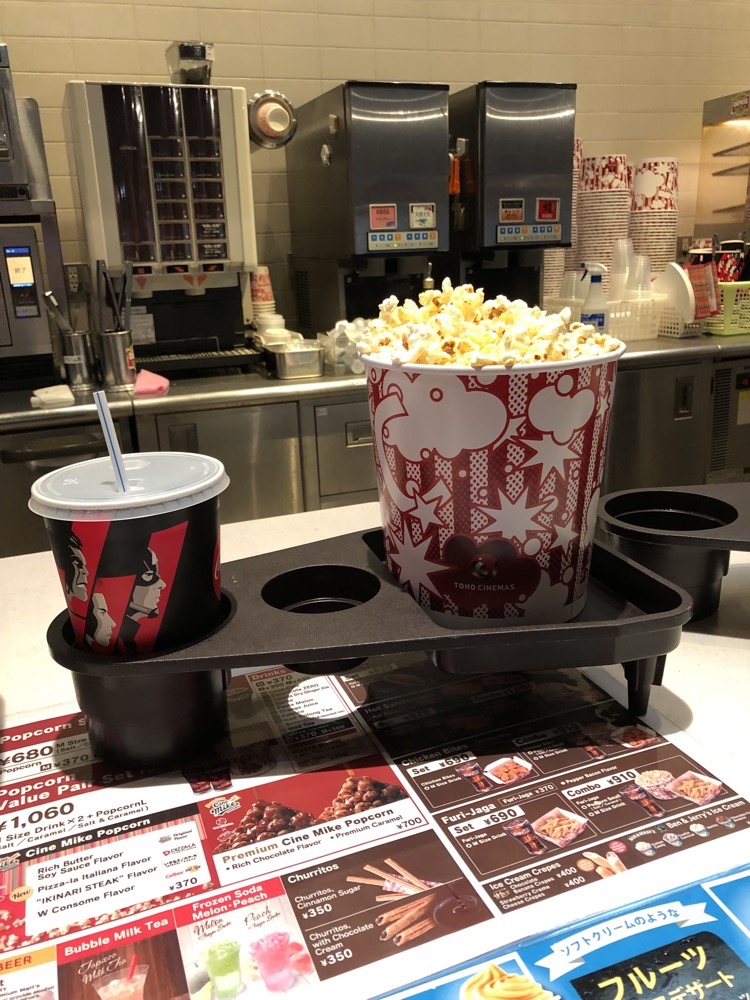

The movie was great – a very nice wrap up for the scores of movies that preceded it, and I managed to stay awake through the neverending battle scenes so there’s that bonus to going to an early morning session.
After the movie, we took a train out to Kobe to have a wander through the saké breweries in Nada, of which there are many within walking distance of each other. Kobe’s Nada district is Japan’s top sake producing region. It has traditionally been famous for its saké due to the availability of high-quality rice, suitable water and favourable weather conditions. The nearby Ports of Kobe and Osaka have also contributed to the success of the region through the ease of distribution since the late medieval period.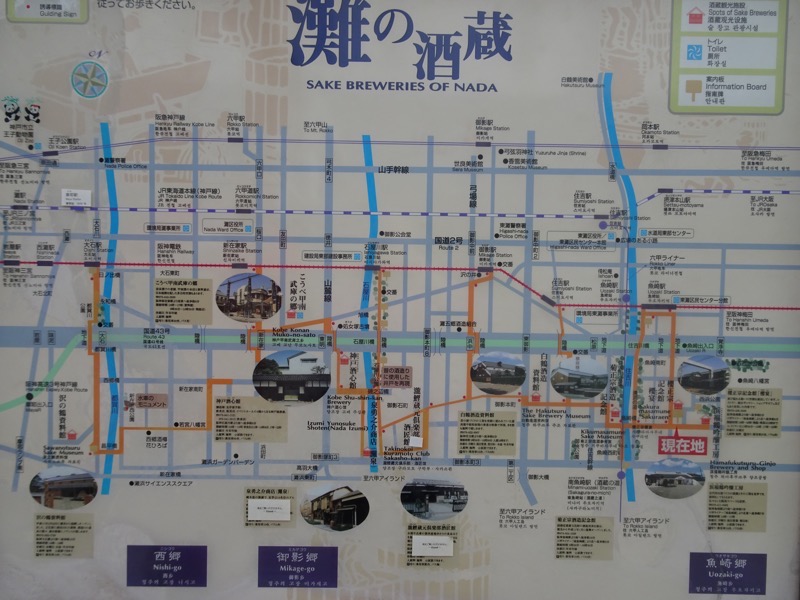

Founded in 1625, our first stop was the Sakurmasamune Saké Museum. With a history of nearly 400 years, the brewery uses the sake rice produced in Hyogo Prefecture “Yamada Nishiki” and locally available groundwater to make ginjoshu and junmaishu of the highest quality. This water called “miyamizu” and is vital to sake production in Hyogo was discovered by the 6th head of the family, Tazaemon Yamamura. Sakuramasamune has long been considered one of the pioneering saké breweries in the Nada area.
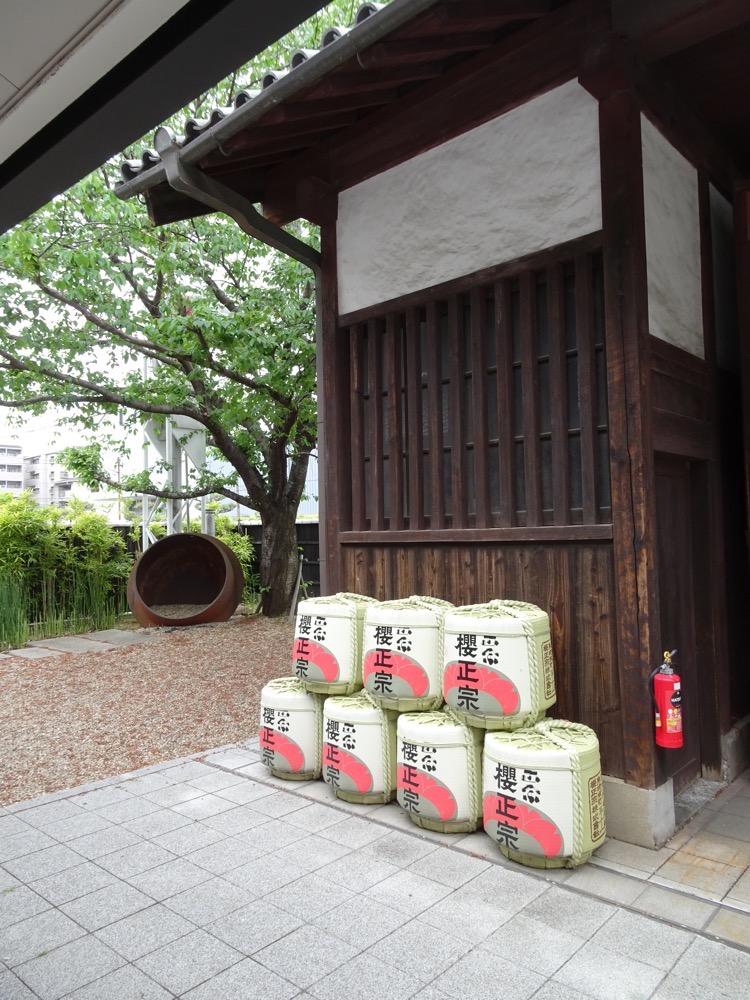 The facility here for visitors is an interesting blend of old and modern – photographs and displays of the history of the brewery within a large modern visitor centre, complete with restaurant, tasting rooms and sales floor.
The facility here for visitors is an interesting blend of old and modern – photographs and displays of the history of the brewery within a large modern visitor centre, complete with restaurant, tasting rooms and sales floor.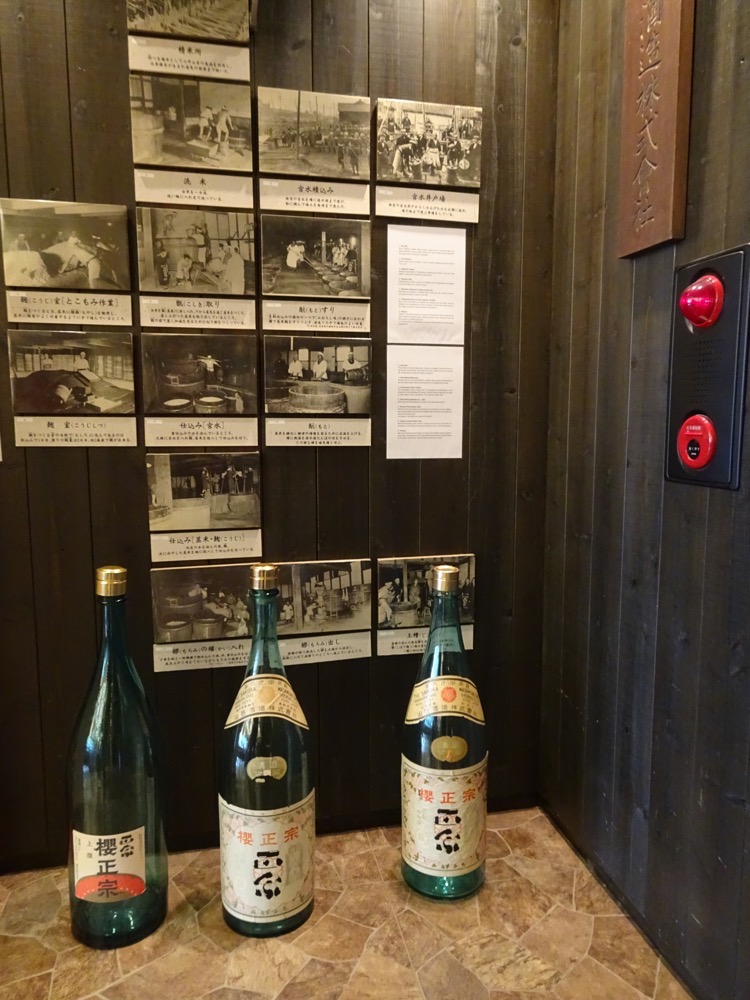
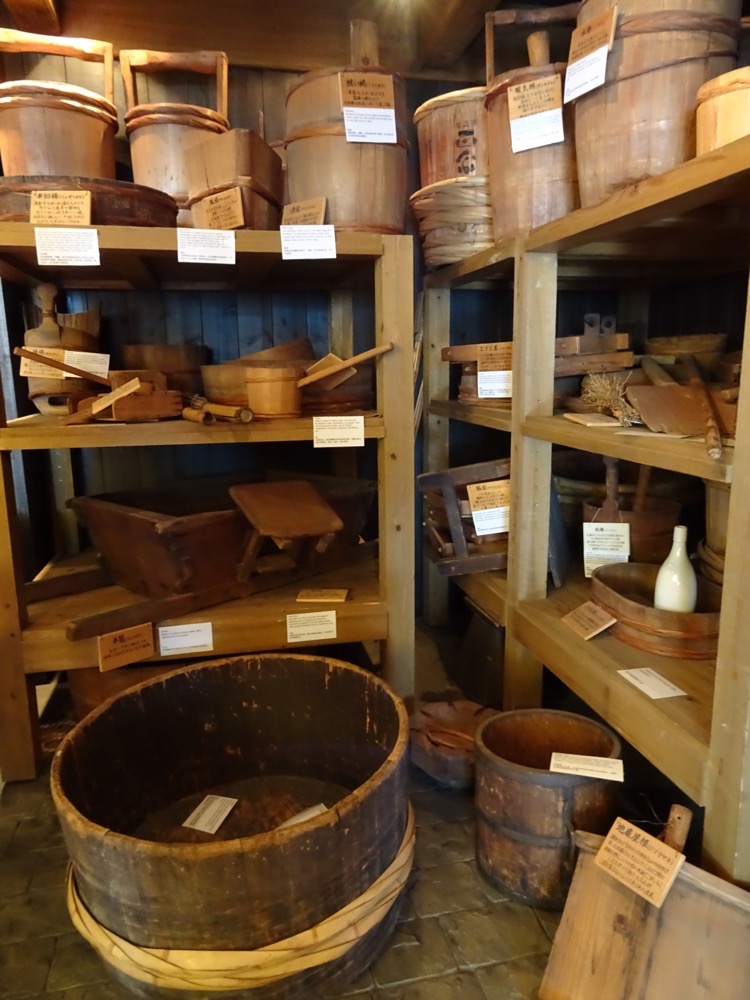

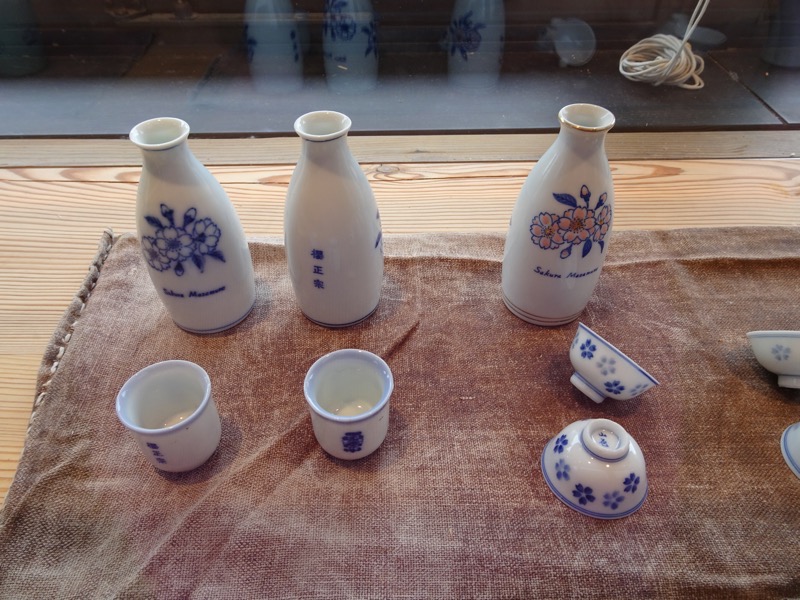
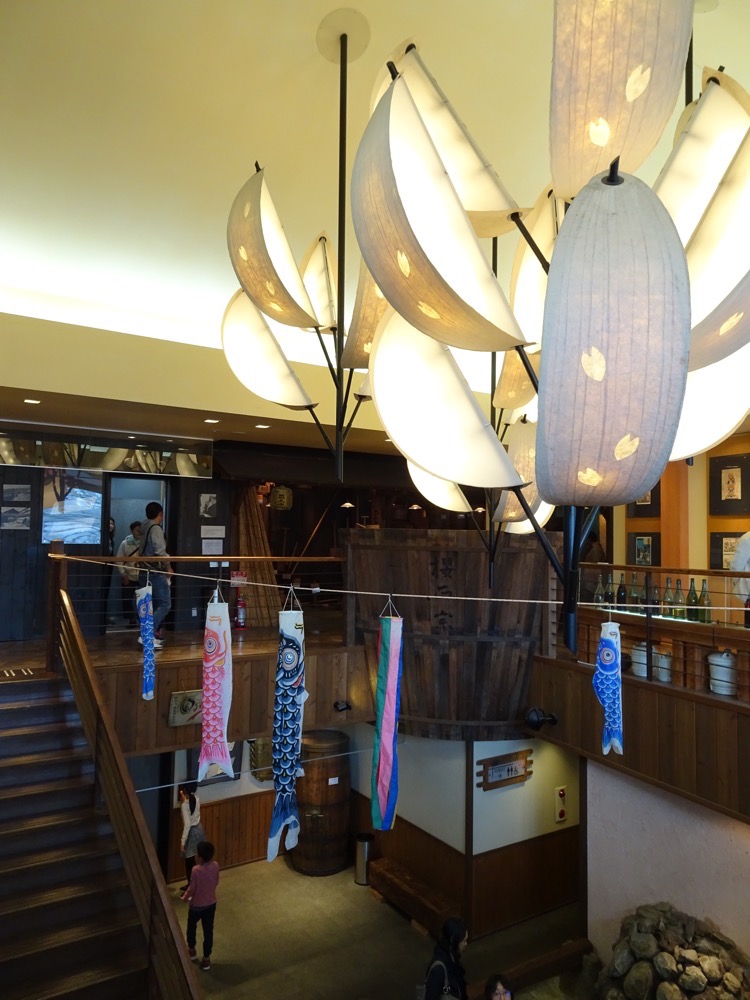
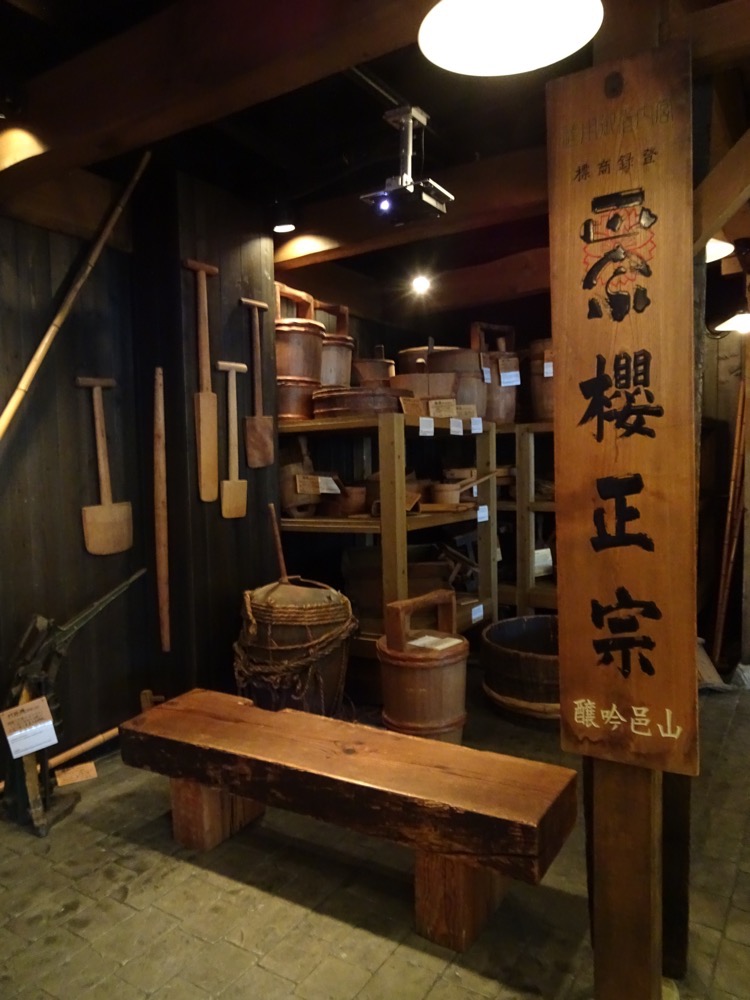
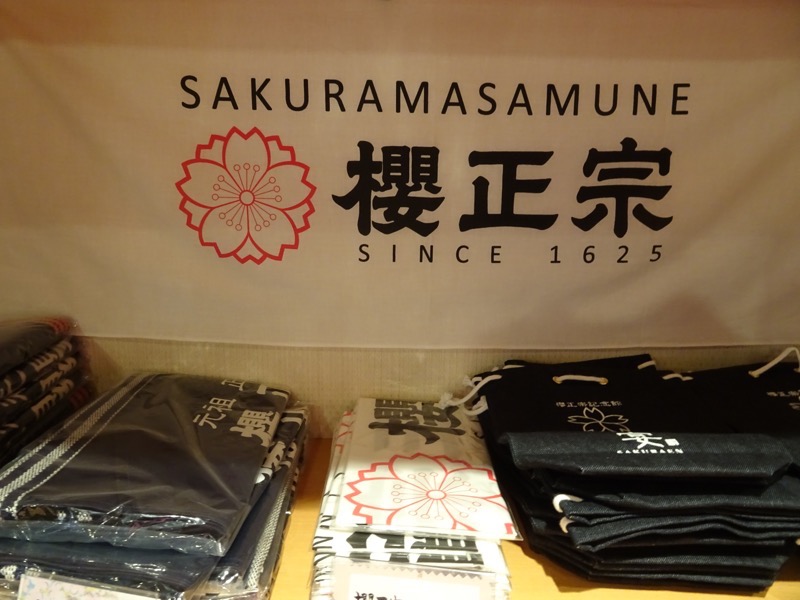 With so much really good saké on offer, we decided we had better restrict ourselves to small bottles that we could consume during the week only. 🙂
With so much really good saké on offer, we decided we had better restrict ourselves to small bottles that we could consume during the week only. 🙂 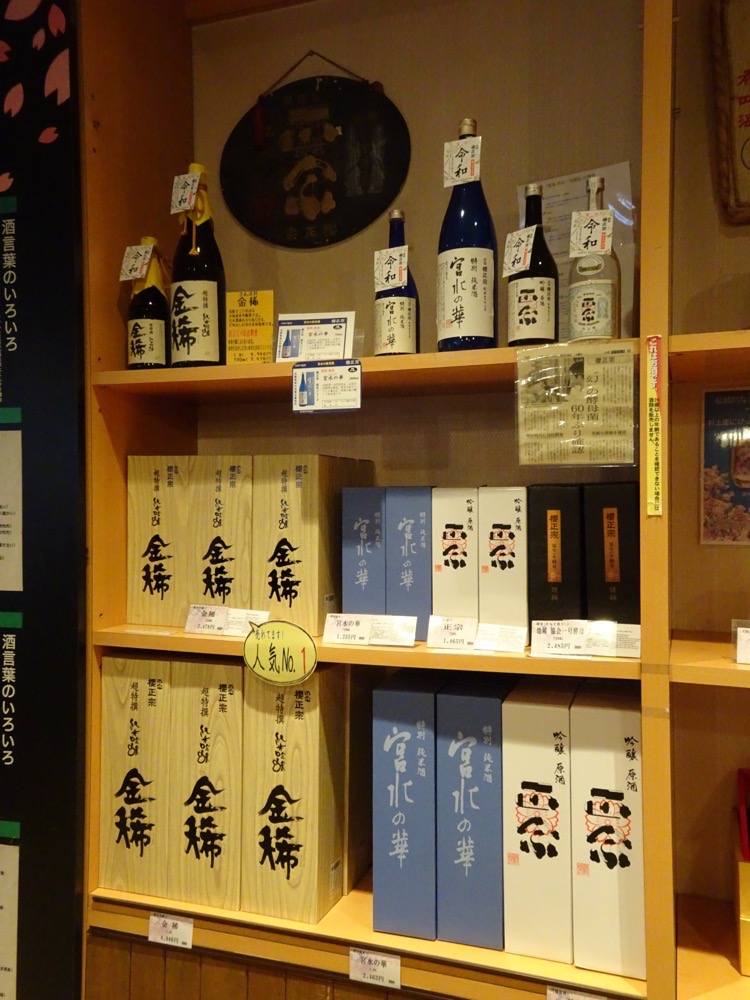

Next on our walking tour was literally just around the corner – the Hamafukutsuru (say that three times really fast!) Brewery.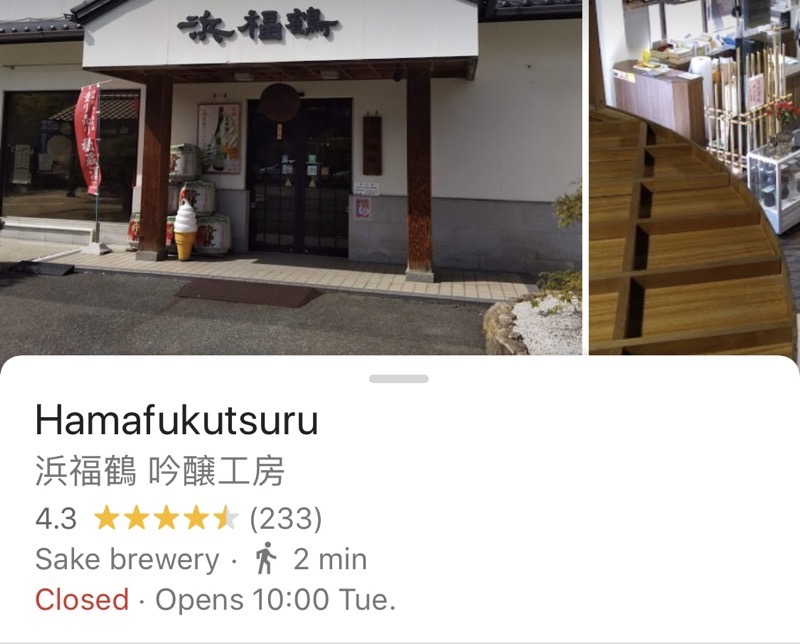
The Hamafukutsuru brewery started in the early Meiji period (around 1900), and has faced numerous challenges to still be in production today. The brewery was consolidated with a larger company during the national industrial reorganization program resulting from the WW2, and they suffered through the Great Hanshin-Awaji Earthquake in 1995, which totally destroyed the brewery’s buildings. The continuing existence of the brewery is apparently the result of the combined efforts of the local community who helped to restore the brewery. Now the site shows visitors the modern sake-making process, and is known as “Hama Fukutsuru Ginjo Kobo.”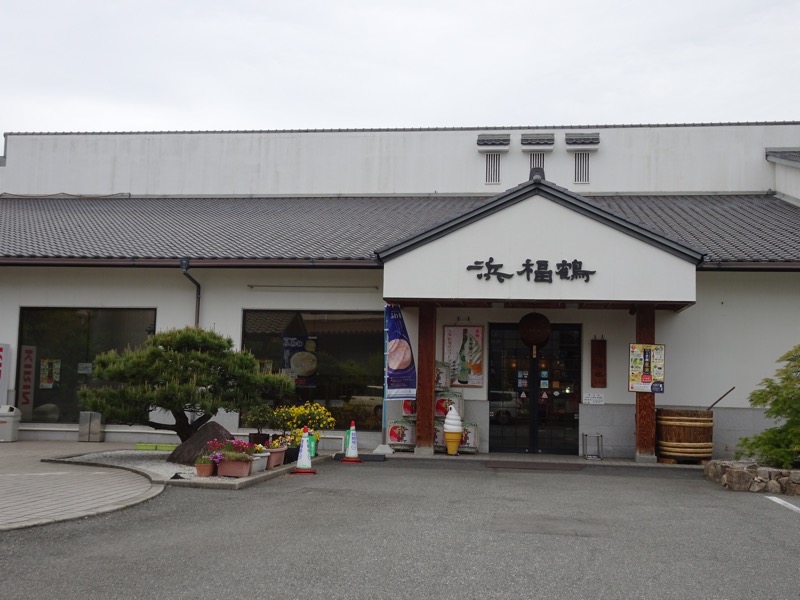
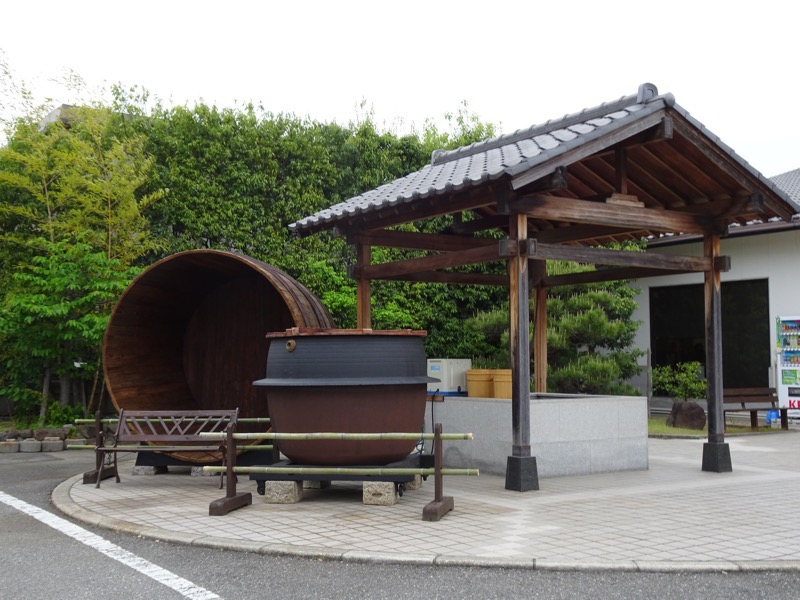
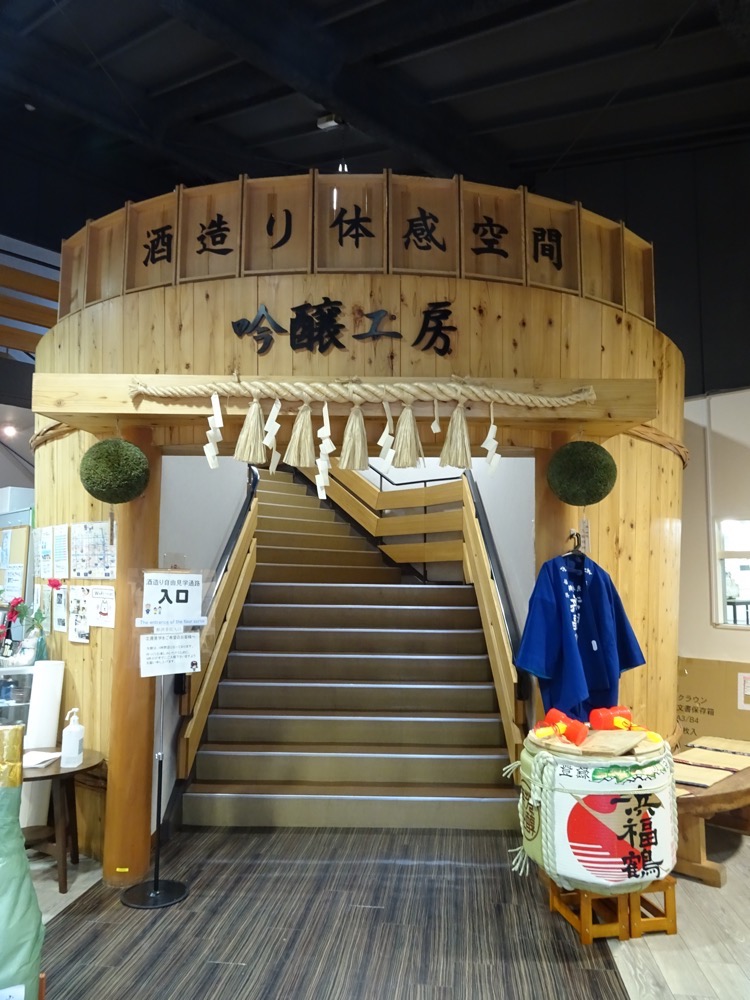
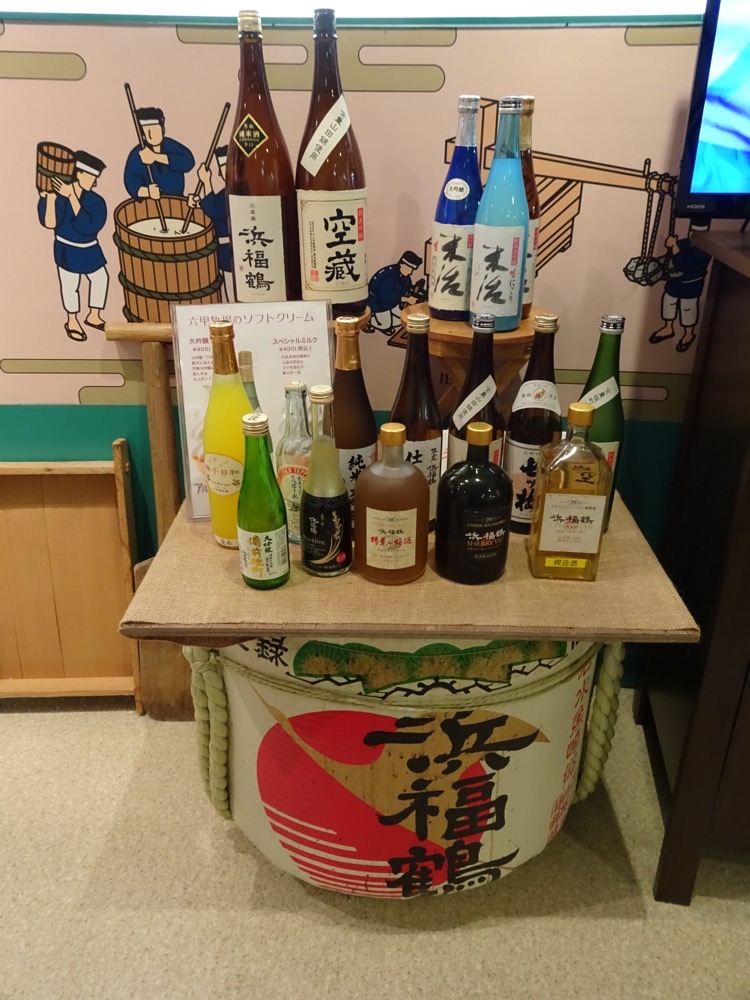
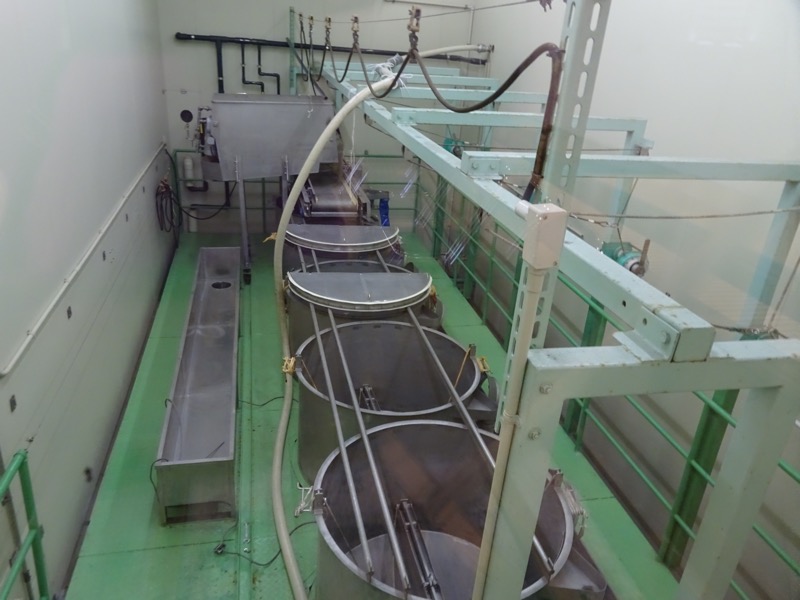 Rice grains all polished down to about 50%.
Rice grains all polished down to about 50%.

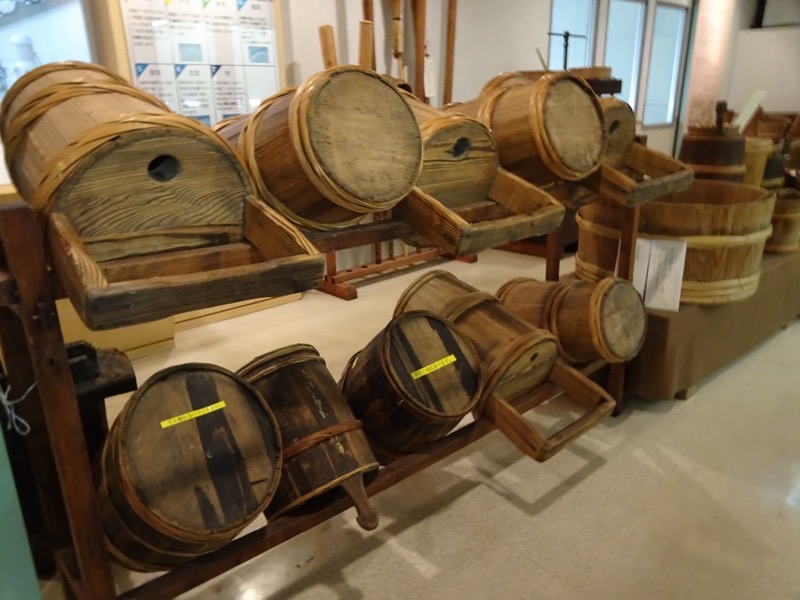
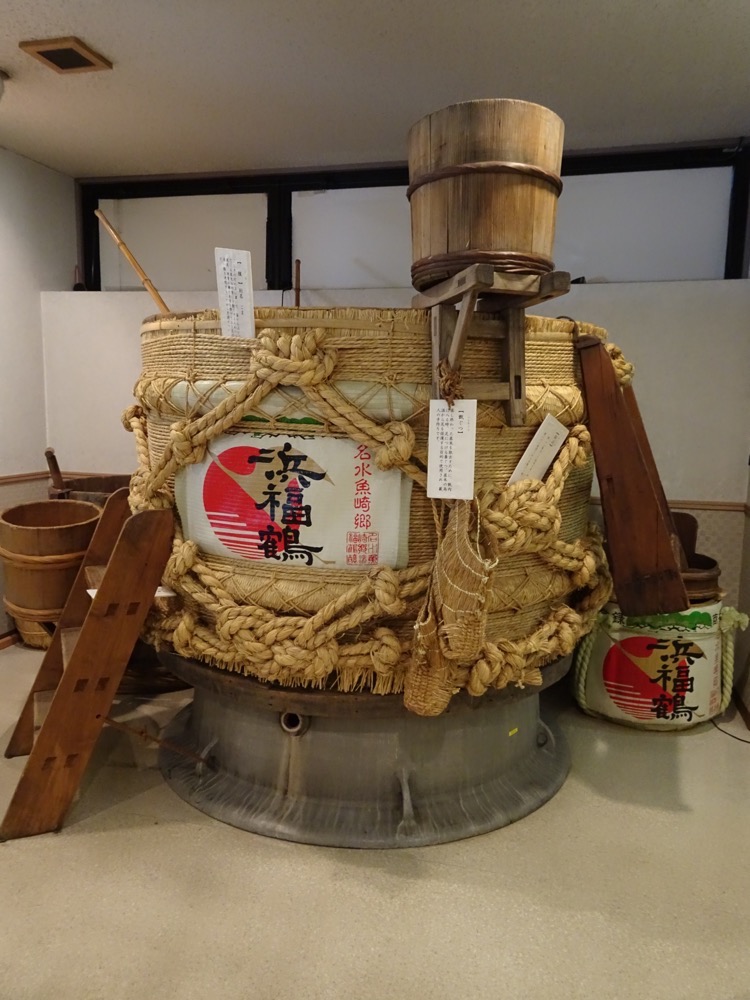


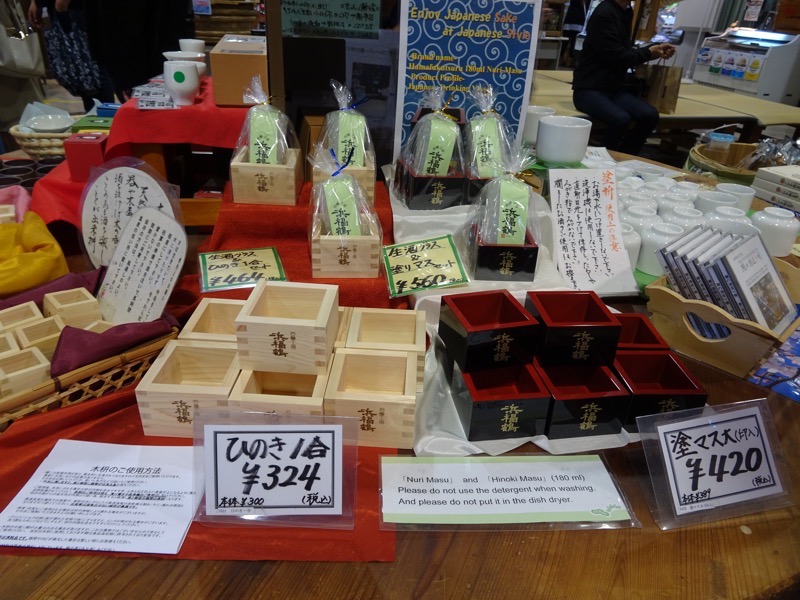 Fugu saké cups! Yoink!
Fugu saké cups! Yoink!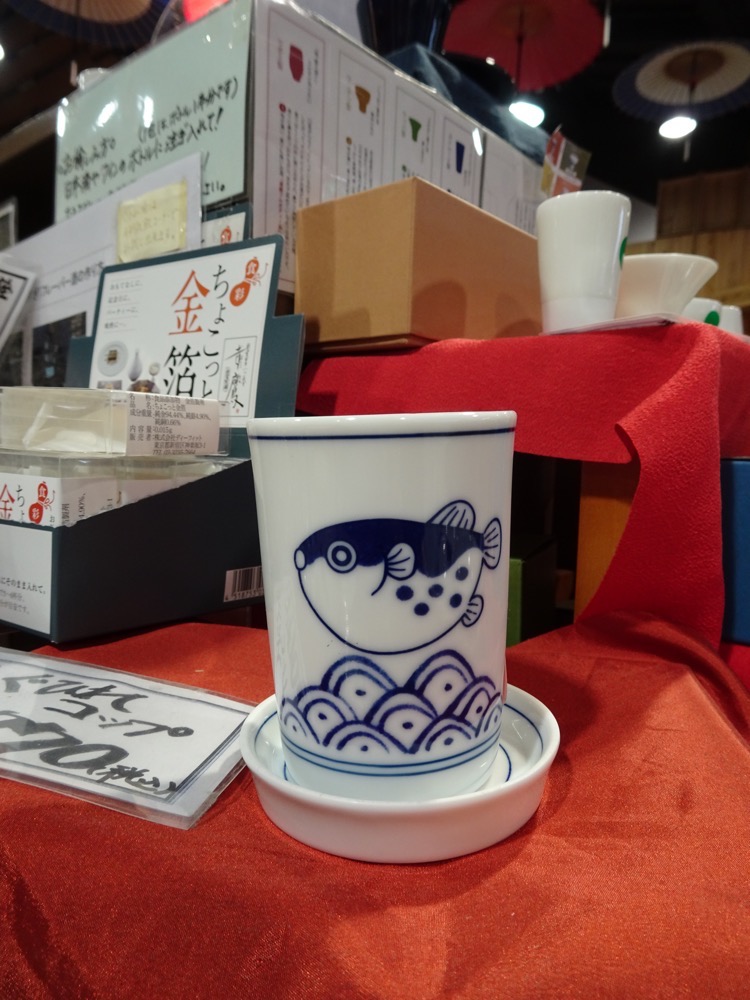
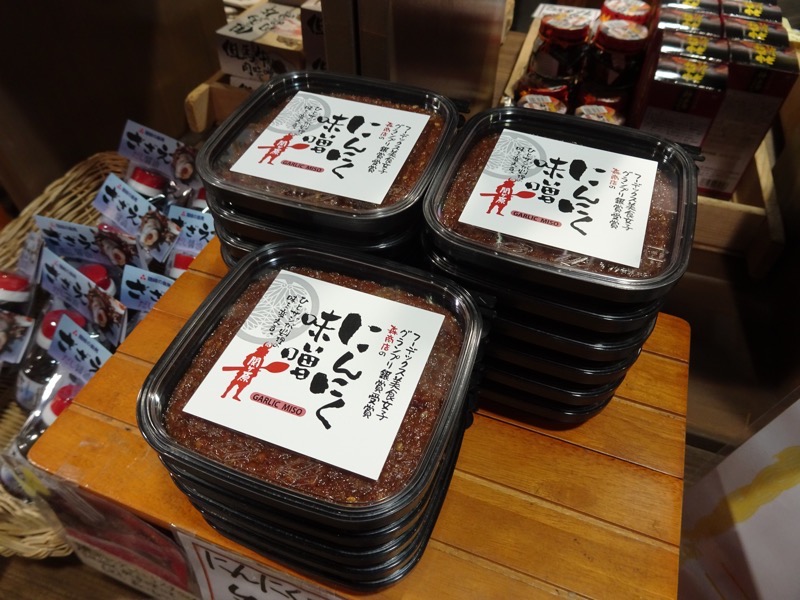 So much good saké, and so many locally made delicacies on display… Why? Oh why, have the Luggage Allowance Gods deserted me on this trip?
So much good saké, and so many locally made delicacies on display… Why? Oh why, have the Luggage Allowance Gods deserted me on this trip?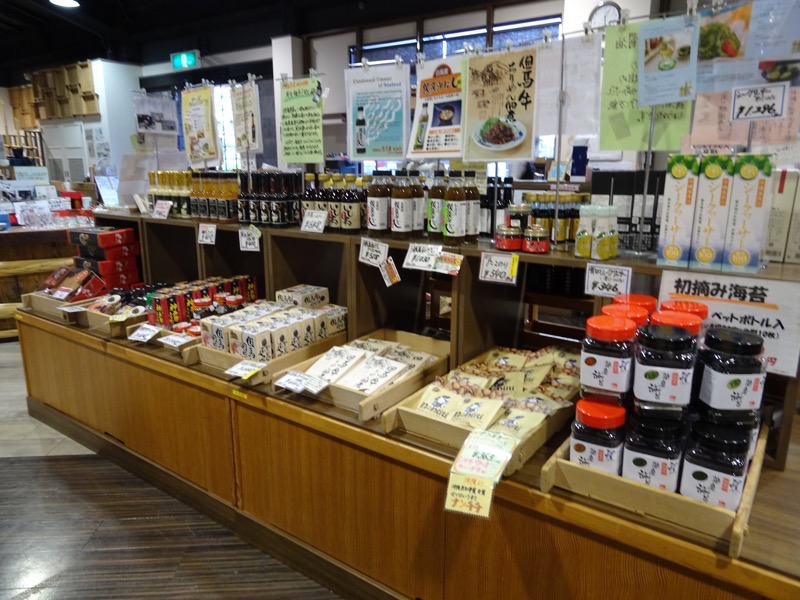
A few hundred meters down the road was the Kikumasamune Saké Brewery and Museum… it felt a lot further than it was by this point – perhaps something to do with all the sampling on an empty stomach! I have to admit to being pretty excited to be here – these guys make my favourite Kikumasamune Taru Saké, which I like to buy back home, and it is top of my list of, ‘things to do’ while we were in Osaka. 🙂 
The Kikumasamune Sake Brewery was constructed on the site of the principal residence of the head Kano family who started the brewery in 1659. The building was relocated to its current site in the 1960s for preservation purposes and opened to the general public as a museum.
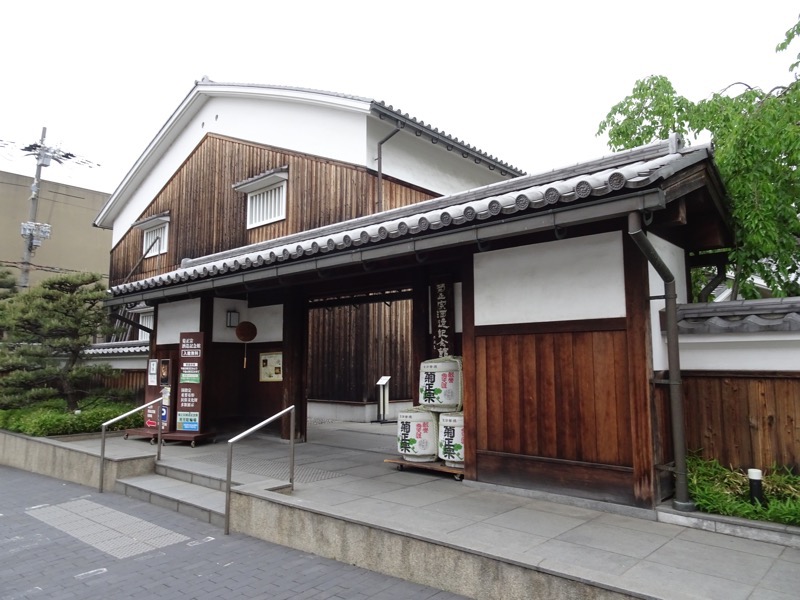 The museum exhibited items that have been designated as important tangible cultural property by the national government under the name of “Nada-based Sake Brewery’s Equipment,” policy, and as a museum, it demonstrates the history of sake brewing for contemporary audiences. About 50,000 people visit the museum each year.
The museum exhibited items that have been designated as important tangible cultural property by the national government under the name of “Nada-based Sake Brewery’s Equipment,” policy, and as a museum, it demonstrates the history of sake brewing for contemporary audiences. About 50,000 people visit the museum each year.
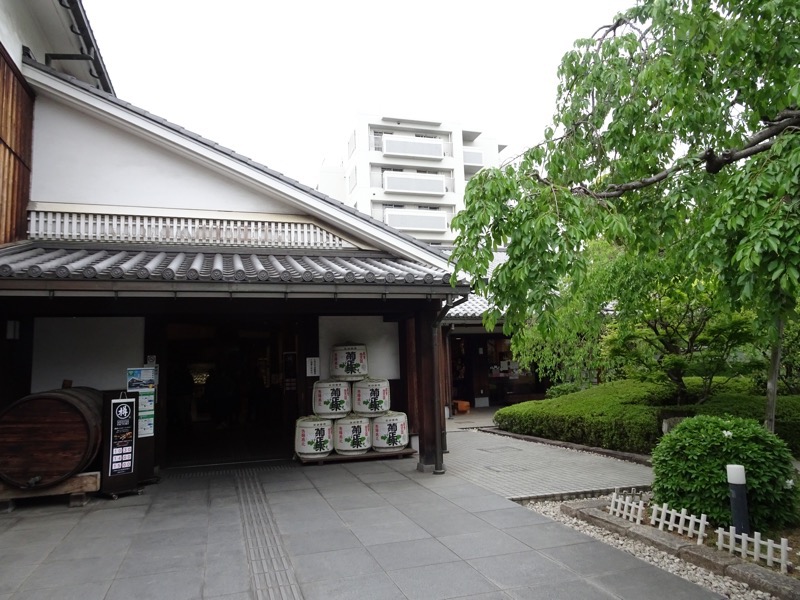
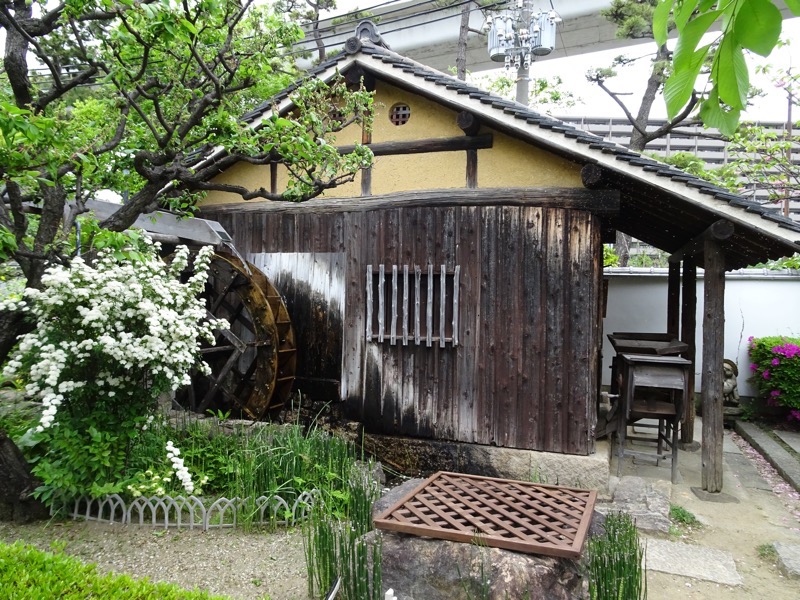

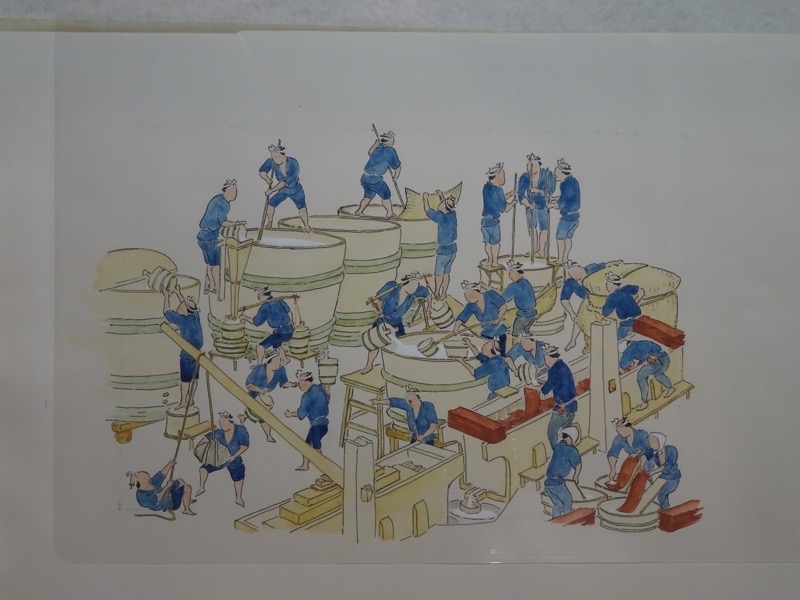
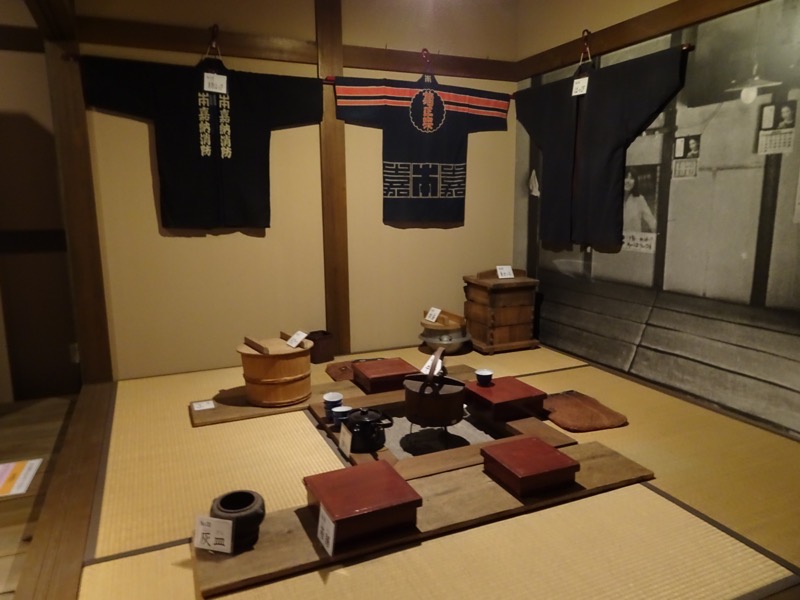 In January 1995, this brewery museum was also destroyed by the Great Hanshin Earthquake, but thankfully almost every single piece of sake brewery equipment and all the small tools were retrieved carefully by hand and found to be mostly undamaged or restorable-so the objects in the museum are all extant items in their original condition.
In January 1995, this brewery museum was also destroyed by the Great Hanshin Earthquake, but thankfully almost every single piece of sake brewery equipment and all the small tools were retrieved carefully by hand and found to be mostly undamaged or restorable-so the objects in the museum are all extant items in their original condition.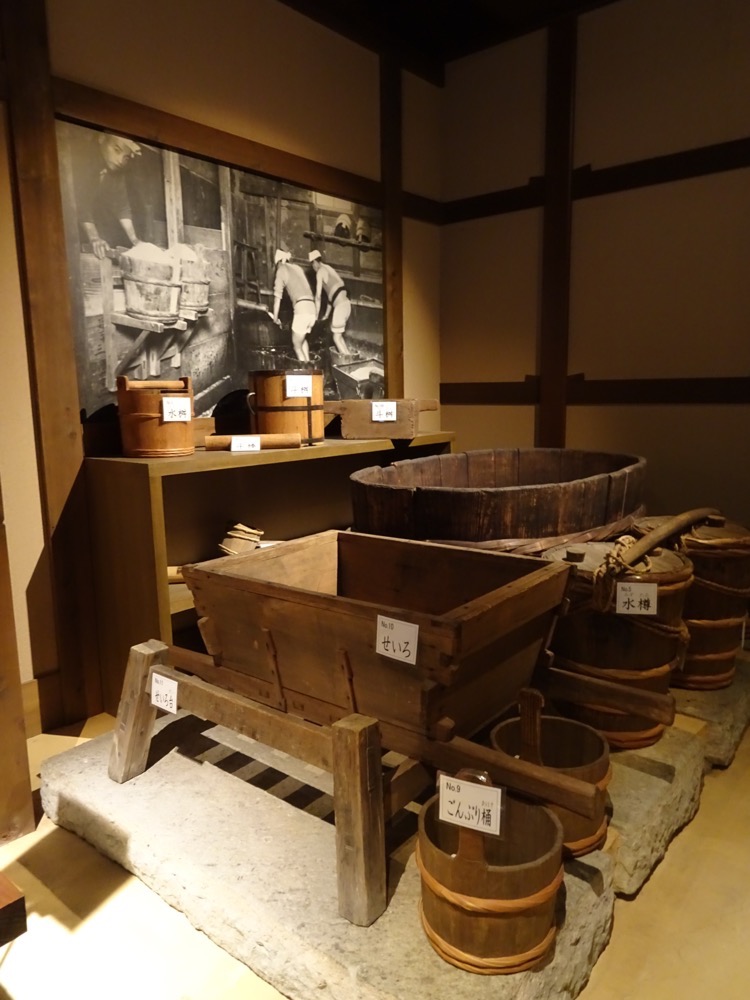

After extensive reconstruction, the museum was reopened four years later… unbelievable that it took only four years to rebuild the two-story museum building, and it is now a fire-resistant and anti-earthquake structure. It still has the appearance of a traditional brewery, with the roofs tiled in the long-established hongawarabuki style, and the outer walls and street fences are paneled with charred cedar boards. Inside you can see many reused pillars and beams dating back to 400 years ago, which were used from the former museum. 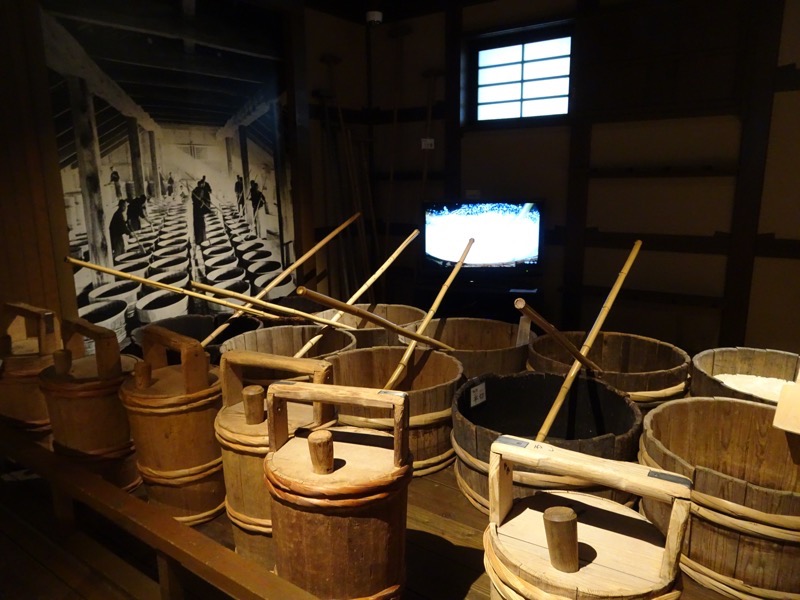

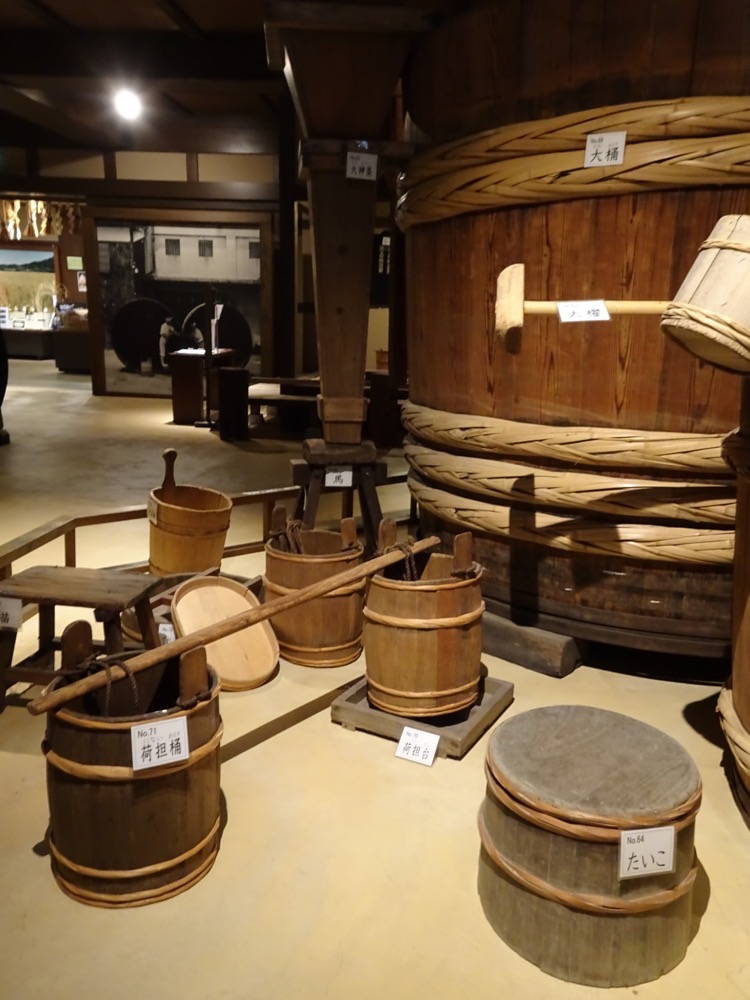

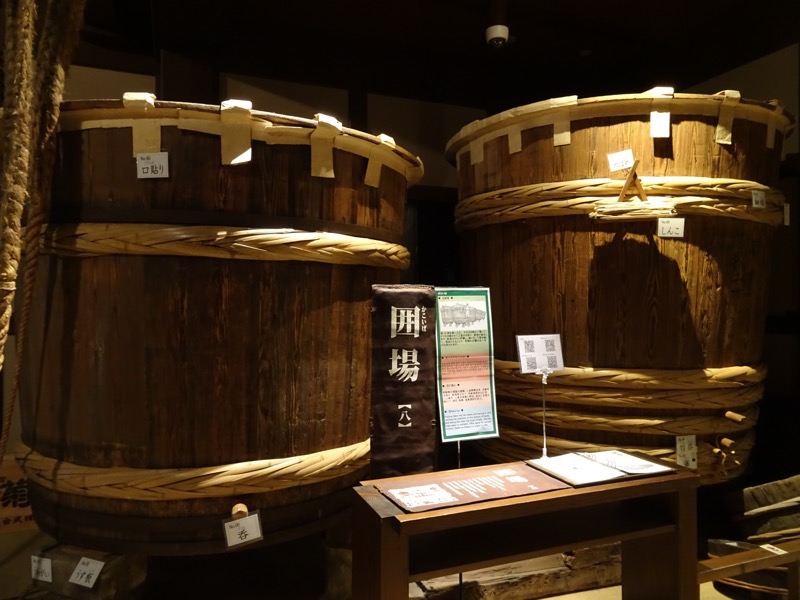 There are ‘Culturally Important Objects’ housed upstairs – but gorgeous as these little sake cups are, I couldn’t read any of the descriptions accompanying them, nor could I understand the little video that was nearby. So I feel like I missed something here…
There are ‘Culturally Important Objects’ housed upstairs – but gorgeous as these little sake cups are, I couldn’t read any of the descriptions accompanying them, nor could I understand the little video that was nearby. So I feel like I missed something here… 
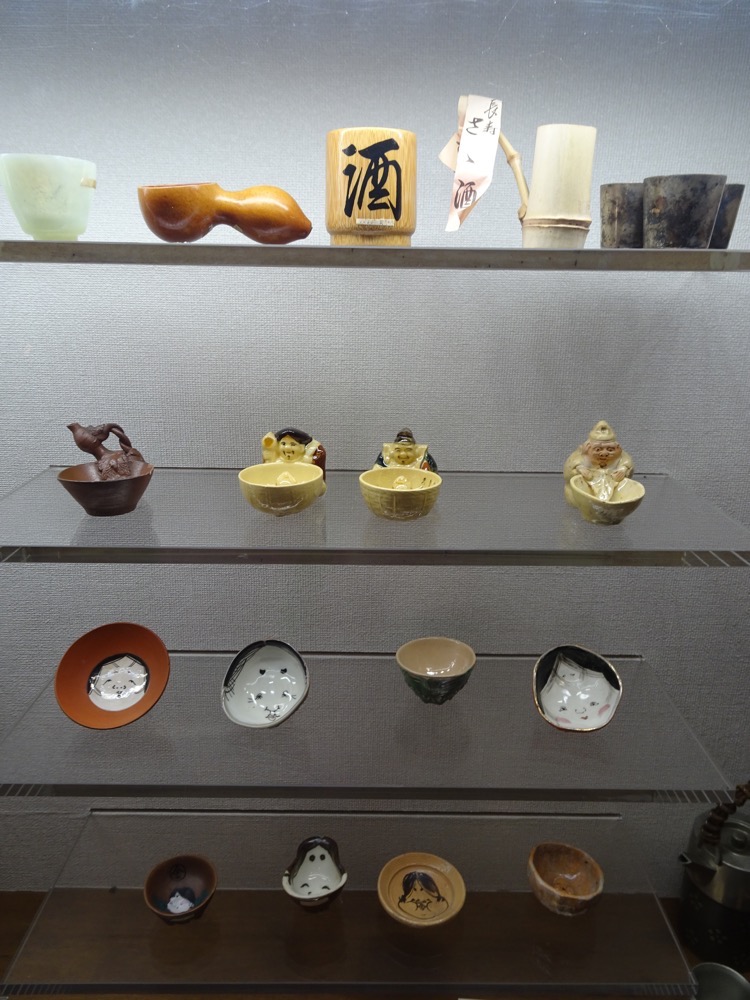 Downstairs, the tastings continued, as did the shopping!
Downstairs, the tastings continued, as did the shopping!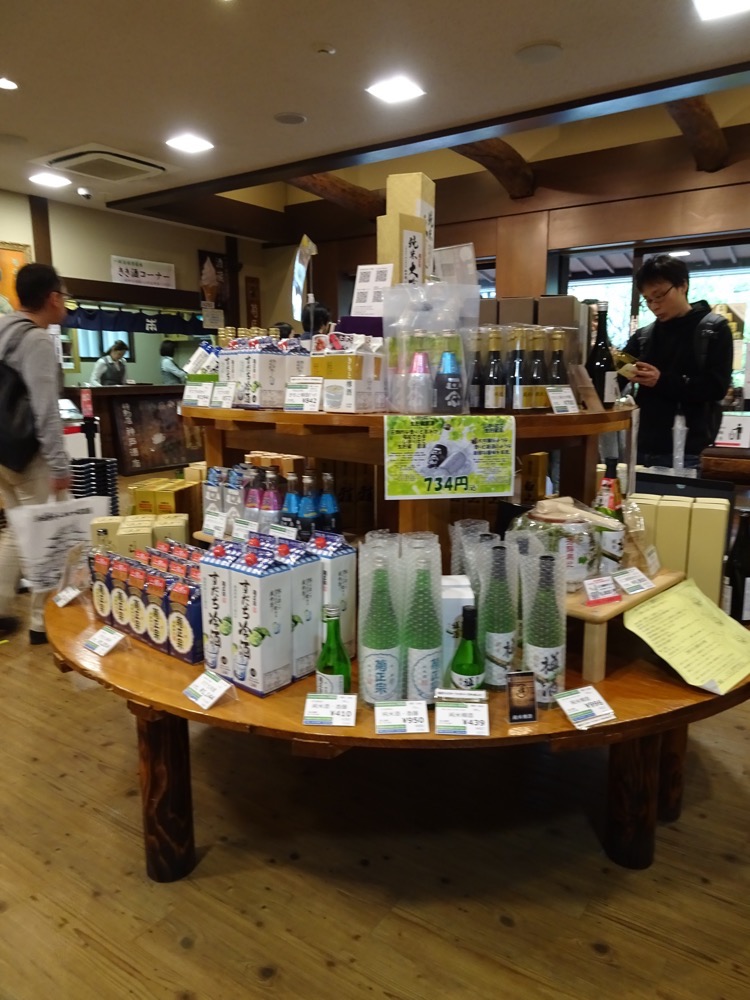 This is one of my favourite sakes to drink back home, it’s light and crisp, and a little on the dry side. I found a supplier (Fuji-Mart in Buranda), and we keep a bottle in the fridge. I’d like to say ‘for special occasions’, but that only works if Tuesday night sushi counts as a special occasion.
This is one of my favourite sakes to drink back home, it’s light and crisp, and a little on the dry side. I found a supplier (Fuji-Mart in Buranda), and we keep a bottle in the fridge. I’d like to say ‘for special occasions’, but that only works if Tuesday night sushi counts as a special occasion. 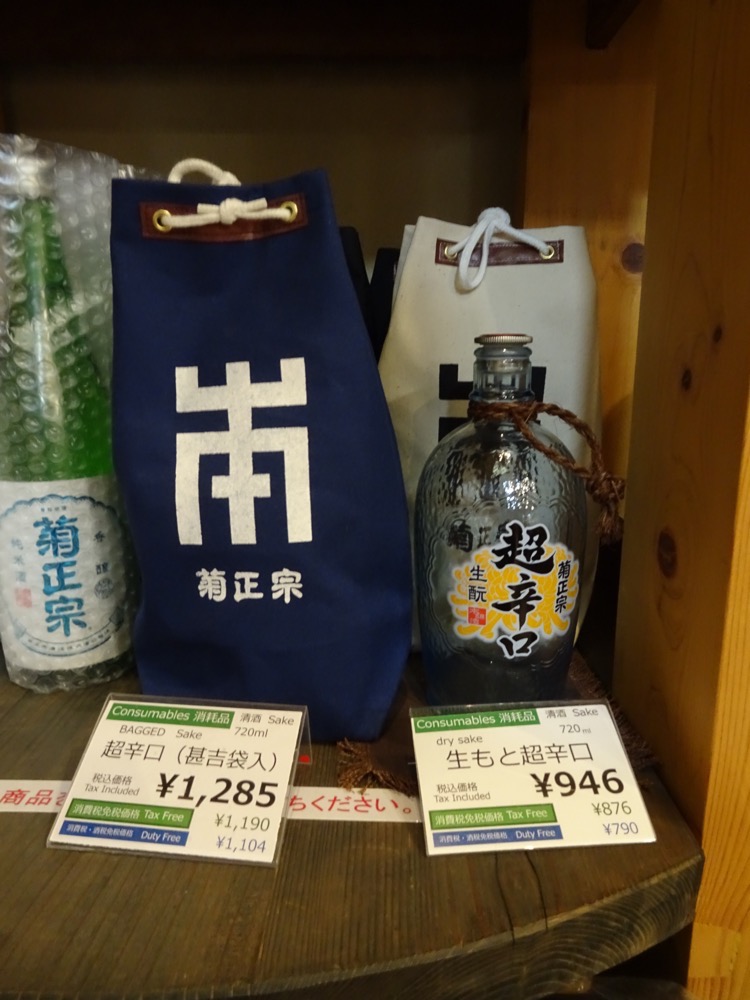 I don’t even mind that it’s half the price here that it is at home – I’m just glad we can get it.
I don’t even mind that it’s half the price here that it is at home – I’m just glad we can get it. 
 Not sure if this is a fat happy otter or what?
Not sure if this is a fat happy otter or what?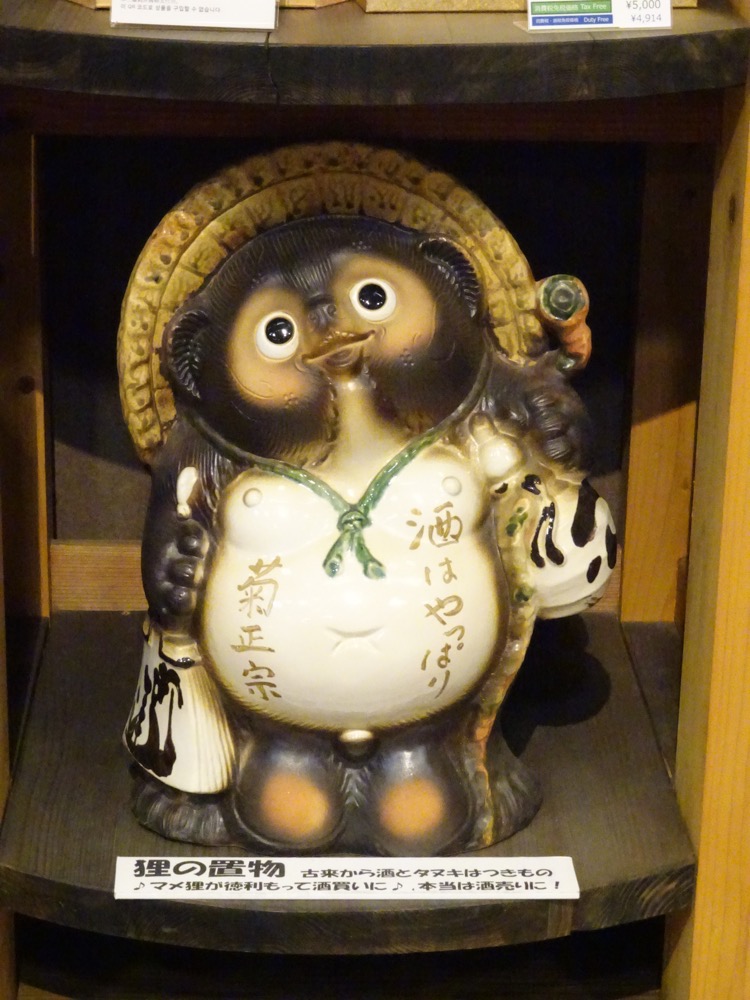
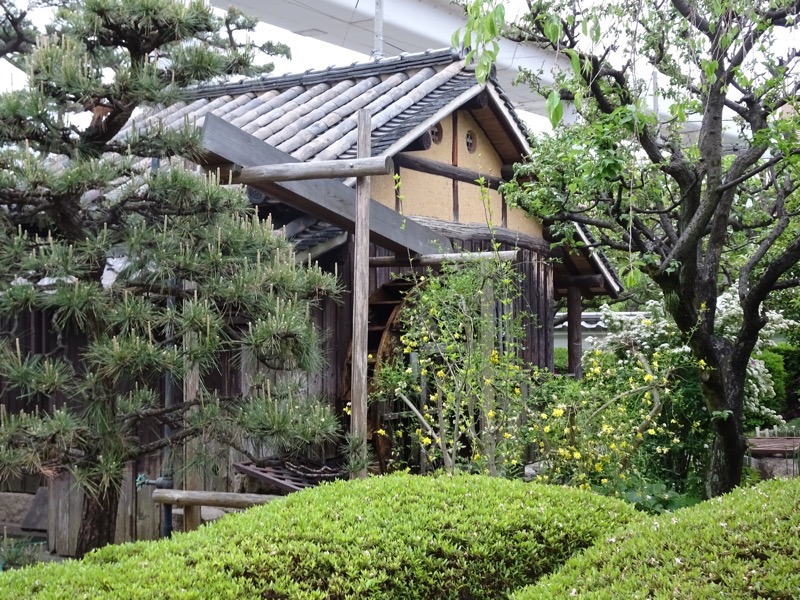
 The next brewery was about 600m away and we were perambulating somewhat slower now! 😛 The Hakutsuru Saké Brewery Museum is *the* saké museum that visitors will come to if they are only seeing one or are on an organised tour. It is the largest of the brewery museums and has an extensive and well laid out tour.
The next brewery was about 600m away and we were perambulating somewhat slower now! 😛 The Hakutsuru Saké Brewery Museum is *the* saké museum that visitors will come to if they are only seeing one or are on an organised tour. It is the largest of the brewery museums and has an extensive and well laid out tour.
 Founded in1743, the Hakutsuru Saké Brewing Co takes their obligation to continue to contribute to the culture and diets of the Japanese people very seriously. Their toji master brewers continue to carry forward traditional brewing processes while continuing to experiment to meet the needs of a diverse population’s desire for novelty.
Founded in1743, the Hakutsuru Saké Brewing Co takes their obligation to continue to contribute to the culture and diets of the Japanese people very seriously. Their toji master brewers continue to carry forward traditional brewing processes while continuing to experiment to meet the needs of a diverse population’s desire for novelty. 
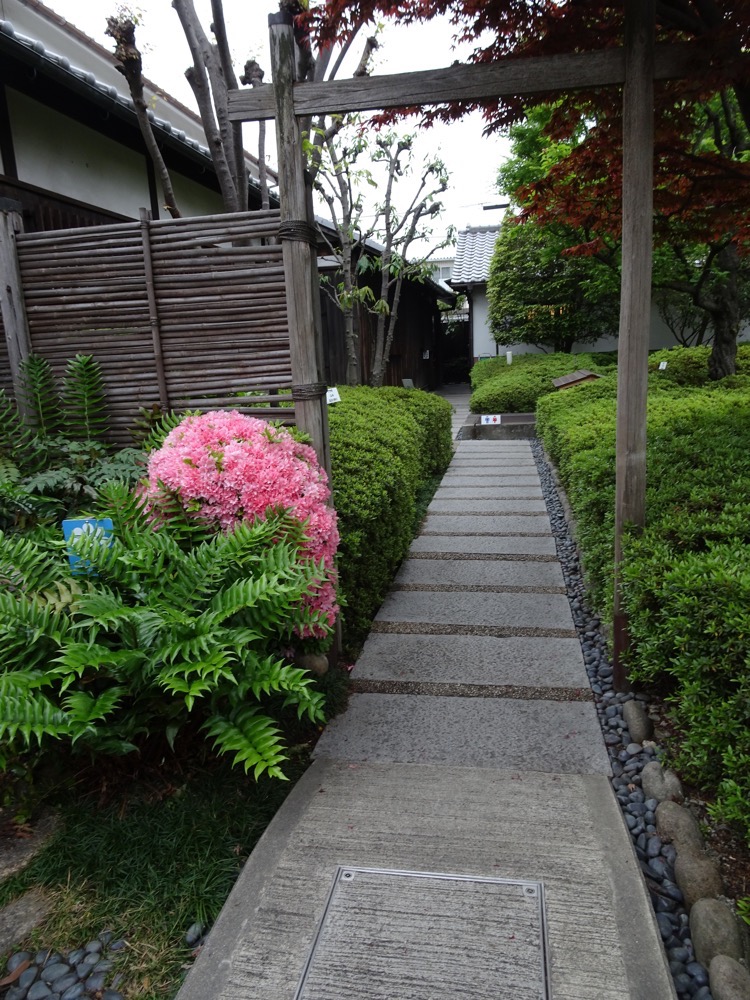 The museum has a very well laid out tour showing traditional brewing processes.
The museum has a very well laid out tour showing traditional brewing processes.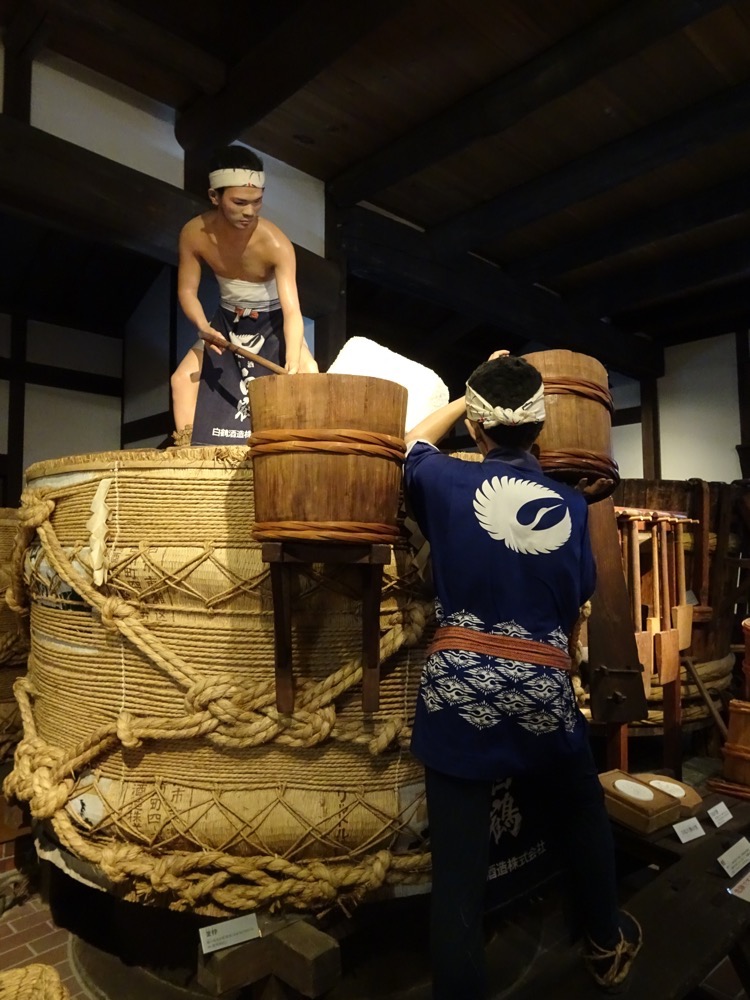
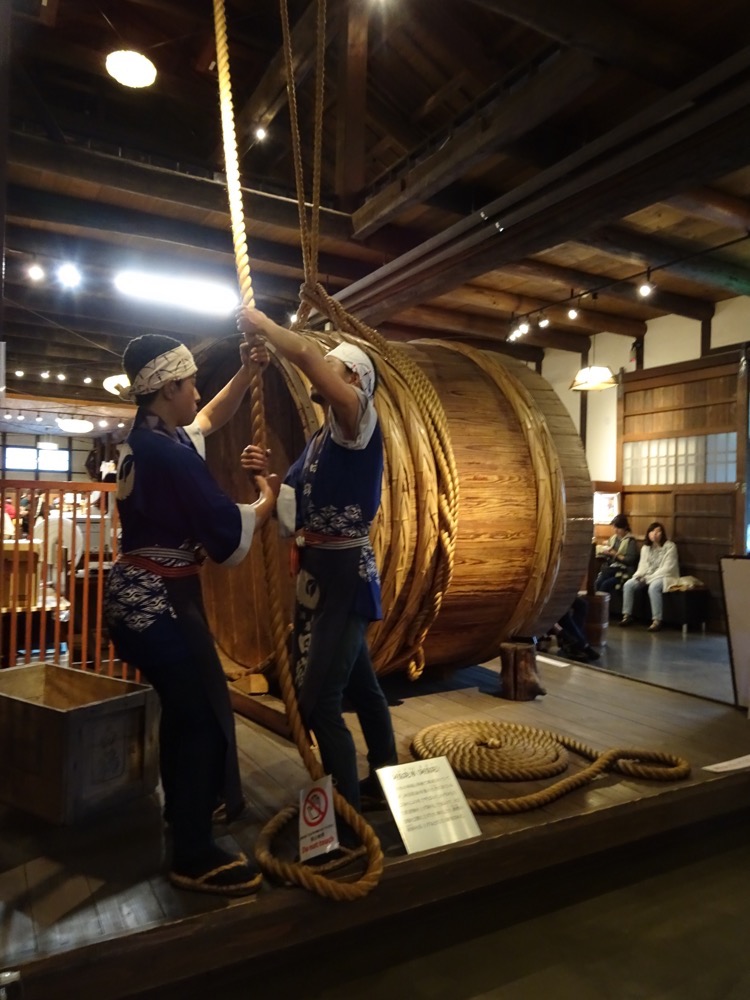
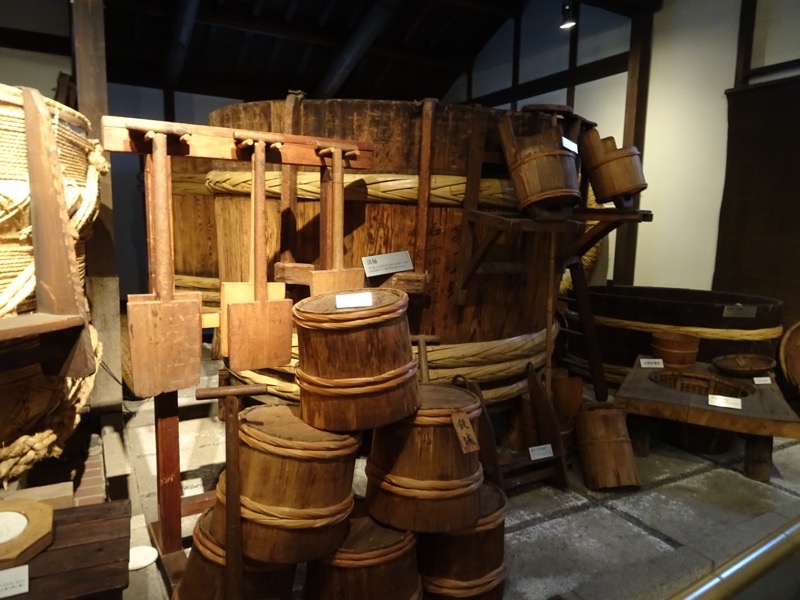
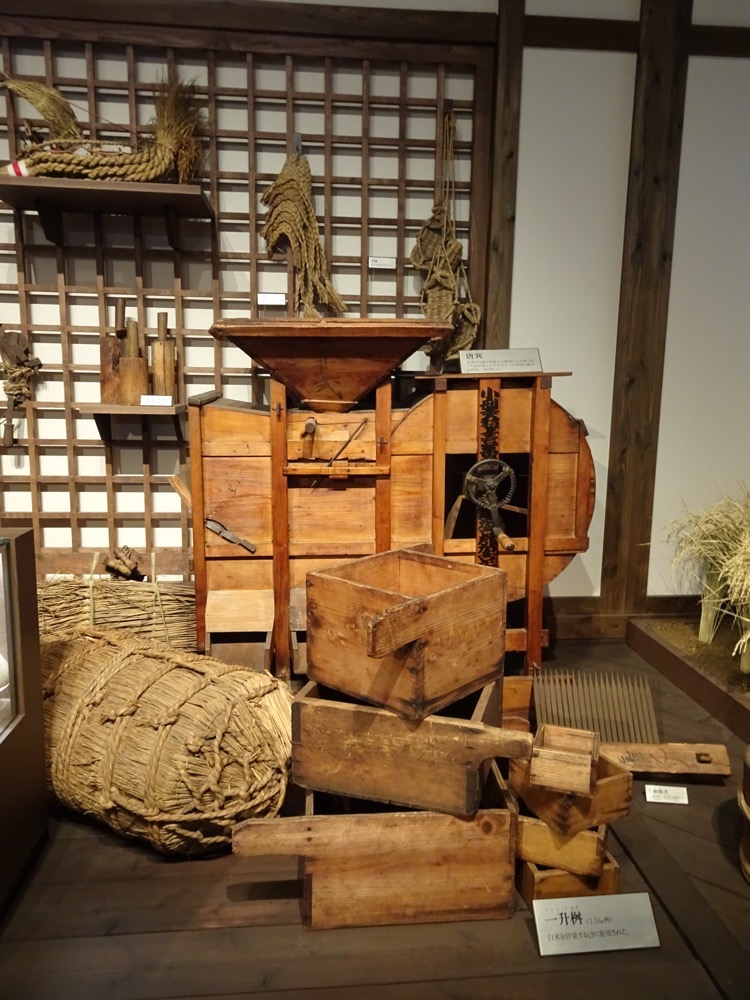
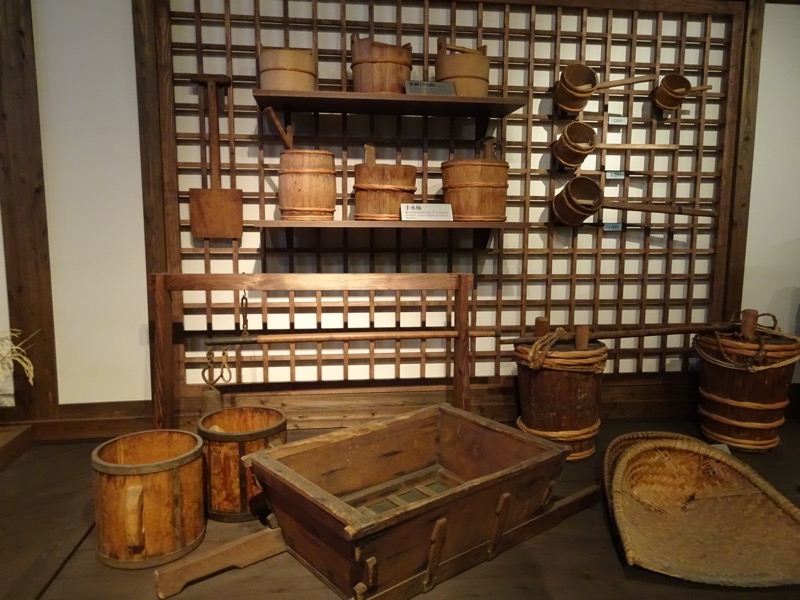




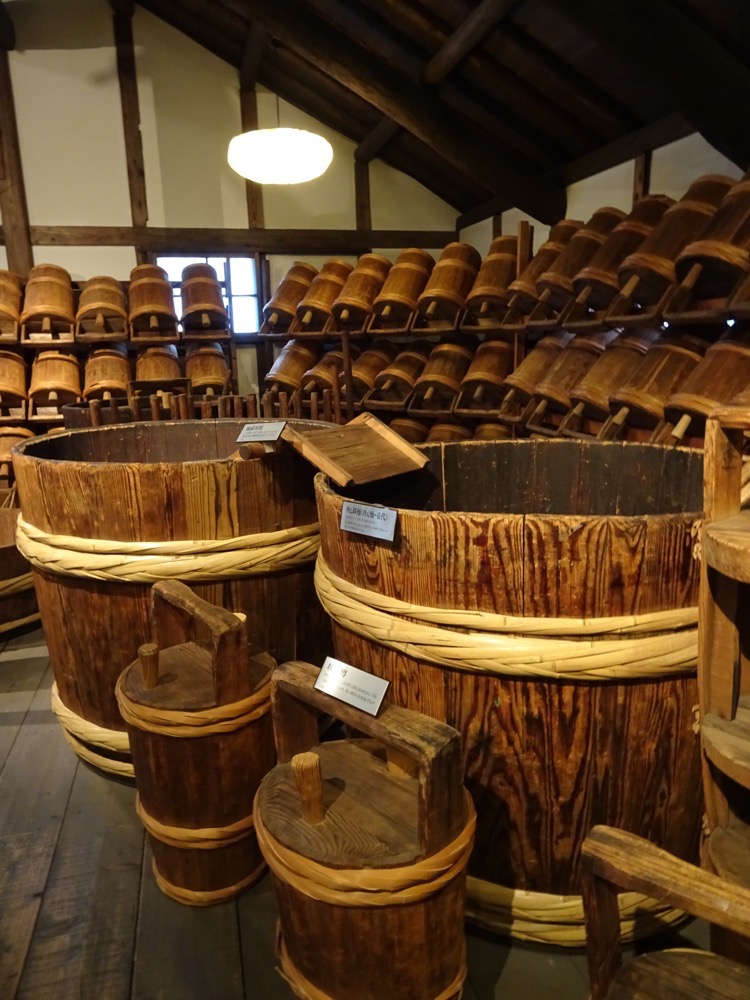

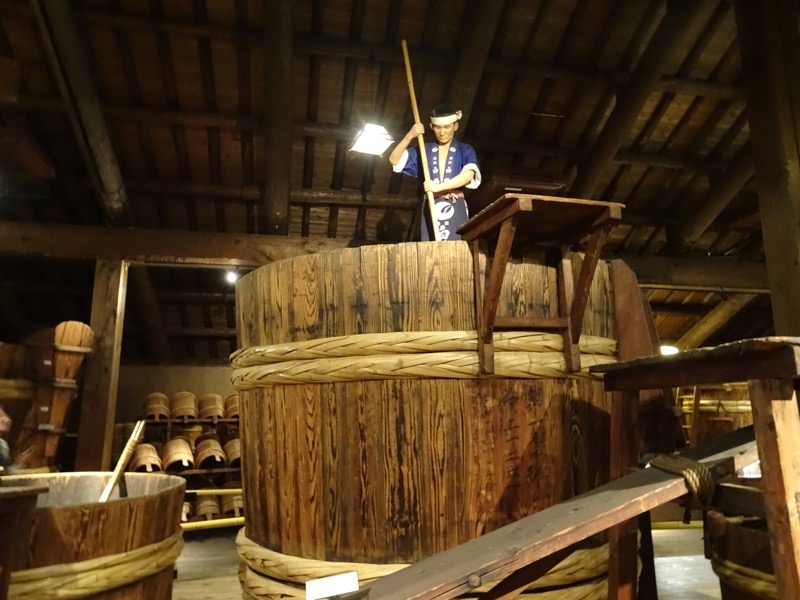
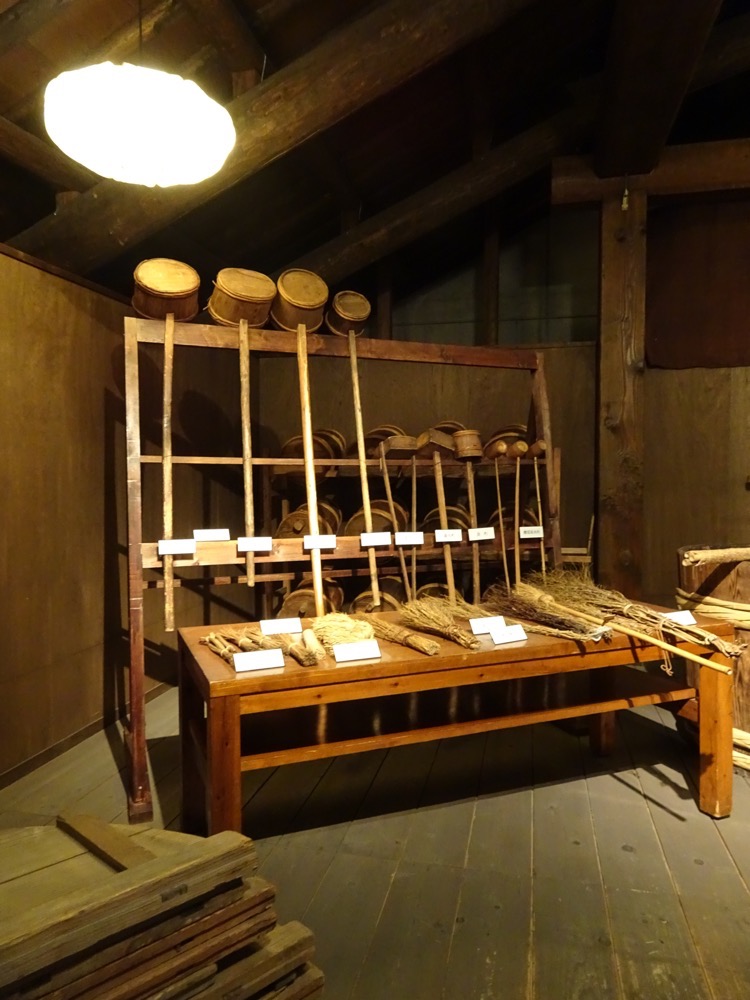
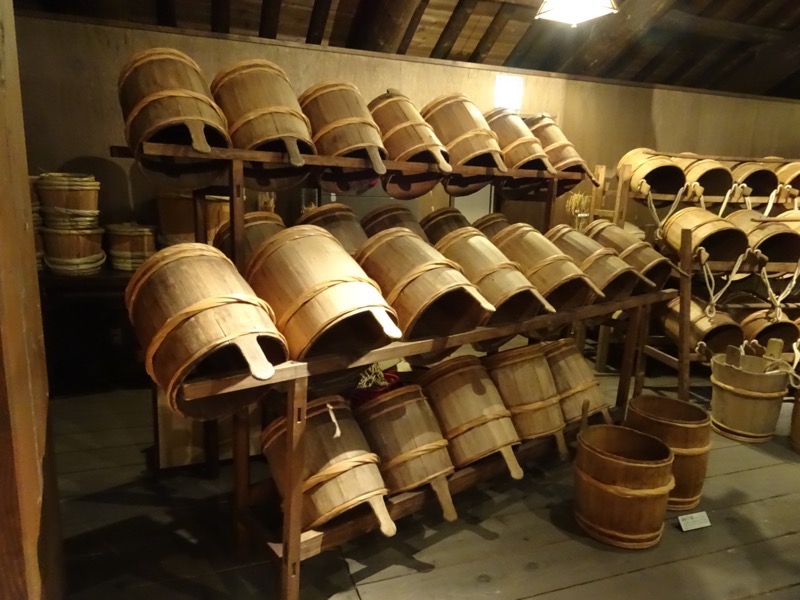
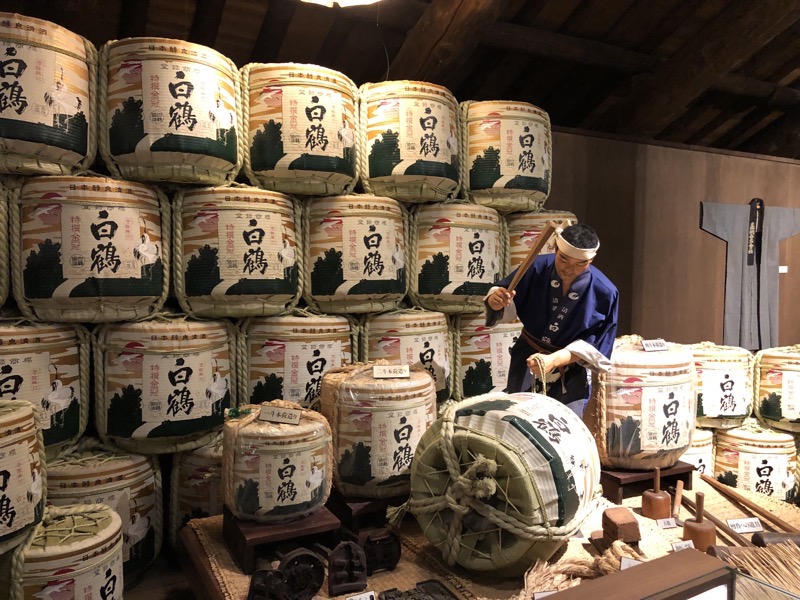 This place is seriously cool – and had many displays that could be seen/heard in English as well. It is obviously set up for the international visitors that tend to come in tour groups…complete with bus parking outside.
This place is seriously cool – and had many displays that could be seen/heard in English as well. It is obviously set up for the international visitors that tend to come in tour groups…complete with bus parking outside.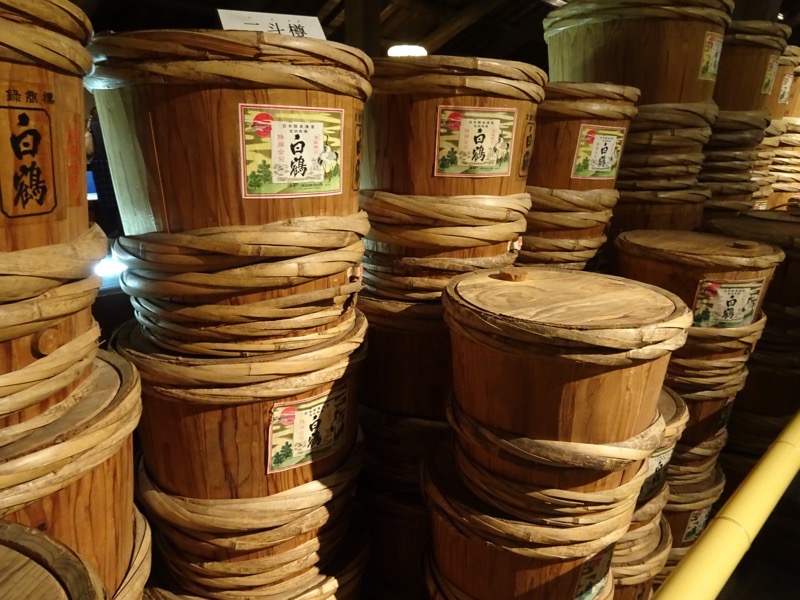


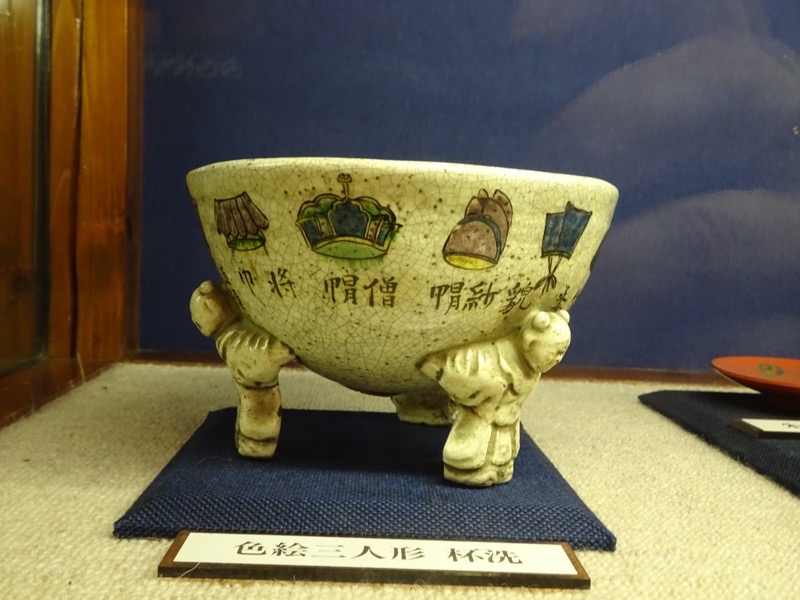

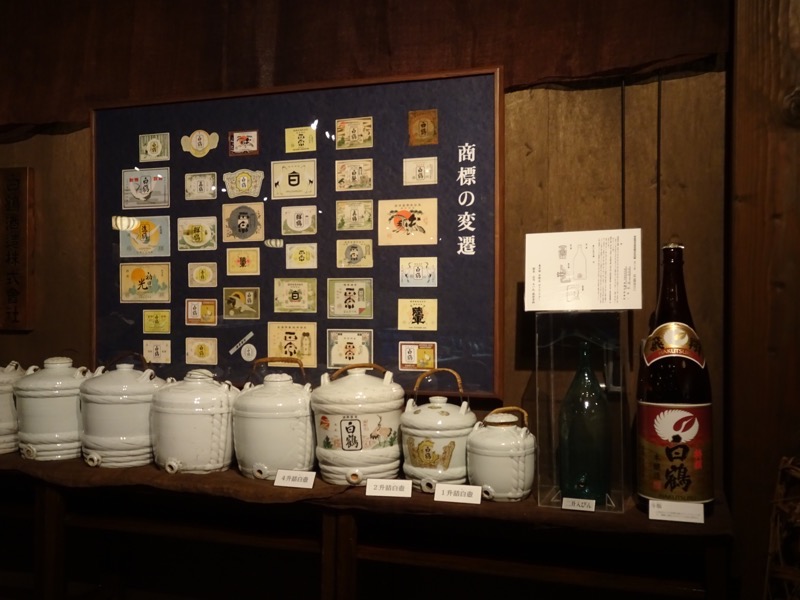
 An advertising poster for the Hakutsuru Sake from the 1950s…it’s subtle, but the crane motif associated with their product is evident on the maiko’s kimono.
An advertising poster for the Hakutsuru Sake from the 1950s…it’s subtle, but the crane motif associated with their product is evident on the maiko’s kimono. Their famous cellar door Junmai… only available on site.
Their famous cellar door Junmai… only available on site.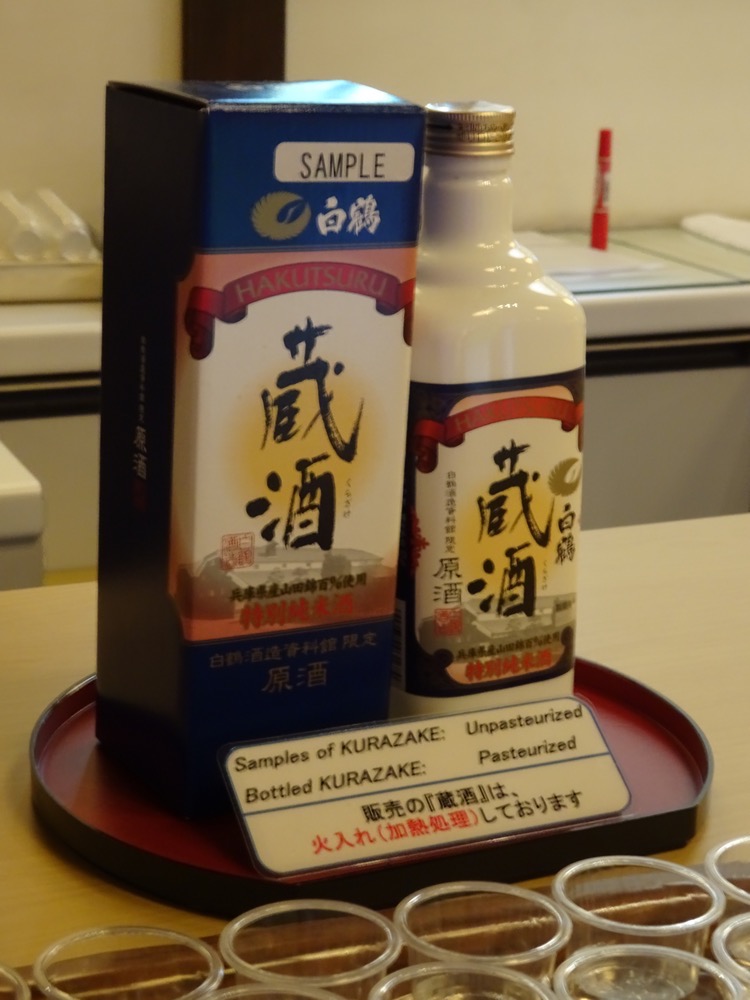

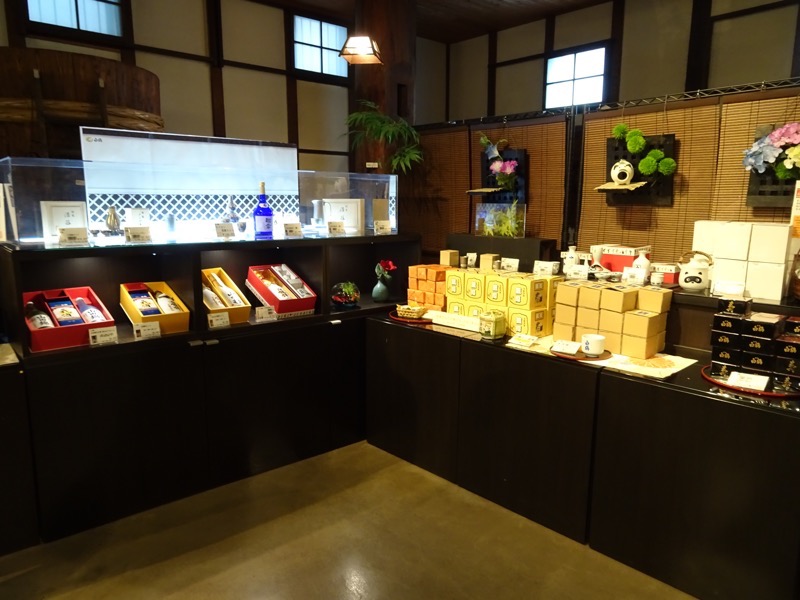
 This little robot will assist you in pairing the right saké to your food preferences.
This little robot will assist you in pairing the right saké to your food preferences.
 Mr K sampling the saké flavoured ice cream, which I have to say was delicious being not at all sweet and having a faint flavour of rice and saké. It was better than saké flavoured Kit-Kats in my opinion.
Mr K sampling the saké flavoured ice cream, which I have to say was delicious being not at all sweet and having a faint flavour of rice and saké. It was better than saké flavoured Kit-Kats in my opinion.
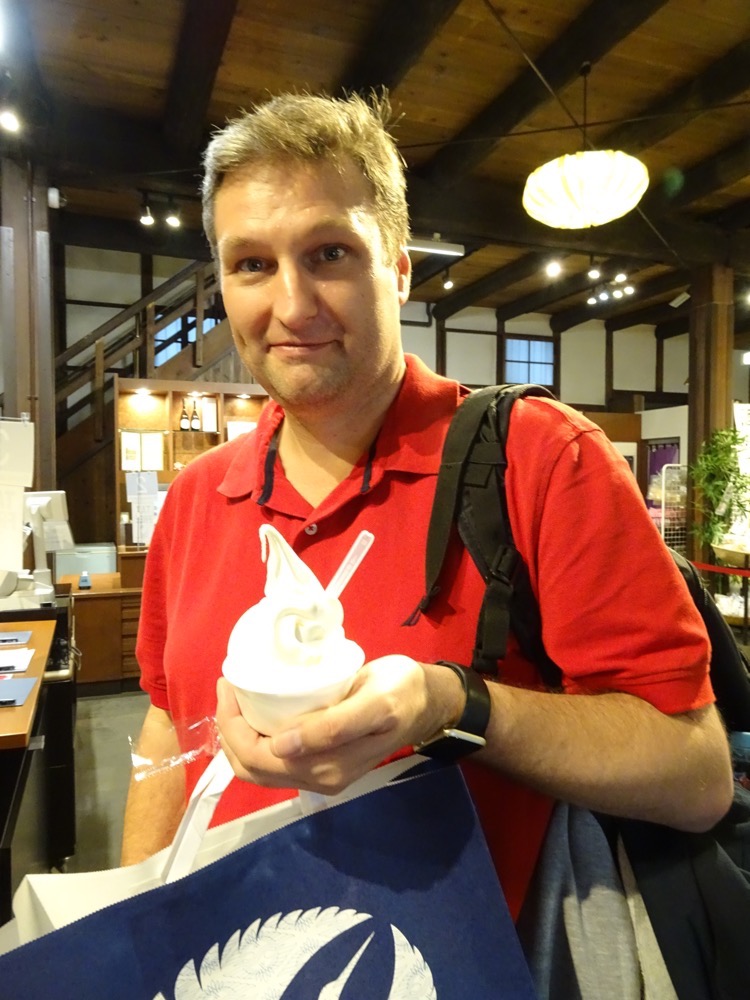
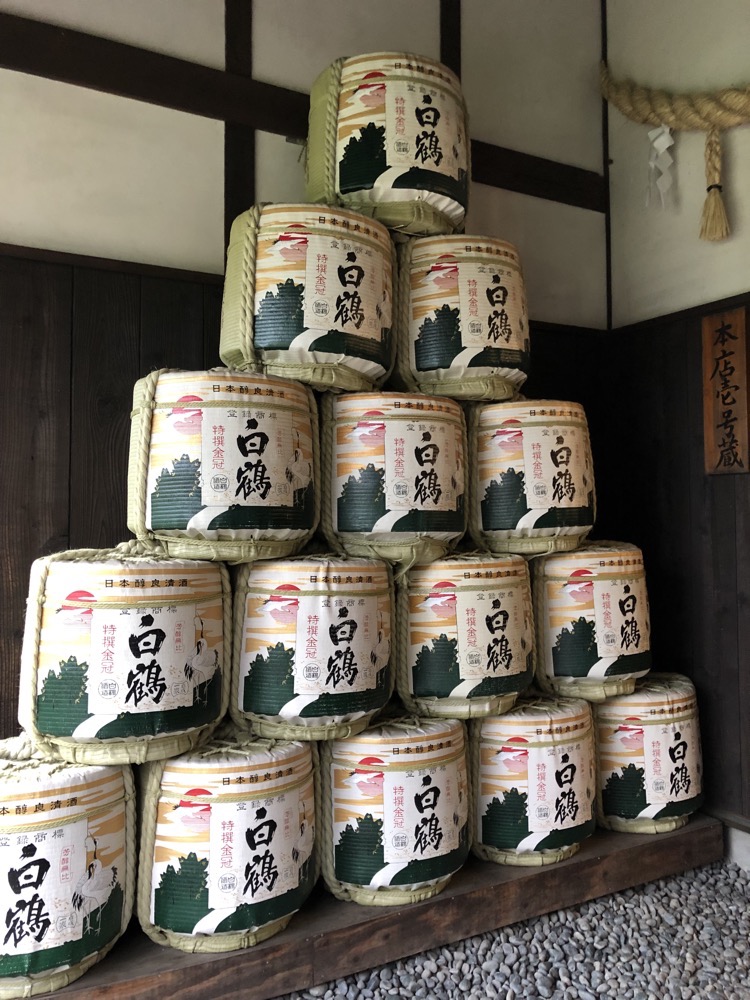
Alas, when we came outside it has started to rain, and while not very heavy, it was fairly annoying for continuing our outdoor walking tour with the next brewery about 800m away. So instead, we decided to call it an afternoon and take the train back to Namba to go find a meal in Dontonburi… which was probably the most sensible thing we could have done given we kinda skipped lunch and have been tasting all the saké, all afternoon.
We often struggle to find places to eat in Japan – I know that sounds weird, because Japan is overrun with wonderful little restaurants tucked away down tiny little alleys serving the most intricately prepared delicacies you could ever ask for – but with Mr K not being a seafood fan, and my ambivalence towards ramen and noodles, it is difficult to find places that accommodate both preferences. Most restaurants here are sushi and sashimi, OR noodles or curry. If you want a menu that carries both, you have to hunt for them, and then you tend to feel like you have stumbled into a tourist restaurant.
Anyway, we found a nice restaurant called Masu Masu in Dontonburi, which – bonus: had a no smoking policy.
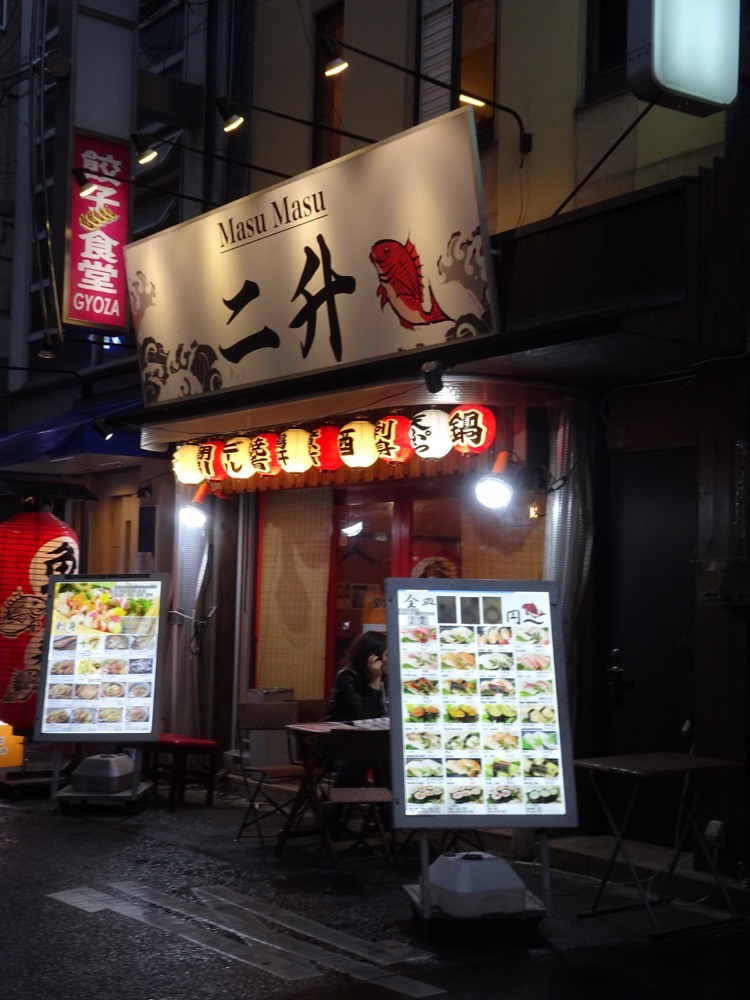
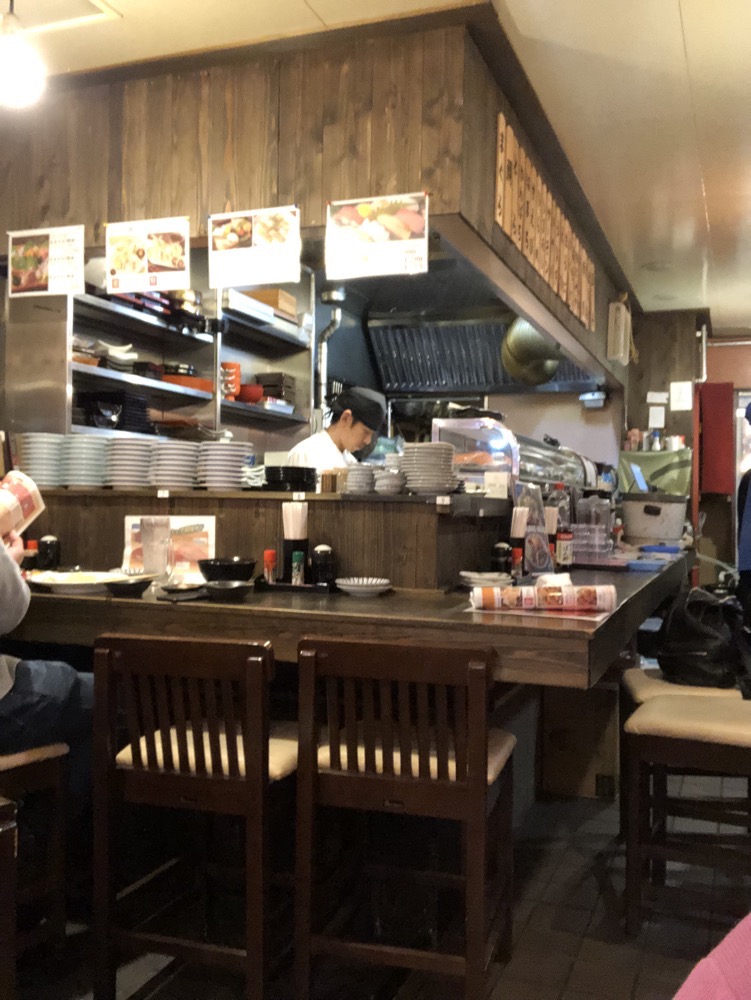
A little amuse bouche of ‘fattiest portion of tuna’ to start, followed by salmon sashimi, okonomiyaki, and a pork donburi for Mr K… oddly, after our big day of saké we opted for umeshu and beer with our meals!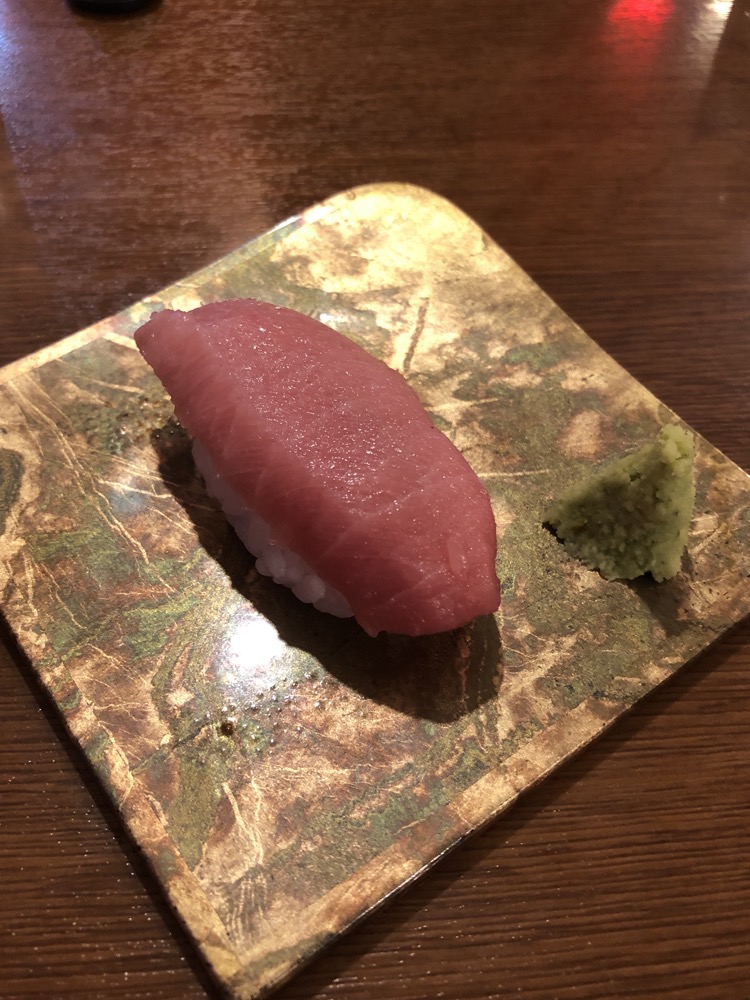

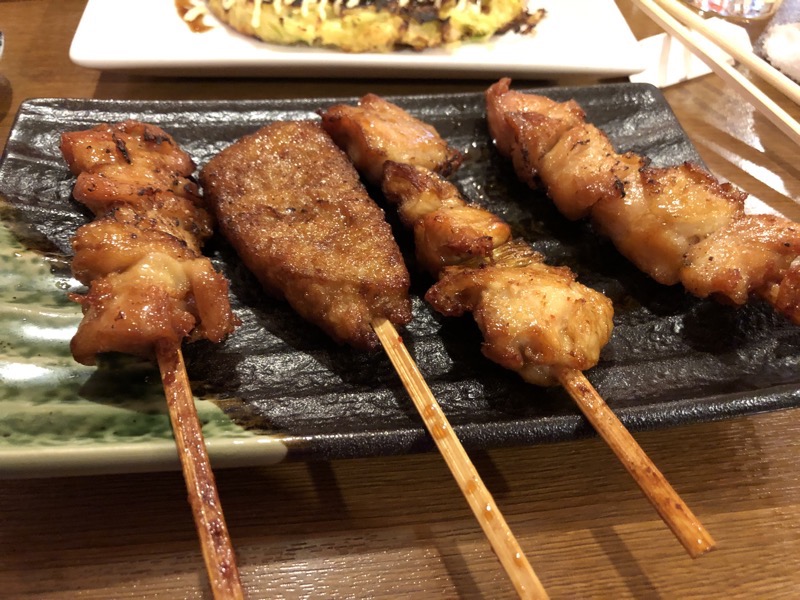
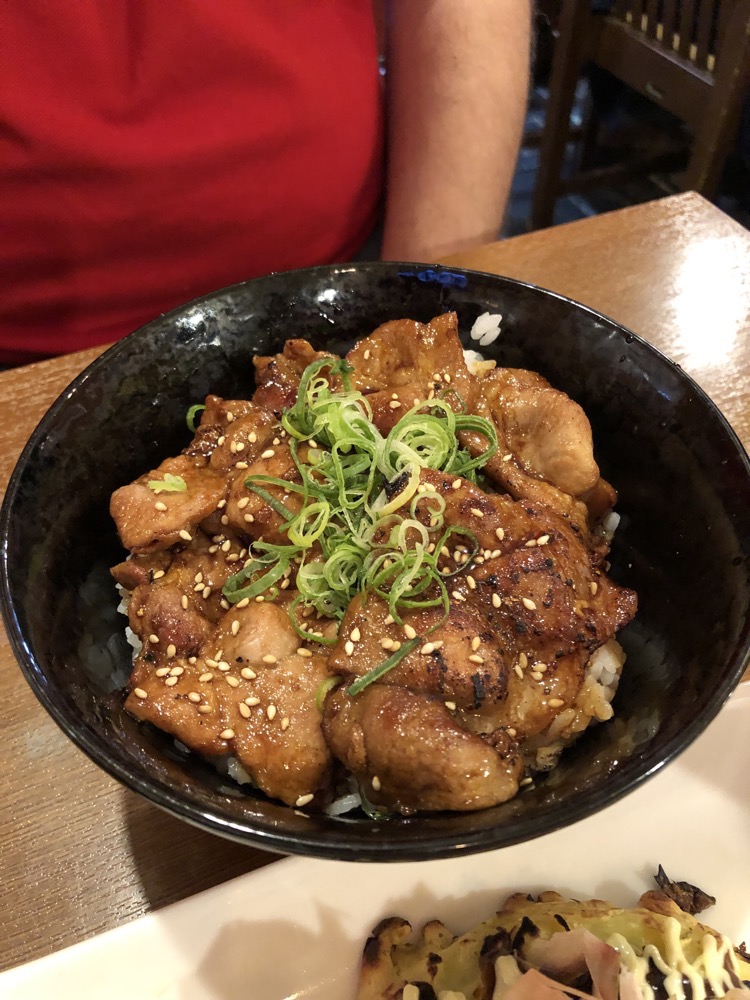
 Then it was back to the hotel for a well-earned soak in the tub and some more saké to round out the day. My poor little feets were very much complaining about the 12kms of pavement we walked today but all that was forgotten as we caught the latest GoT before crashing for the night.
Then it was back to the hotel for a well-earned soak in the tub and some more saké to round out the day. My poor little feets were very much complaining about the 12kms of pavement we walked today but all that was forgotten as we caught the latest GoT before crashing for the night.


 Some cool artworks depicting the Castle over the various periods, unfortunately, all the descriptions were :
Some cool artworks depicting the Castle over the various periods, unfortunately, all the descriptions were :





 The Shokanzeonbosatsu Temple inside the grounds of Osaka Castle.
The Shokanzeonbosatsu Temple inside the grounds of Osaka Castle.



 The Main Tower of Osaka Castle Park was built in by Hideyoshi Toyotomi in 1583, however, it was not completed until after his death. During the Summer War of 1615, (Toyotomi family vs Tokugawa family) the tower was burned down and rebuilt in 1629. Unfortunately, it was destroyed again in 1665 when it was burned to the ground after being struck by lightning. In 1931, through the donations of the citizens of Osaka, the main town was reconstructed – which is the tower able to be seen today.
The Main Tower of Osaka Castle Park was built in by Hideyoshi Toyotomi in 1583, however, it was not completed until after his death. During the Summer War of 1615, (Toyotomi family vs Tokugawa family) the tower was burned down and rebuilt in 1629. Unfortunately, it was destroyed again in 1665 when it was burned to the ground after being struck by lightning. In 1931, through the donations of the citizens of Osaka, the main town was reconstructed – which is the tower able to be seen today. 
 Now we were aware that the grounds of Osaka Castle has over 4000 cherry blossom trees, but we are considerably south now from Aomori and Hirosaki Castel, and the cherry blossom blooming has been and gone. The trees are all green and people will have to wait until next year to see these parks in all their glory. The only sign we saw at all that indicated how famous this site is for its blossoms was this dried arrangement that was outside a Moet et Chandon tasting tent. I can imagine it would be stunning, the flowers here being more of the pink varieties of cherry blossom rather than the later blooming ones in Aomori. Seeing how fleeing the flowering season is (barely a week this way or that) I feel doubly lucky to have spent such a fairy tale day on our anniversary enjoying a hanami picnic at Hirosaki last Wednesday.
Now we were aware that the grounds of Osaka Castle has over 4000 cherry blossom trees, but we are considerably south now from Aomori and Hirosaki Castel, and the cherry blossom blooming has been and gone. The trees are all green and people will have to wait until next year to see these parks in all their glory. The only sign we saw at all that indicated how famous this site is for its blossoms was this dried arrangement that was outside a Moet et Chandon tasting tent. I can imagine it would be stunning, the flowers here being more of the pink varieties of cherry blossom rather than the later blooming ones in Aomori. Seeing how fleeing the flowering season is (barely a week this way or that) I feel doubly lucky to have spent such a fairy tale day on our anniversary enjoying a hanami picnic at Hirosaki last Wednesday. Also near the Main Tower is a large modern shopping centre full of restaurants and souvenir shops. Some of the goods for sale were stunning and some of them redefining ‘tacky’. We had a wander through the shops and stopped for a takoyaki snack. Takoyaki seems to be a local favourite.
Also near the Main Tower is a large modern shopping centre full of restaurants and souvenir shops. Some of the goods for sale were stunning and some of them redefining ‘tacky’. We had a wander through the shops and stopped for a takoyaki snack. Takoyaki seems to be a local favourite. 
 These are ceramic chopstick rests made to look like foods:
These are ceramic chopstick rests made to look like foods: Weirdly, there was heaps of takoyaki designed souvenirs… with lots of happy looking squids and happy smiley balls of batter?!
Weirdly, there was heaps of takoyaki designed souvenirs… with lots of happy looking squids and happy smiley balls of batter?!


 The museum was a lovely modern facility – you work your way down from the 10th floor which starts off talking about excavations of the 7-8th C Naniwa Palace and works it way down to contemporary Osaka as you move down the floors.
The museum was a lovely modern facility – you work your way down from the 10th floor which starts off talking about excavations of the 7-8th C Naniwa Palace and works it way down to contemporary Osaka as you move down the floors. There are some gorgeous views from the upper floors of the Osaka Castle grounds and you can see really how imposing those moats were!
There are some gorgeous views from the upper floors of the Osaka Castle grounds and you can see really how imposing those moats were!
 There were various displays of decorative arts – scrolls, paintings, ceramics, some artefacts from the earliest periods of the area. But I generally felt the museum was light on extant items and relied fairly heavily on interactive displays and recreated objects.
There were various displays of decorative arts – scrolls, paintings, ceramics, some artefacts from the earliest periods of the area. But I generally felt the museum was light on extant items and relied fairly heavily on interactive displays and recreated objects.



 Traditional writing desk for writers of the Bunraku puppet theatres:
Traditional writing desk for writers of the Bunraku puppet theatres:
 The Beauties by Tukioka Settei, 18th C.
The Beauties by Tukioka Settei, 18th C. Apes and wasp by Mori Sosen, 18th – 19th C.
Apes and wasp by Mori Sosen, 18th – 19th C. Funghi and Parrot by Mitani Totei, 18th C… though for the life of me I can’t figure out why there is an Australian sulphur-crested cockatoo depicted on an 18th C Japanese scroll!
Funghi and Parrot by Mitani Totei, 18th C… though for the life of me I can’t figure out why there is an Australian sulphur-crested cockatoo depicted on an 18th C Japanese scroll!

 Flag with signatures for a Japanese soldier,1938.
Flag with signatures for a Japanese soldier,1938.
 Votive plaques from the late 19th C.
Votive plaques from the late 19th C.
 Now, everyone, knows transit days suck balls… big hairy sweaty ones on occasion, and this is why the No 1 Golden Rule of Travel is: Never plan to go sightseeing on transit days! So what did these very well travelled individuals plan for today? Well, we broke the stupid rule and planned to disembark the ship in Yokohama, take a train to Kyoto, put our luggage in storage, and go to the famous Minamiza Theatre in Gion to see the Mikayo Odori Spring Dances. It’s barely a 20 minute trip on the Shinkansen from Osaka to Kyoto, and ideally, we would have come back at some point over the next week to see this uniquely Japanese cultural experience – but the season quite literally ends today, and we were able to buy tickets for the second last performance for 2019. So here we were, breaking the Travel Rules.
Now, everyone, knows transit days suck balls… big hairy sweaty ones on occasion, and this is why the No 1 Golden Rule of Travel is: Never plan to go sightseeing on transit days! So what did these very well travelled individuals plan for today? Well, we broke the stupid rule and planned to disembark the ship in Yokohama, take a train to Kyoto, put our luggage in storage, and go to the famous Minamiza Theatre in Gion to see the Mikayo Odori Spring Dances. It’s barely a 20 minute trip on the Shinkansen from Osaka to Kyoto, and ideally, we would have come back at some point over the next week to see this uniquely Japanese cultural experience – but the season quite literally ends today, and we were able to buy tickets for the second last performance for 2019. So here we were, breaking the Travel Rules.
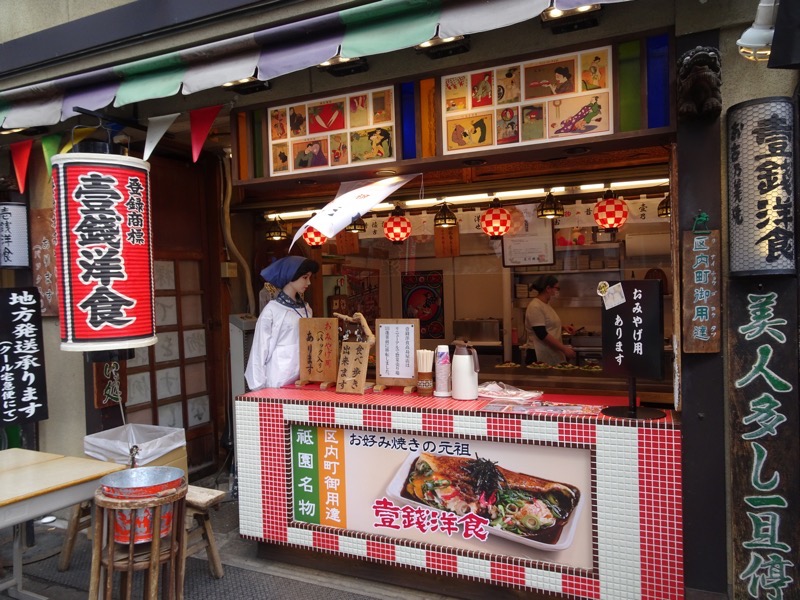
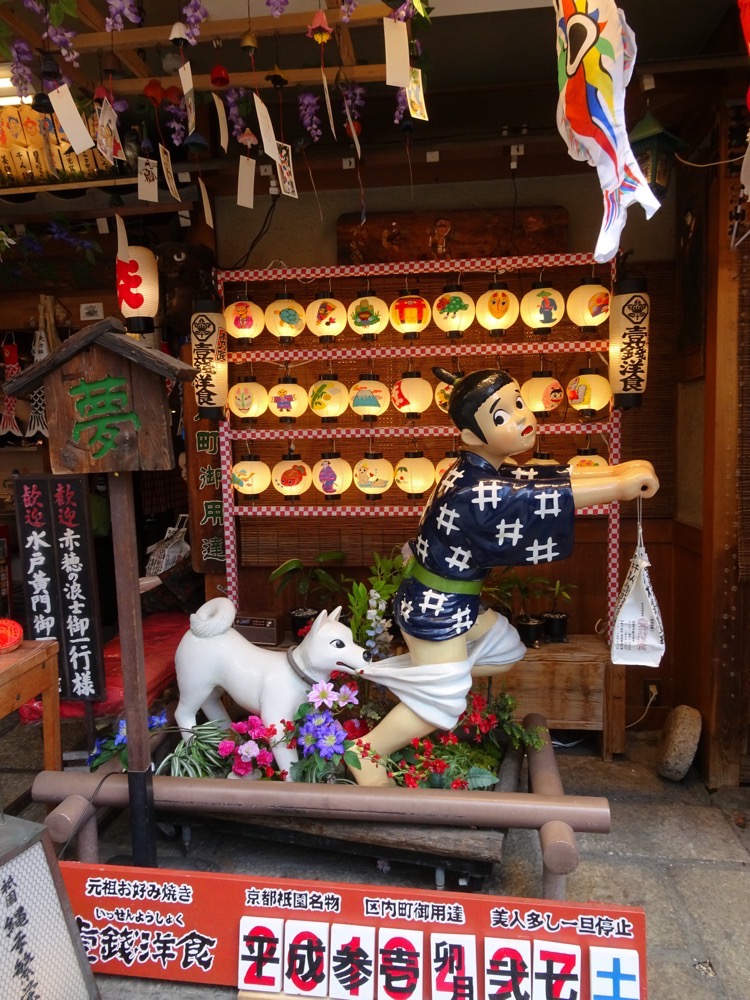
 The Miyako Odori spring dances have been held at the Minimaza theatre (which was built in the 1600s) since the late 1800s. The place has quite a history and each year the dances are designed to celebrate the spring/cherry blossom season and to show off the talent of the maiko – the apprentice geisha who grace the Hanamachi, (the ‘Flower Town’ pleasure district) of Gion that is full of historic ochaya (teahouses) and okiya (geisha houses).
The Miyako Odori spring dances have been held at the Minimaza theatre (which was built in the 1600s) since the late 1800s. The place has quite a history and each year the dances are designed to celebrate the spring/cherry blossom season and to show off the talent of the maiko – the apprentice geisha who grace the Hanamachi, (the ‘Flower Town’ pleasure district) of Gion that is full of historic ochaya (teahouses) and okiya (geisha houses).
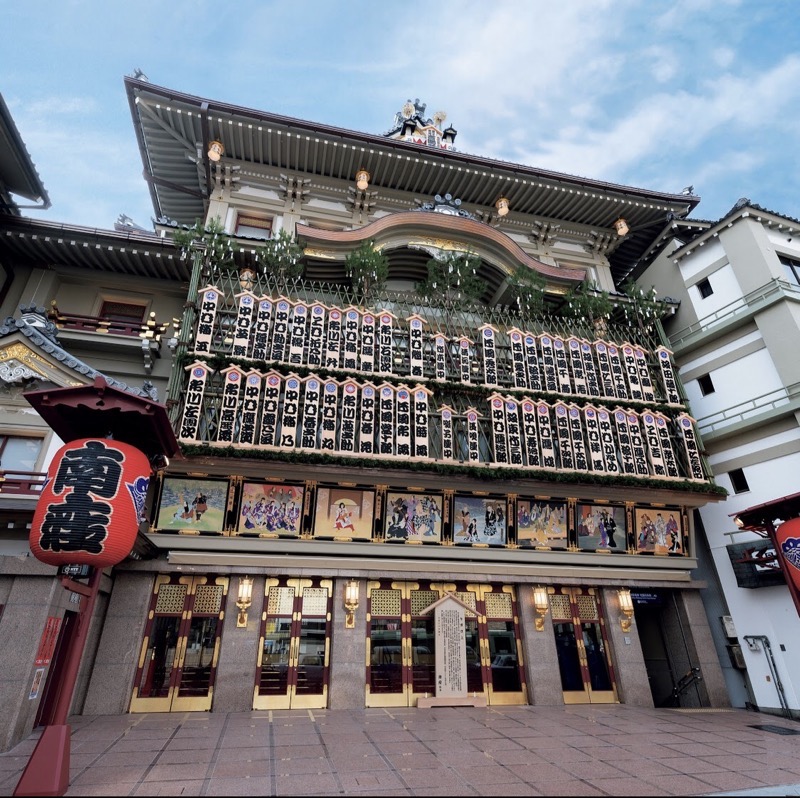
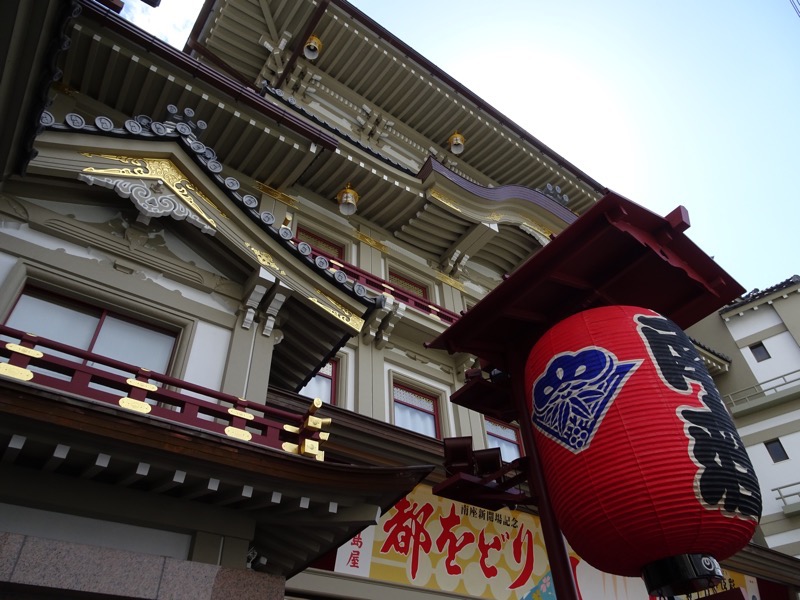 I remember these kimono from when we were last in Kyoto in 2015 – we visited an exhibition called ‘The Maiko Story’ that highlighted the history and traditions of the lives of the maiko and geiko that grace Gion. Today we would get to see the maiko dancing in them.
I remember these kimono from when we were last in Kyoto in 2015 – we visited an exhibition called ‘The Maiko Story’ that highlighted the history and traditions of the lives of the maiko and geiko that grace Gion. Today we would get to see the maiko dancing in them. 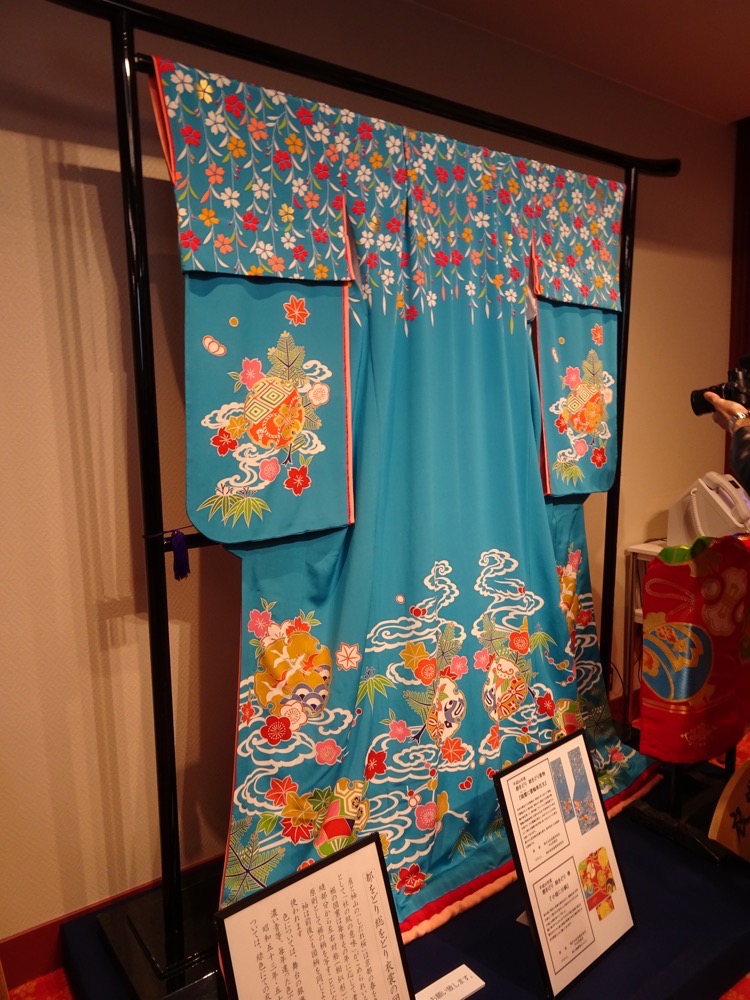
 There is no photography allowed in the theatre during performances, so I have ‘borrowed’ some images from official promotional material and ever helpful Wikipedia. The costumes were lovely, the dancing was precise, graceful and exactly what I expected to see from these highly trained artisans. The music, however, was at various points during the performance ear piercingly painful! The flutes, they’re so high! Ouch. The singing too, while not as bad as the caterwauling we experienced at various cultural performances in China, was likewise not always ‘pleasant’. Still, it was quite the visual spectacle and it was wonderful to add this quintessentially Japanese experience to our ‘When in Rome’ List.
There is no photography allowed in the theatre during performances, so I have ‘borrowed’ some images from official promotional material and ever helpful Wikipedia. The costumes were lovely, the dancing was precise, graceful and exactly what I expected to see from these highly trained artisans. The music, however, was at various points during the performance ear piercingly painful! The flutes, they’re so high! Ouch. The singing too, while not as bad as the caterwauling we experienced at various cultural performances in China, was likewise not always ‘pleasant’. Still, it was quite the visual spectacle and it was wonderful to add this quintessentially Japanese experience to our ‘When in Rome’ List.
 The final scene was quite the spectacle with all the performers returning to the stage and dancing in unison – except for two obviously very senior geiko who seemed to be marching to their own tune.
The final scene was quite the spectacle with all the performers returning to the stage and dancing in unison – except for two obviously very senior geiko who seemed to be marching to their own tune.
1_fvde-2f.jpg) After the performance was over we hopped another cab back to the Post Office to collect the luggage and made our way back to the Shinkansen to catch a train to Osaka. Thankfully, we didn’t have much trouble finding seats – it is the Tokyo to Kyoto segment that seems to be super popular at the moment and we were not surprised given it is Golden Week.
After the performance was over we hopped another cab back to the Post Office to collect the luggage and made our way back to the Shinkansen to catch a train to Osaka. Thankfully, we didn’t have much trouble finding seats – it is the Tokyo to Kyoto segment that seems to be super popular at the moment and we were not surprised given it is Golden Week. After we got settled, we were a bit shattered to be honest (that is what you get for breaking the Travel Rules), so Keith popped out for some milk to make tea and some sake for well,…for obvious reasons really! Eventually, we opted to go out for a late dinner and we ended up at a restaurant called
After we got settled, we were a bit shattered to be honest (that is what you get for breaking the Travel Rules), so Keith popped out for some milk to make tea and some sake for well,…for obvious reasons really! Eventually, we opted to go out for a late dinner and we ended up at a restaurant called  Dinner was a delicious boat of fresh sashimi, some takoyaki and yakitori and of course sake! (If it looks like I am using alcohol to help me sleep in the absence of some of my medications and my own bed – that is probably because I am!)
Dinner was a delicious boat of fresh sashimi, some takoyaki and yakitori and of course sake! (If it looks like I am using alcohol to help me sleep in the absence of some of my medications and my own bed – that is probably because I am!) The place has a lively atmosphere, a lot of laughter from the rabbit warren of individual little dining rooms, and the free-flowing liquor. If it weren’t for the Japanese propensity to let people still smoke cigarettes in these types of restaurants, I’d say it was a perfect fun spot with great food and we’ll be back – but, there are too many other places to try and if we can find great food sans smoking, we’d much prefer it.
The place has a lively atmosphere, a lot of laughter from the rabbit warren of individual little dining rooms, and the free-flowing liquor. If it weren’t for the Japanese propensity to let people still smoke cigarettes in these types of restaurants, I’d say it was a perfect fun spot with great food and we’ll be back – but, there are too many other places to try and if we can find great food sans smoking, we’d much prefer it. 
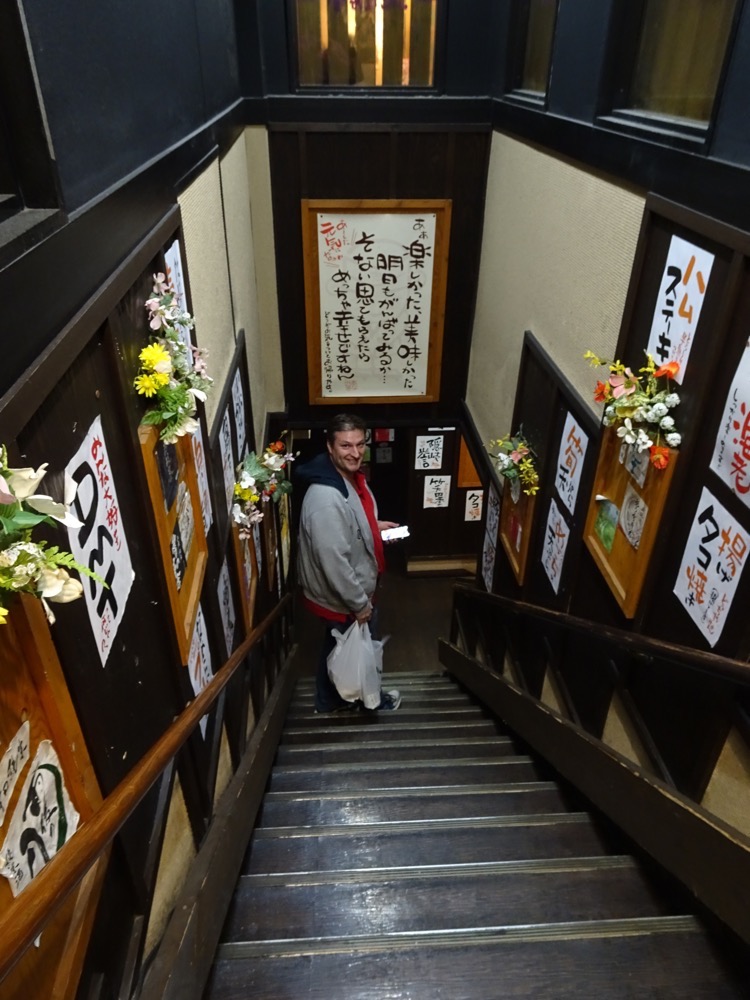 Then, it was time to head back to the hotel, write all this guff up before we have new adventures tomorrow and I forget all about the details of today.
Then, it was time to head back to the hotel, write all this guff up before we have new adventures tomorrow and I forget all about the details of today. The town’s dignitaries, including the governor of Iwate, the Mayor of Miyako and a host of other important looking middle aged men waiting for the ceremony to commence…
The town’s dignitaries, including the governor of Iwate, the Mayor of Miyako and a host of other important looking middle aged men waiting for the ceremony to commence…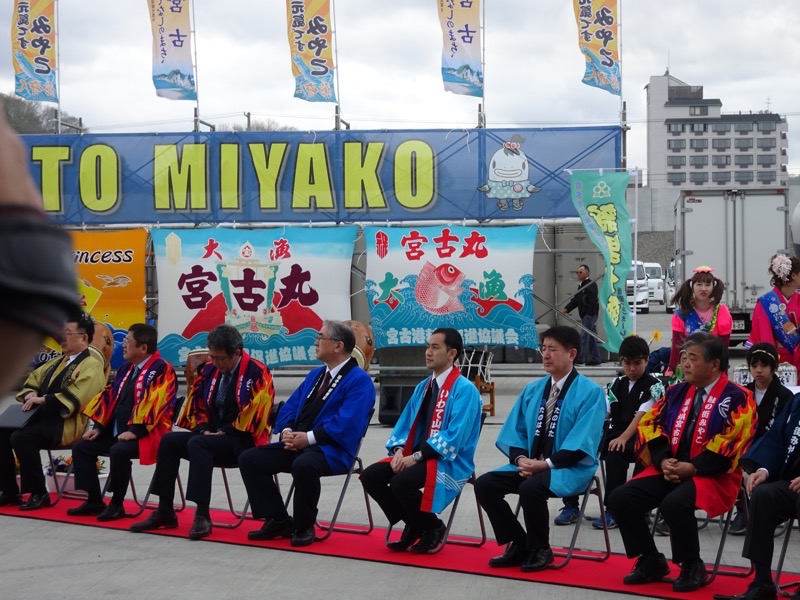 The governor and the mayor listening to the ships captain giving a speech.
The governor and the mayor listening to the ships captain giving a speech.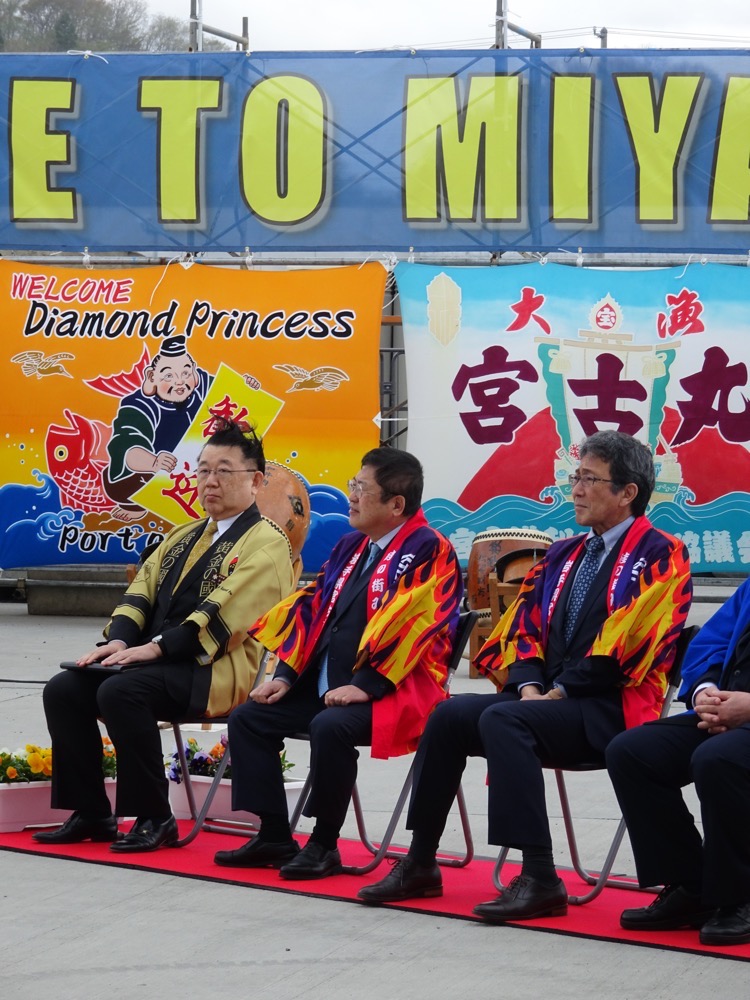 The Mayor of Miyako who made a point of greeting us personally – I mean, I think he greeted nearly everyone who came off the ship by shaking hands and asking where we came from. He was very friendly and had pretty good English.
The Mayor of Miyako who made a point of greeting us personally – I mean, I think he greeted nearly everyone who came off the ship by shaking hands and asking where we came from. He was very friendly and had pretty good English.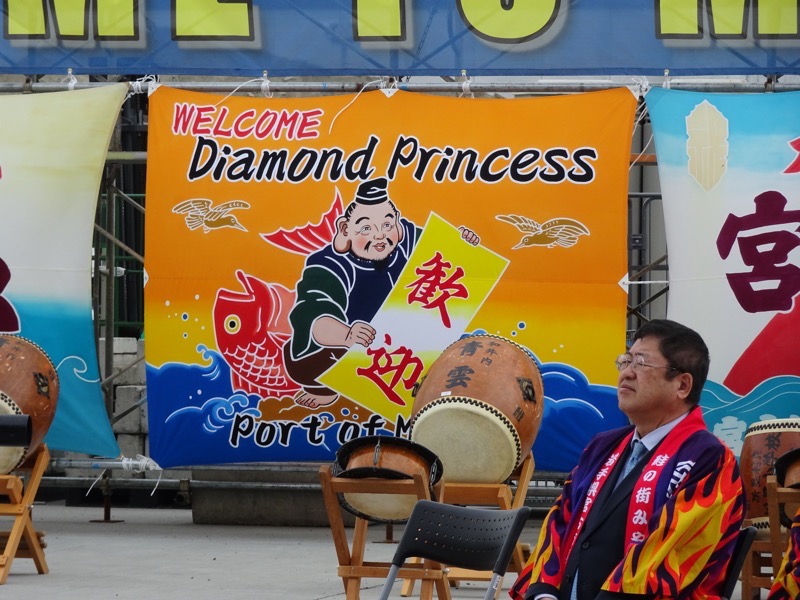
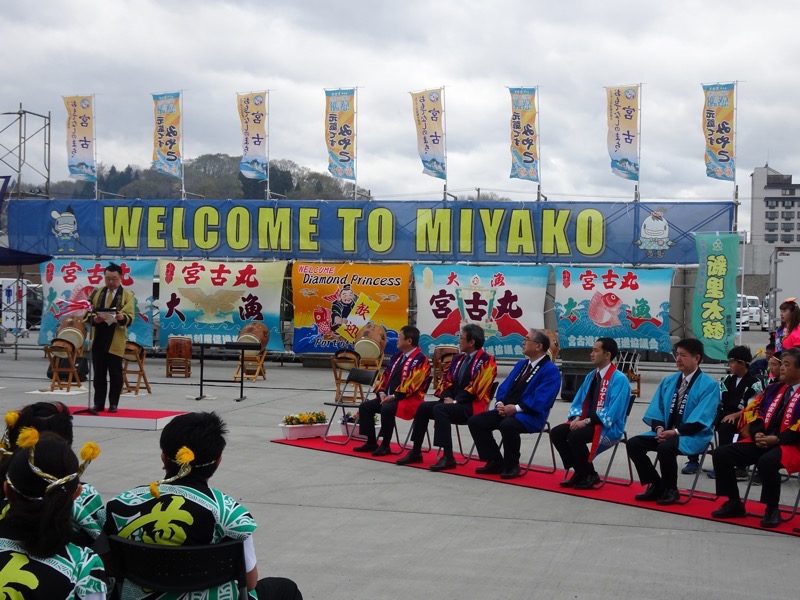 The town has a bunch of cute mascots… not quite sure what they are? A salmon, a dolphin and a couple of dragons?
The town has a bunch of cute mascots… not quite sure what they are? A salmon, a dolphin and a couple of dragons? 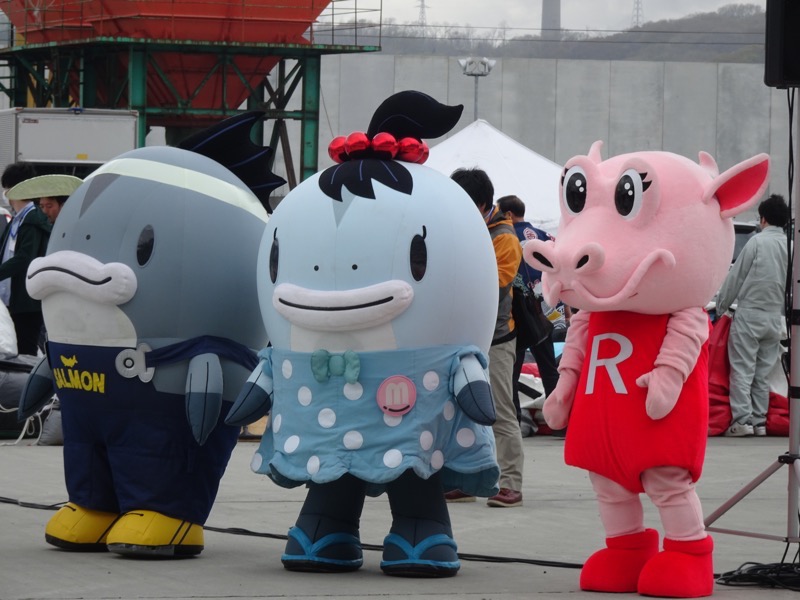
 It was not just the local dignitaries, but the local merchants were really happy to see the ship in port as well, and turned out with food trucks, market stalls, sake vendors, school children doing caligraphy and all sorts of cool stuff.
It was not just the local dignitaries, but the local merchants were really happy to see the ship in port as well, and turned out with food trucks, market stalls, sake vendors, school children doing caligraphy and all sorts of cool stuff. Today is also ANZAC Day, and the ship had a dawn service at 4:28am, which oddly enough we didn’t make it to. Last time I was on a ship for ANZAC Day (a cruise out of Australia though) they did a dawn service and another service at 11am… this time they didn’t have the second service and I didn’t notice in the schedule that it wasn’t going to be happening. This cruise seems to be made up of about 800 Australians so I can understand them not doing two – but I was sad to miss it.
Today is also ANZAC Day, and the ship had a dawn service at 4:28am, which oddly enough we didn’t make it to. Last time I was on a ship for ANZAC Day (a cruise out of Australia though) they did a dawn service and another service at 11am… this time they didn’t have the second service and I didn’t notice in the schedule that it wasn’t going to be happening. This cruise seems to be made up of about 800 Australians so I can understand them not doing two – but I was sad to miss it.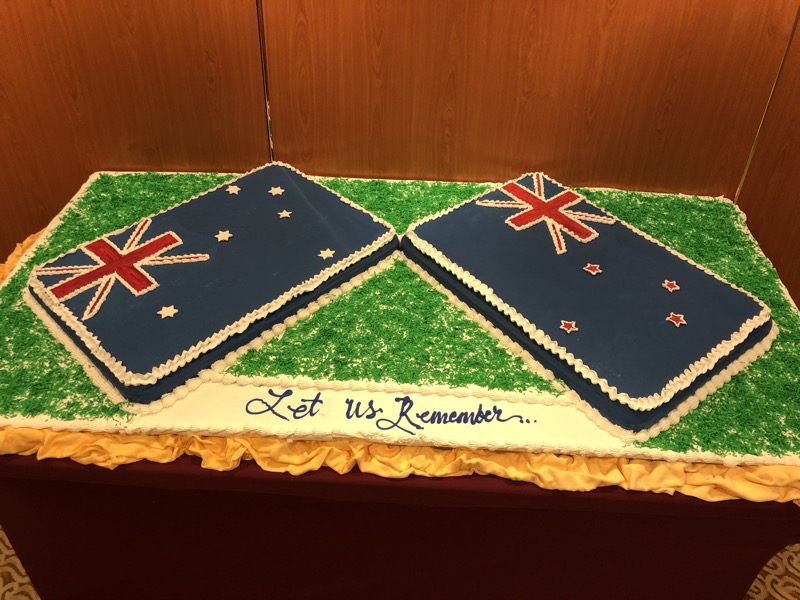
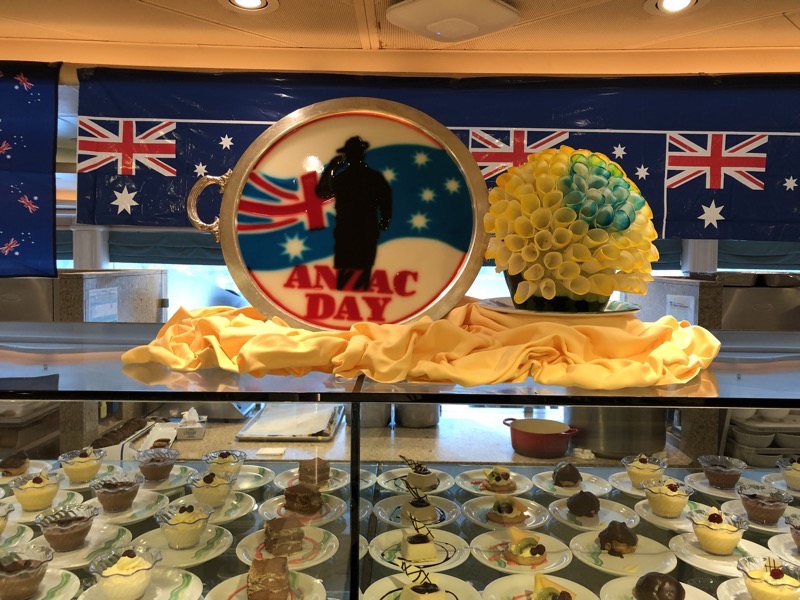



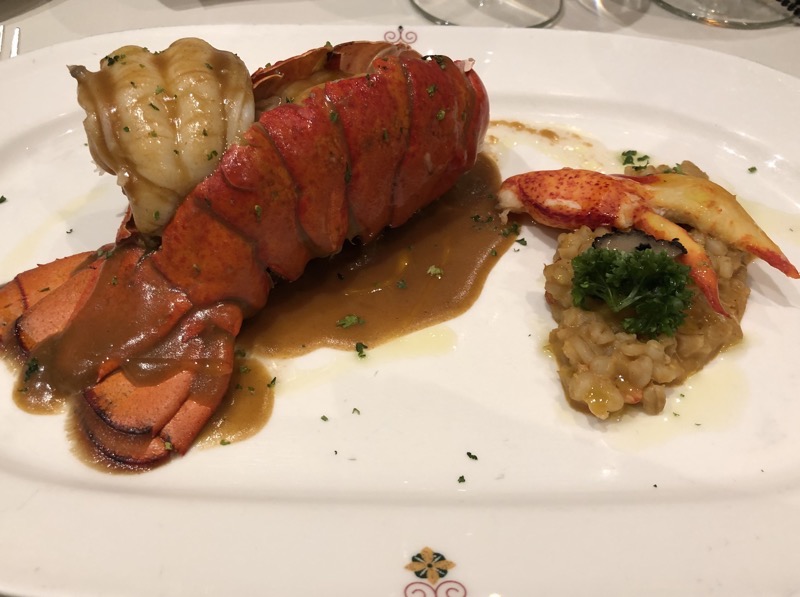
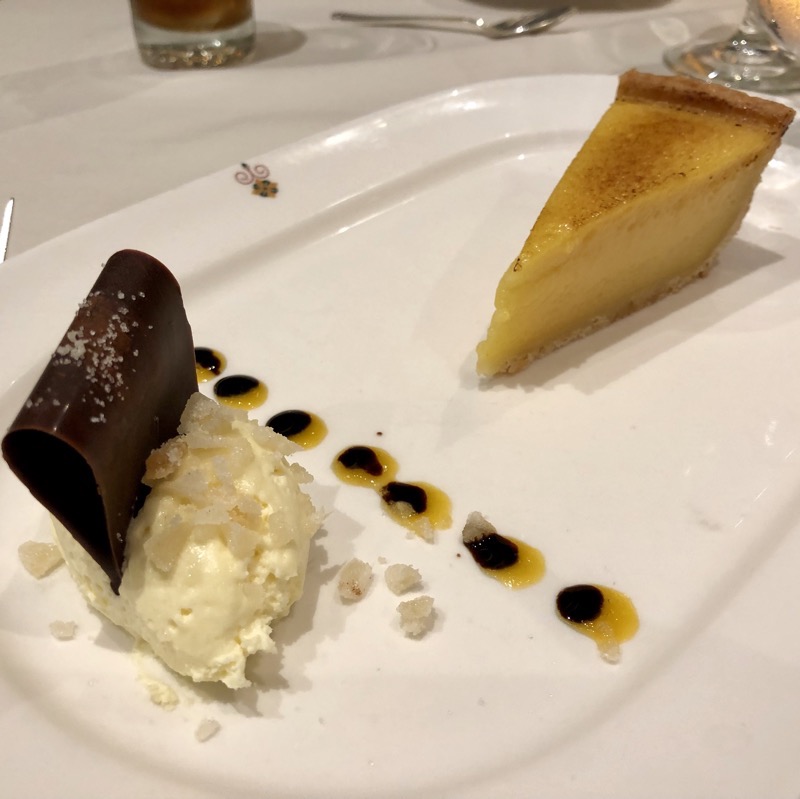
 After dinner we went to check out a new show that Princess has created especially for its Asian cruises called ‘The Secret Silk’ that was created by Stephen Schwartz – the award-winning composer of Wicked, Godspell and Pippin, in conjunction with John Tartaglia, who has starred in Broadway hits like Avenue Q and Beauty and the Beast. We had pretty high expectations given the talent involved, but it felt like a swing and a miss as far as we could see… it was a Japanese inspired story with an Asian style costumes, dance choreography and set design, all set to Western music which really ruined it… the whole thing felt like the producers didn’t ‘trust’ Western audiences to be able to connect with and understand music that was congruous with the themes they were attempting to work with. So it was weird and disjointed. Which is a shame because it looked great.
After dinner we went to check out a new show that Princess has created especially for its Asian cruises called ‘The Secret Silk’ that was created by Stephen Schwartz – the award-winning composer of Wicked, Godspell and Pippin, in conjunction with John Tartaglia, who has starred in Broadway hits like Avenue Q and Beauty and the Beast. We had pretty high expectations given the talent involved, but it felt like a swing and a miss as far as we could see… it was a Japanese inspired story with an Asian style costumes, dance choreography and set design, all set to Western music which really ruined it… the whole thing felt like the producers didn’t ‘trust’ Western audiences to be able to connect with and understand music that was congruous with the themes they were attempting to work with. So it was weird and disjointed. Which is a shame because it looked great.
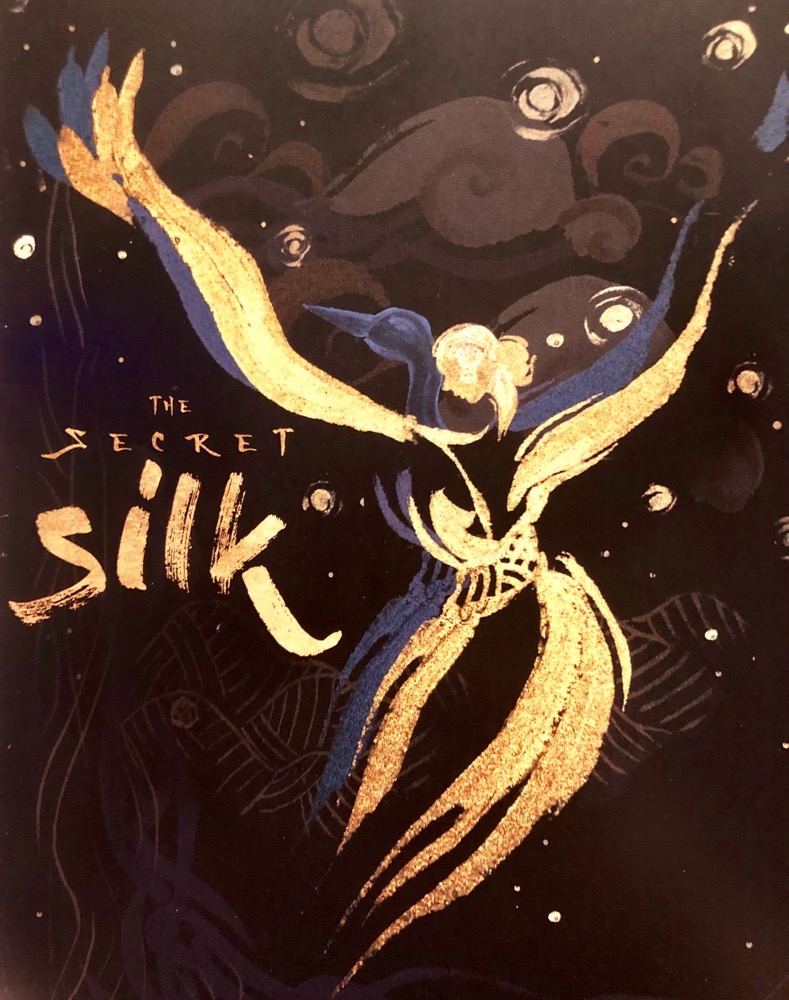

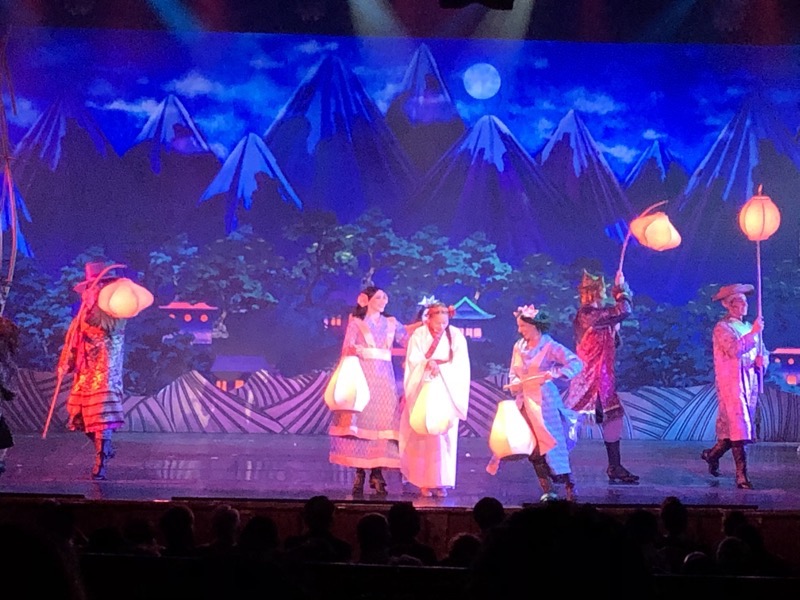
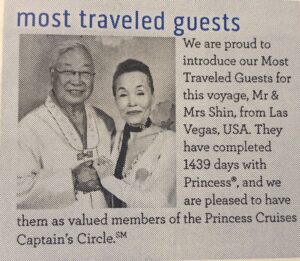 As a little weirdness that I probably shouldn’t be putting in here but which gave me quite the giggle – we were in a lift well today and saw this lovely and very elegant couple who have been swanning around the ship (and I do mean swanning, they have been ballroom dancing in the middle of the atrium at every opportunity) getting ready to go down to dinner. Mrs Shin was shaking a shawl around her shoulders and some very practical white knickers fell out of her shawl and onto the floor, which Mr Shin tried to hastily retrieve and then rush back to their room. 🙂 They have been walking about the ship like they were at home – but perhaps that is taking the ‘home away from home’ concept a little too far. She was so embarrassed, it was adorable.
As a little weirdness that I probably shouldn’t be putting in here but which gave me quite the giggle – we were in a lift well today and saw this lovely and very elegant couple who have been swanning around the ship (and I do mean swanning, they have been ballroom dancing in the middle of the atrium at every opportunity) getting ready to go down to dinner. Mrs Shin was shaking a shawl around her shoulders and some very practical white knickers fell out of her shawl and onto the floor, which Mr Shin tried to hastily retrieve and then rush back to their room. 🙂 They have been walking about the ship like they were at home – but perhaps that is taking the ‘home away from home’ concept a little too far. She was so embarrassed, it was adorable.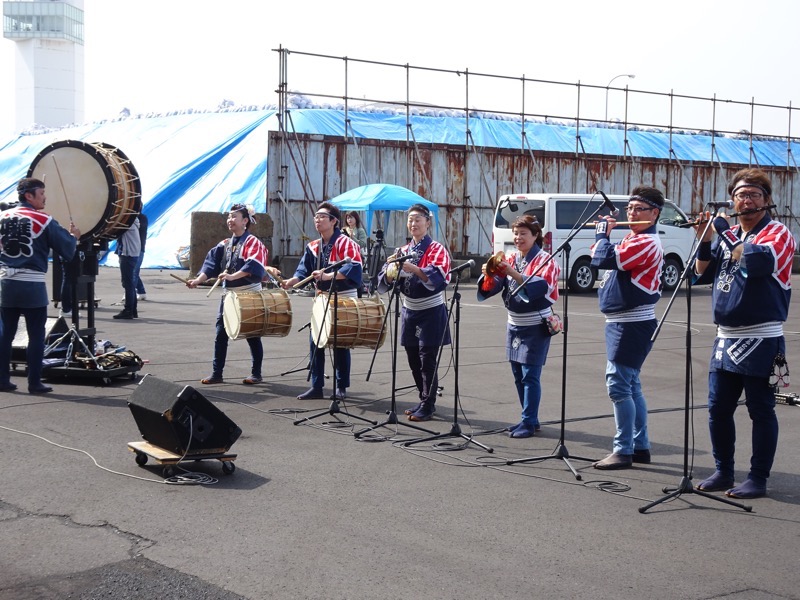 This our third trip to Aomori. On my first visit here I took a day trip out to Lake Towada in the Towada-Hachimantai National Park and took a day cruise around the lake with Aunty Mary. On my second visit here, I spent the day checking out the cultural highlights of the Nebuta House and the Wa-Rasse Museum, which houses all the beautiful floats that are used in the annual Nebuta Festival. Today we decided to have a nice relaxing day, hire a car and drive up to the nearby Hirosaki Castle – about 35kms from port – to hopefully see the famous cherry blossoms and have our own little hanami anniversary picnic.
This our third trip to Aomori. On my first visit here I took a day trip out to Lake Towada in the Towada-Hachimantai National Park and took a day cruise around the lake with Aunty Mary. On my second visit here, I spent the day checking out the cultural highlights of the Nebuta House and the Wa-Rasse Museum, which houses all the beautiful floats that are used in the annual Nebuta Festival. Today we decided to have a nice relaxing day, hire a car and drive up to the nearby Hirosaki Castle – about 35kms from port – to hopefully see the famous cherry blossoms and have our own little hanami anniversary picnic.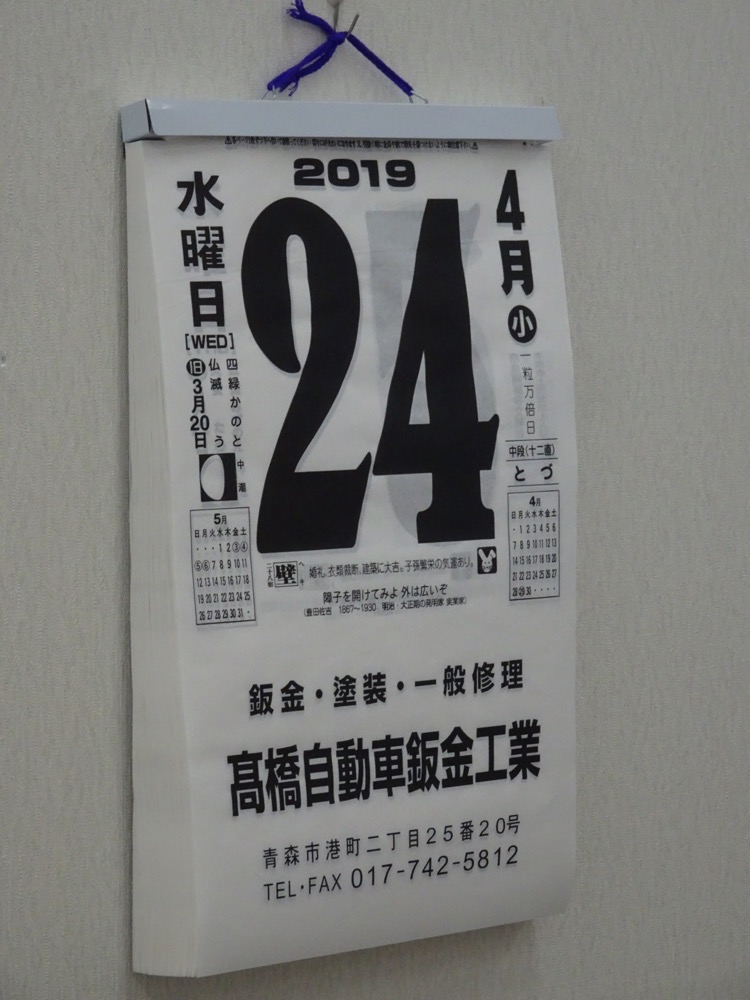 We picked up our rental car without incident, but the Japanese propensity for proper paperwork struck us yet again, this time in the form of needing to have an International Drivers Permit in order to be able to hire the vehicle. We have hired cars in the US, Canada, New Zealand, Iceland, Poland, Germany, all over the place and usually have a permit, but they never really ask for it. Here of course, they do like to dot the ‘i’s and cross the ‘t’s, and luckily I still had a valid International Drivers Permit from my last trip and we were able to hire our gutless little compact Toyota for the day.
We picked up our rental car without incident, but the Japanese propensity for proper paperwork struck us yet again, this time in the form of needing to have an International Drivers Permit in order to be able to hire the vehicle. We have hired cars in the US, Canada, New Zealand, Iceland, Poland, Germany, all over the place and usually have a permit, but they never really ask for it. Here of course, they do like to dot the ‘i’s and cross the ‘t’s, and luckily I still had a valid International Drivers Permit from my last trip and we were able to hire our gutless little compact Toyota for the day. We entered through the famous Cherry Blossom Tunnel and were immediately overcome by the beautiful, almost surreal, atmosphere created by these ancient trees. On either side of us as we strolled along the river banks were elegrant and graceful cherry trees that appeared to be just dripping in flowers. The effect is hard to describe, a feeling of wonderment followed us around for our entire time here – I can only liken it to being engulfed in an enormous piece of installation art that overcomes all your senses… the beauty of the flowers, the delightfully subtle aroma of the blossoms in the air, the awed hushed and respectful tones of the people murmuring their appreciation as they moved among the trees, the gentle lapping of the nearby water, and an almost magical feeling in the air as everyone seemed entranced by this overwhelming sight. I can only compare it to the feelings I had seeing St Peter’s in Rome for the first time, or the sense of wonder and awe that I felt at Machu Picchu… it’s hard to describe how these truly unique places can effect you. And this was most unexpected – I mean, they’re just flowers in lots of trees, but this felt like a truly special place and a truly special sight and I felt honoured and priviledged to be here to enjoy this. And I make no apologies for all the photographs I have included in this post, they do not in any way do it justice – in my mind, these photos are a pale imitation of what this place looks like and how it made us feel.
We entered through the famous Cherry Blossom Tunnel and were immediately overcome by the beautiful, almost surreal, atmosphere created by these ancient trees. On either side of us as we strolled along the river banks were elegrant and graceful cherry trees that appeared to be just dripping in flowers. The effect is hard to describe, a feeling of wonderment followed us around for our entire time here – I can only liken it to being engulfed in an enormous piece of installation art that overcomes all your senses… the beauty of the flowers, the delightfully subtle aroma of the blossoms in the air, the awed hushed and respectful tones of the people murmuring their appreciation as they moved among the trees, the gentle lapping of the nearby water, and an almost magical feeling in the air as everyone seemed entranced by this overwhelming sight. I can only compare it to the feelings I had seeing St Peter’s in Rome for the first time, or the sense of wonder and awe that I felt at Machu Picchu… it’s hard to describe how these truly unique places can effect you. And this was most unexpected – I mean, they’re just flowers in lots of trees, but this felt like a truly special place and a truly special sight and I felt honoured and priviledged to be here to enjoy this. And I make no apologies for all the photographs I have included in this post, they do not in any way do it justice – in my mind, these photos are a pale imitation of what this place looks like and how it made us feel.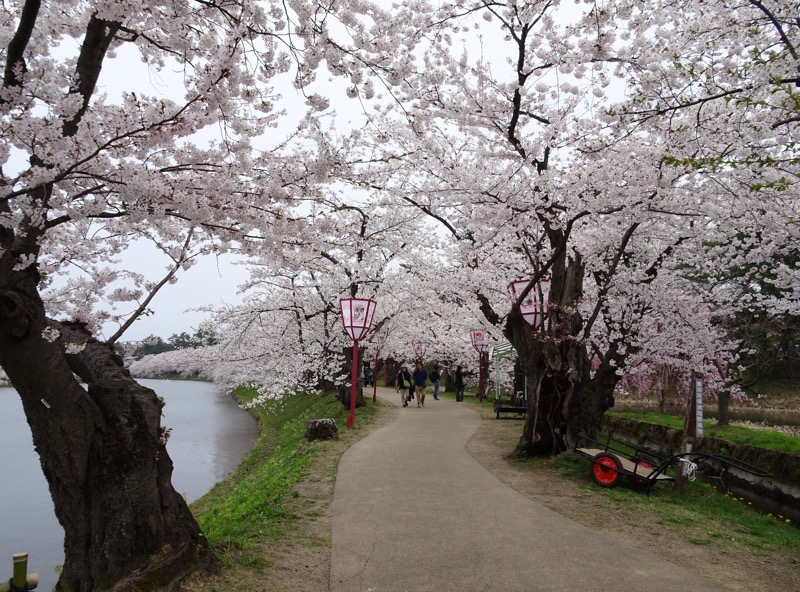
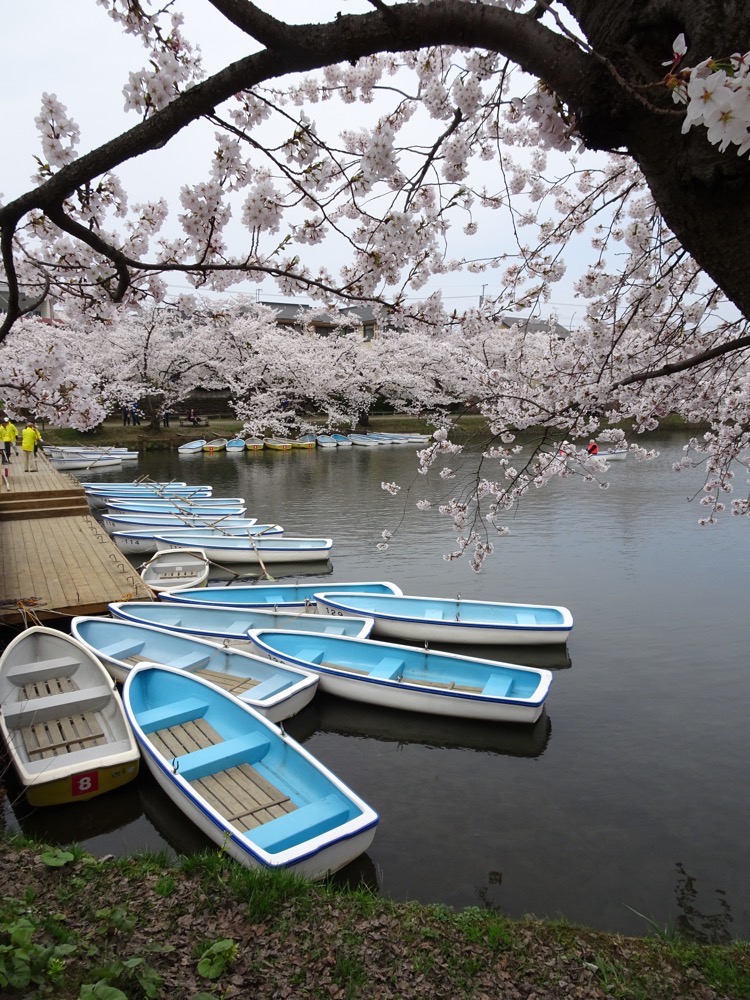 The gardens were largely filled with locals who were drawn to the park to enjoy the beautfy of the trees – you could tell they were on their lunch breaks from work, or were there with work colleagues to enjoy a hanami party – a traditional cherry blossom viewing party that typically involves picnic blankets, feast day foods, and sake on the grass under the beautfiul trees as you watch the wind rustling through the branches and the occasional petals falling from the trees like confetti.
The gardens were largely filled with locals who were drawn to the park to enjoy the beautfy of the trees – you could tell they were on their lunch breaks from work, or were there with work colleagues to enjoy a hanami party – a traditional cherry blossom viewing party that typically involves picnic blankets, feast day foods, and sake on the grass under the beautfiul trees as you watch the wind rustling through the branches and the occasional petals falling from the trees like confetti. 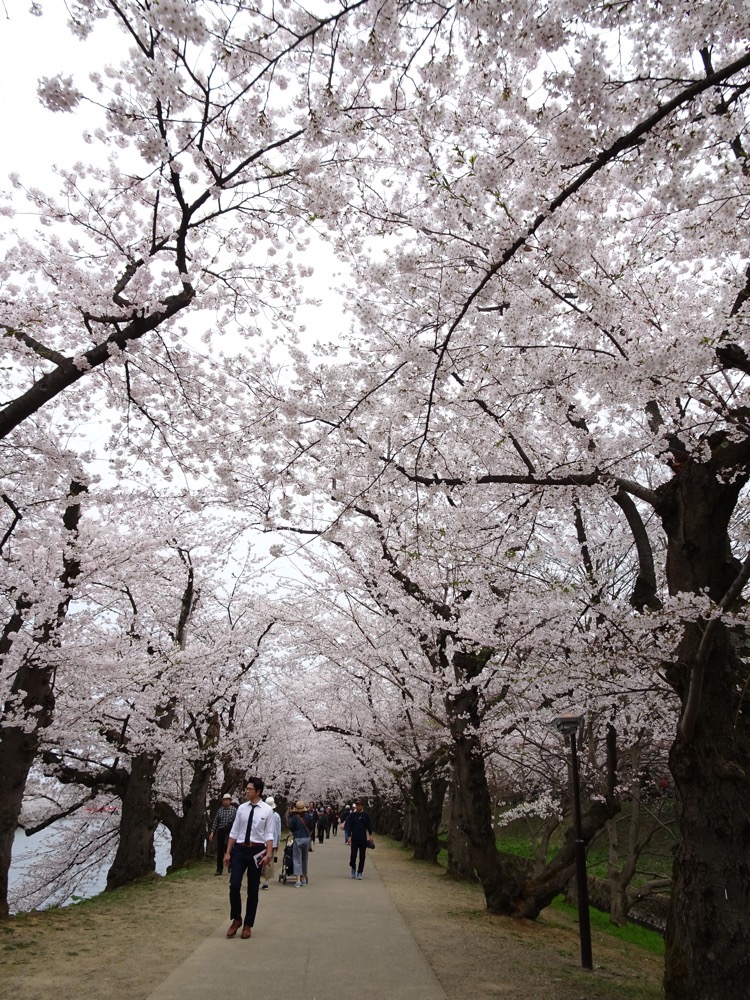 Every man and their puppy appeared to be out enjoying the gardens today… even that Dogue. 🙂
Every man and their puppy appeared to be out enjoying the gardens today… even that Dogue. 🙂 
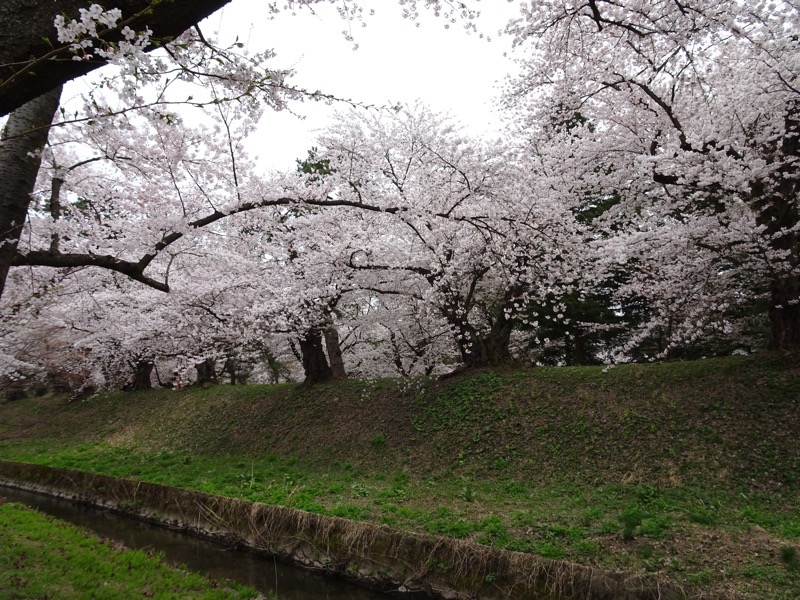 I have a feeling I am going to end up sounding completely repetitive here – but this place feels completely magical.
I have a feeling I am going to end up sounding completely repetitive here – but this place feels completely magical. 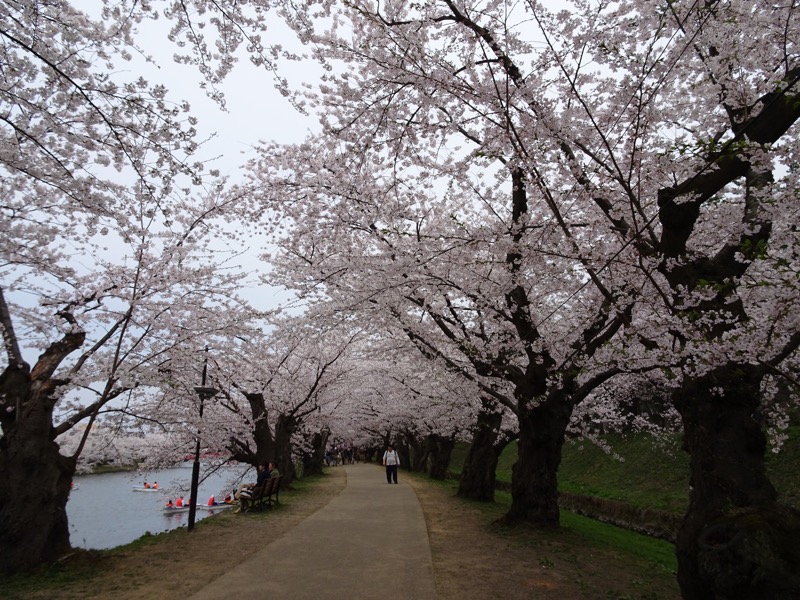 Further into the park, towards the end of the Cherry Blossom Tunnel was the start of the Festival Markets that spring up between 20th April and May 3rd this year. This is known as Golden Week in Japan and many domestic tourists are taking their annual holidays. Here at the base of the castle walls, the markets were full of knickknacks and toys for children, sideshow alley type games of chance and some interesting food stalls.
Further into the park, towards the end of the Cherry Blossom Tunnel was the start of the Festival Markets that spring up between 20th April and May 3rd this year. This is known as Golden Week in Japan and many domestic tourists are taking their annual holidays. Here at the base of the castle walls, the markets were full of knickknacks and toys for children, sideshow alley type games of chance and some interesting food stalls. 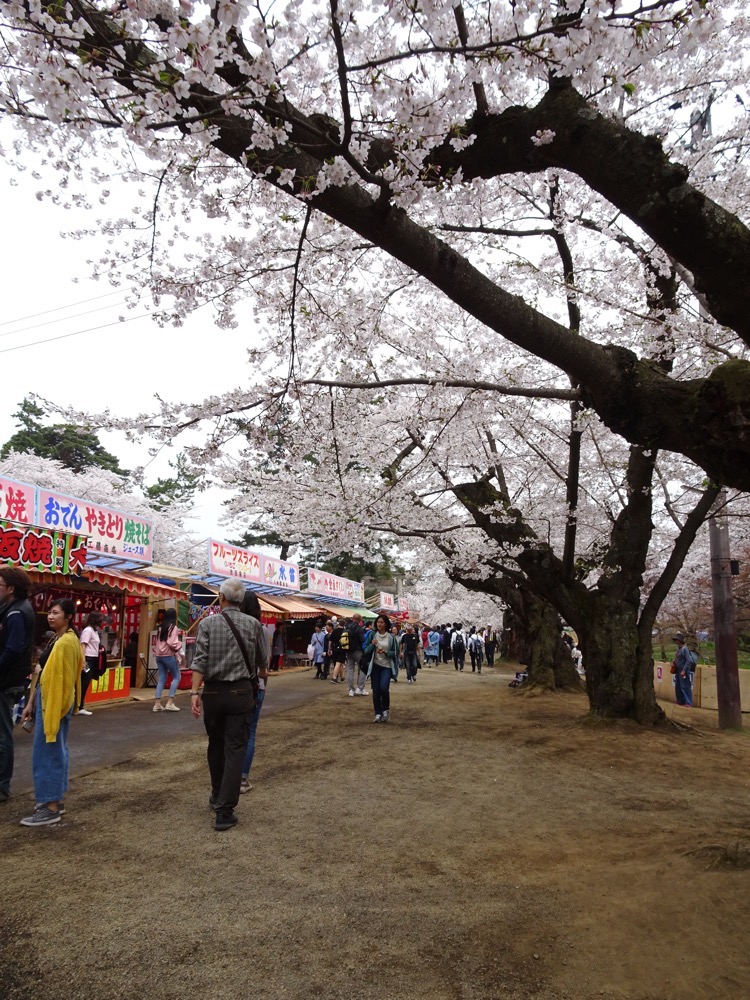 Chocolate coated banana-on-a-stick. Chocolate not being ‘my thing’, I did not try one.
Chocolate coated banana-on-a-stick. Chocolate not being ‘my thing’, I did not try one.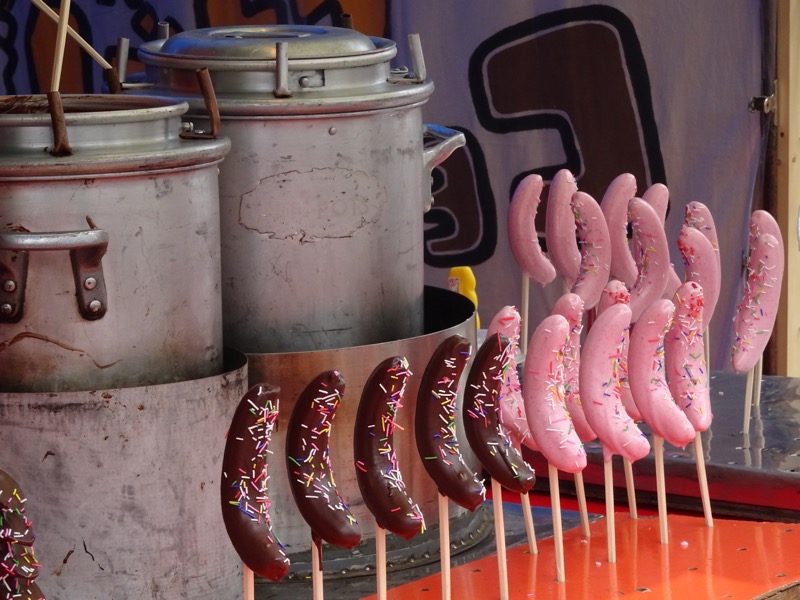
 Takoyaki ladies were industriously making snacks for the masses – one baby octopus for each takoyaki ball.
Takoyaki ladies were industriously making snacks for the masses – one baby octopus for each takoyaki ball.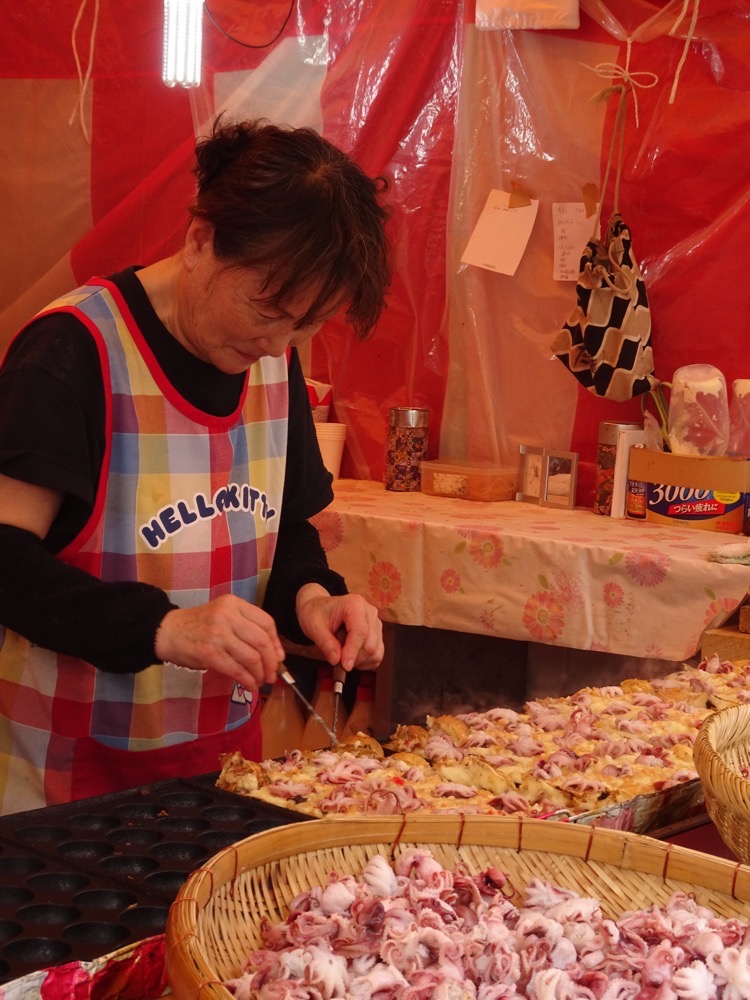
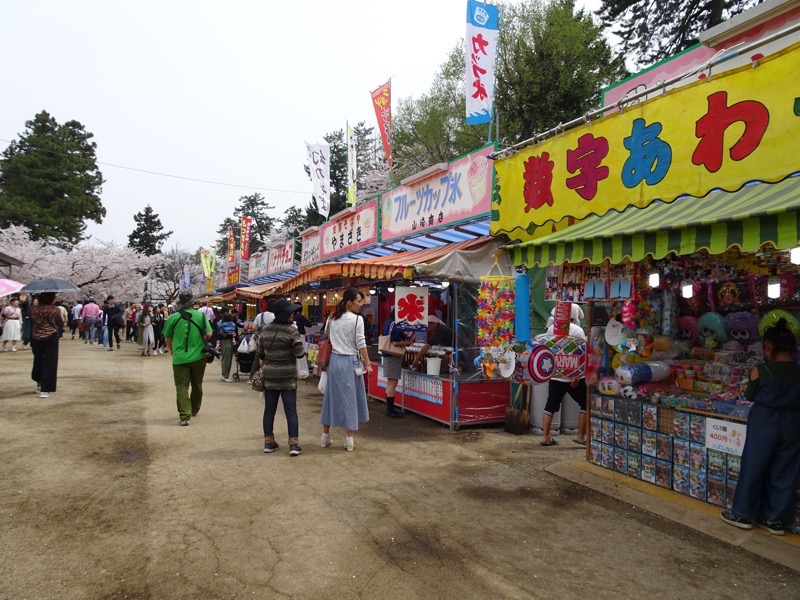 Another man and his puppy…not only are visitors required to pick up after their dogs here, but there are signs indicating that dogs must be carried in the grounds. Needless to say, we did not see any German shepherds or Rotweillers being ferried about. The Dogue from earlier had his own pram!
Another man and his puppy…not only are visitors required to pick up after their dogs here, but there are signs indicating that dogs must be carried in the grounds. Needless to say, we did not see any German shepherds or Rotweillers being ferried about. The Dogue from earlier had his own pram!
 We walked further around the moat towards the entrance of the Castle and found several beautfiful ponds surrounded by ever more cherry trees – the stillness of the water reflecting the elegance of the blossom laden branches. Just gorgeous!
We walked further around the moat towards the entrance of the Castle and found several beautfiful ponds surrounded by ever more cherry trees – the stillness of the water reflecting the elegance of the blossom laden branches. Just gorgeous!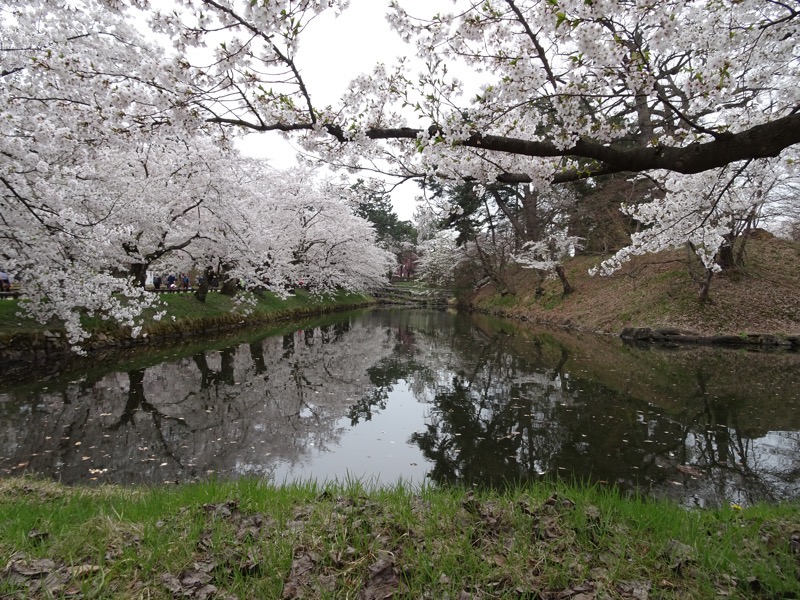
 The entire complex has hundreds of lanterns placed in among the trees – I imagine it must look spectacular all lit up of an evening…
The entire complex has hundreds of lanterns placed in among the trees – I imagine it must look spectacular all lit up of an evening…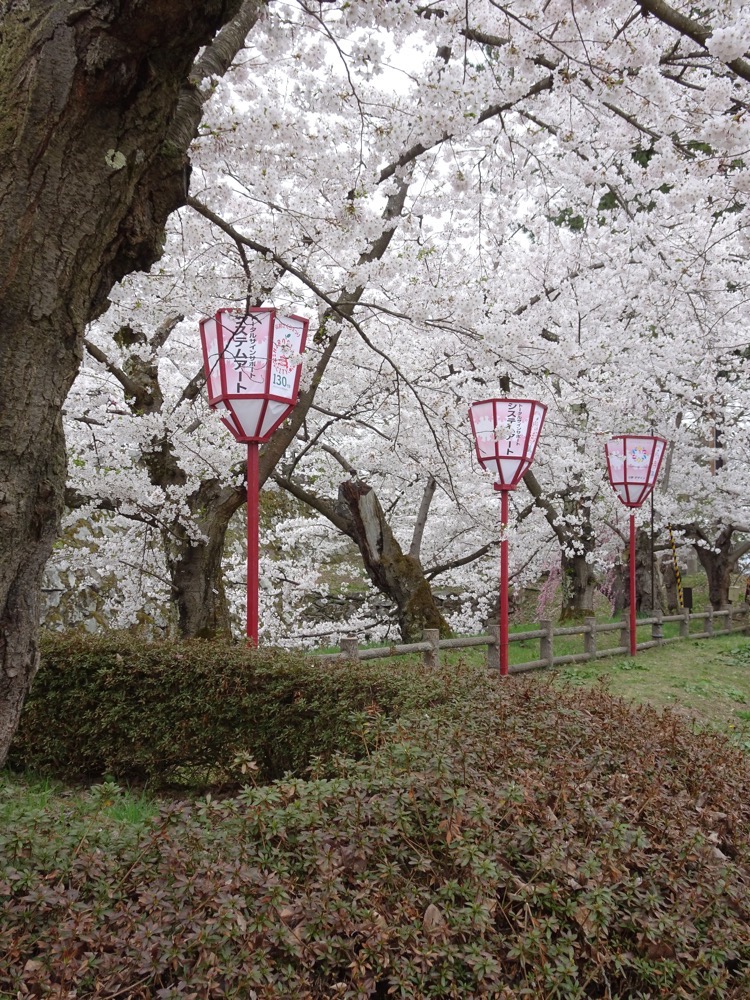
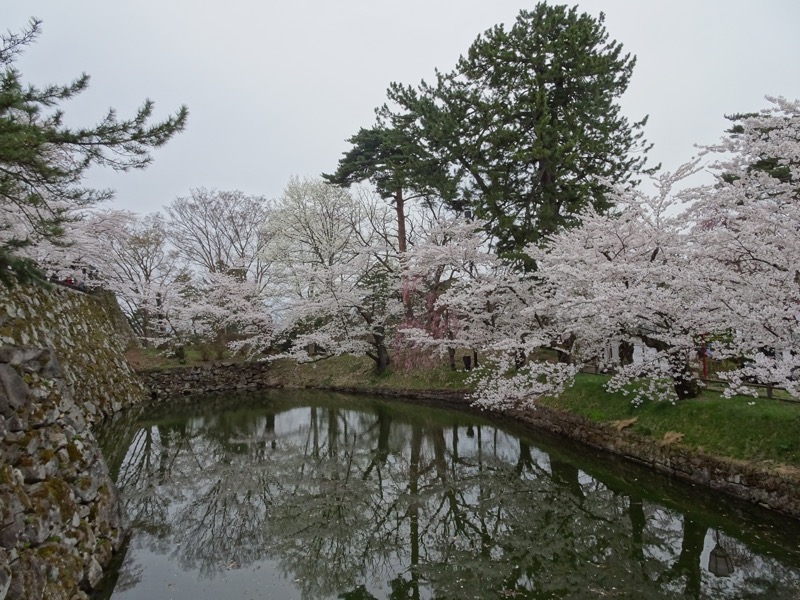
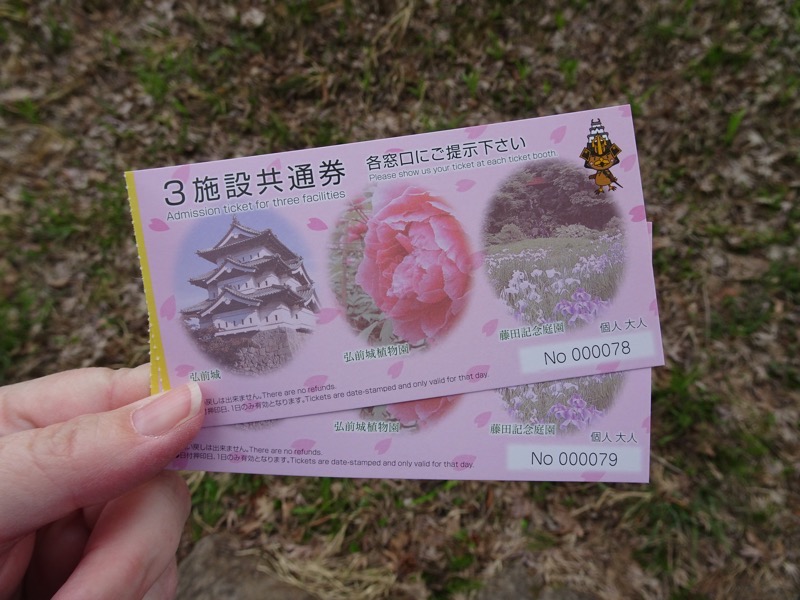 Hirosaki Castle is an epic fortress that at one time was six stories tall – lightening hit it in 1627, blowing up the tower that once housed stores of gunpowder. In 1944, the Imperial Army stripped all the bronze tiles and artifacts from the Castle to be repurposed into creating munitions for WW2 efforts. It is still quite an imposing edifice and so prettily situated in among the cherry trees.
Hirosaki Castle is an epic fortress that at one time was six stories tall – lightening hit it in 1627, blowing up the tower that once housed stores of gunpowder. In 1944, the Imperial Army stripped all the bronze tiles and artifacts from the Castle to be repurposed into creating munitions for WW2 efforts. It is still quite an imposing edifice and so prettily situated in among the cherry trees.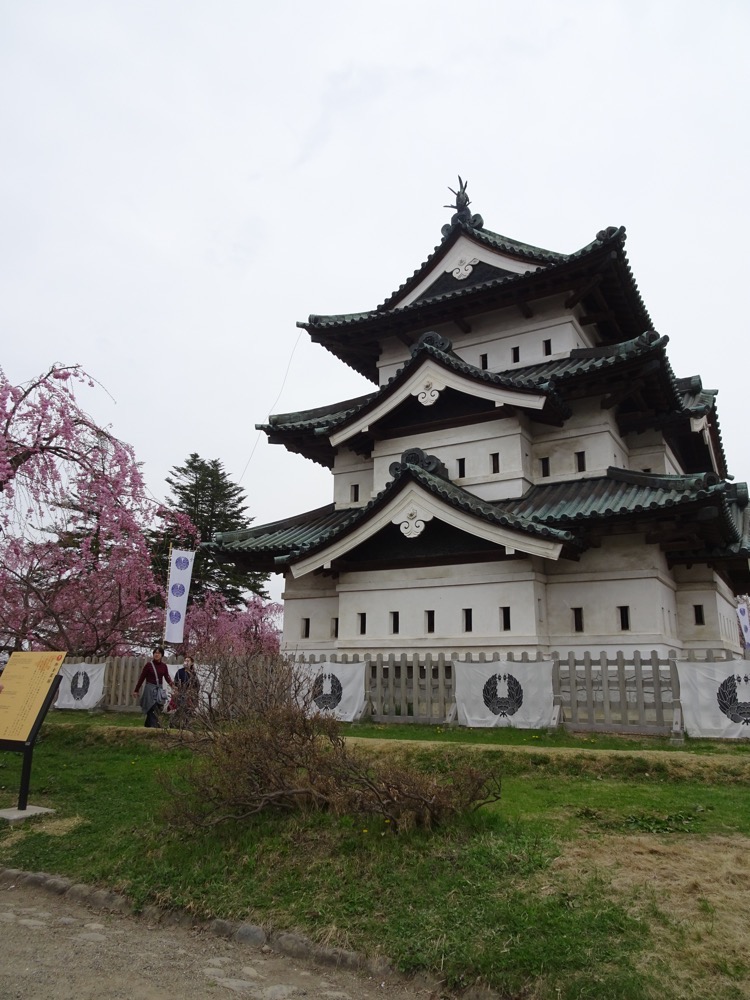


 More of the locals enjoying hanami parties.
More of the locals enjoying hanami parties.
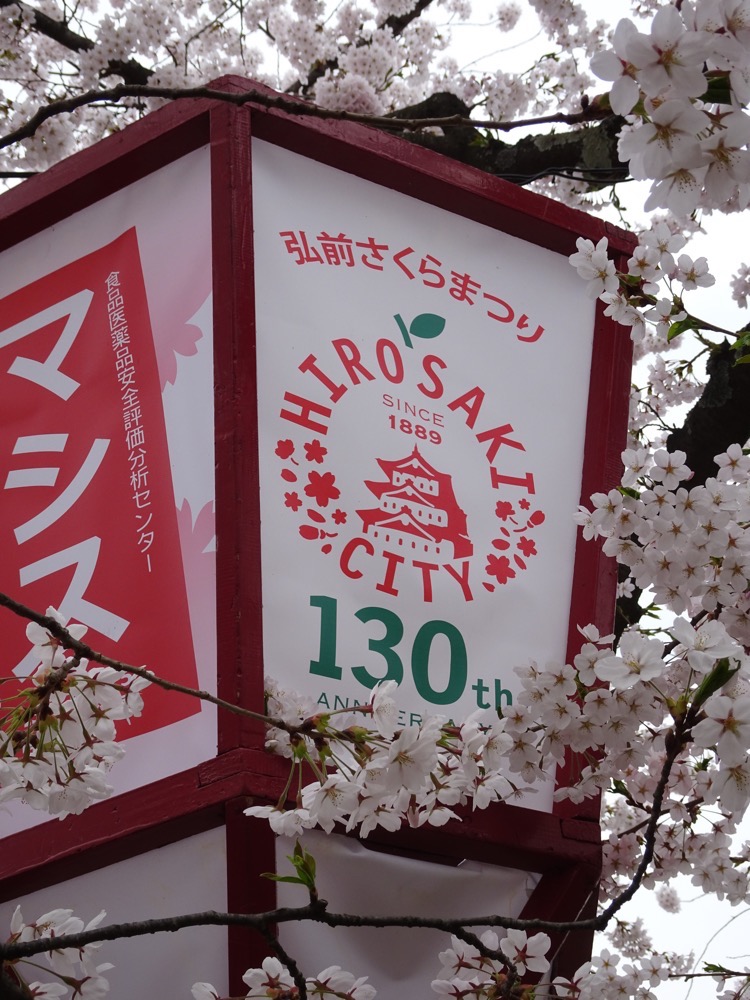 Today, it was our plan to come up to the Castle, hopefully see some cherry blossoms (little did we know what to expect!) and have some lunch under the trees to celebrate our 20th wedding anniversary… we did not know that the Cherry Blossom Festival was going to be like the international food on-a-stick festival, but as a result we ate very well – with tempura sweetcorn on-a-stick, chicken on-a-stick, pork on-a-stick, scallops on-a-stick, beers, and all good things for lunch at our picnic.
Today, it was our plan to come up to the Castle, hopefully see some cherry blossoms (little did we know what to expect!) and have some lunch under the trees to celebrate our 20th wedding anniversary… we did not know that the Cherry Blossom Festival was going to be like the international food on-a-stick festival, but as a result we ate very well – with tempura sweetcorn on-a-stick, chicken on-a-stick, pork on-a-stick, scallops on-a-stick, beers, and all good things for lunch at our picnic.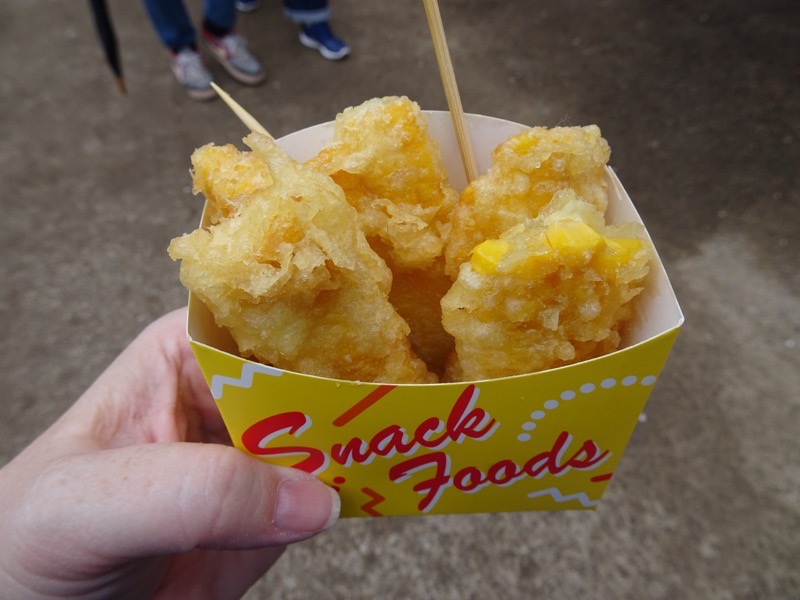

 We found a nice quiet spot to lay out our (borrowed from the ship picnic) blanket and settled in for nearly two hours, watching the world go by, the petals floating down from the trees whenever the wind picked up and listening to a nearby musician playing a shamisen. I have read many books on Japanese history and culture and in my mind’s eye, it doesn’t get more Japanese than this. I couldn’t help but wonder what it must have been like here before WW2 when the grounds would have been graced by families in traditional summer yakutas with children eating crushed iced treats, and ornately dressed maiko and geisha entertaining business men under the cherry blossoms…
We found a nice quiet spot to lay out our (borrowed from the ship picnic) blanket and settled in for nearly two hours, watching the world go by, the petals floating down from the trees whenever the wind picked up and listening to a nearby musician playing a shamisen. I have read many books on Japanese history and culture and in my mind’s eye, it doesn’t get more Japanese than this. I couldn’t help but wonder what it must have been like here before WW2 when the grounds would have been graced by families in traditional summer yakutas with children eating crushed iced treats, and ornately dressed maiko and geisha entertaining business men under the cherry blossoms…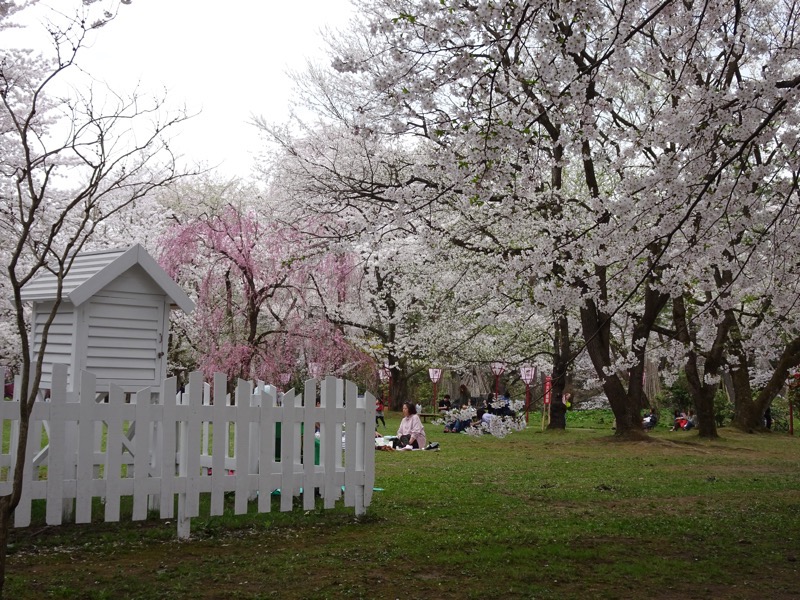
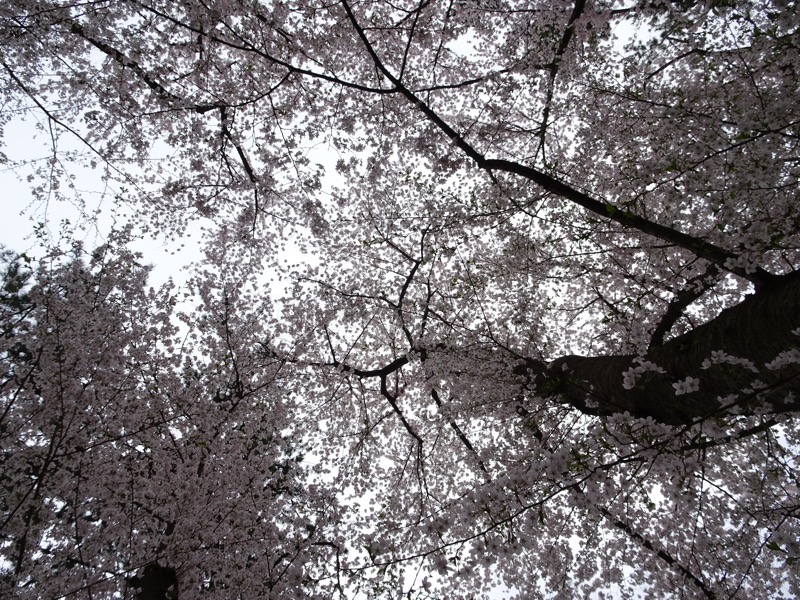 Looking up from our picnic blanket…
Looking up from our picnic blanket… After lunch we continued to wander the gardens and at every turn were greeted by yet more and more beautiful vistas surrounded by the cherry blossoms.
After lunch we continued to wander the gardens and at every turn were greeted by yet more and more beautiful vistas surrounded by the cherry blossoms.

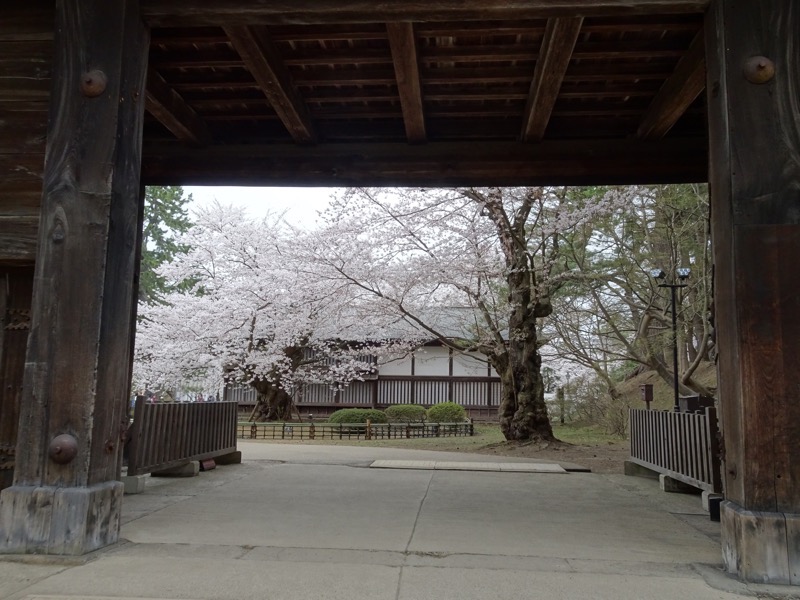

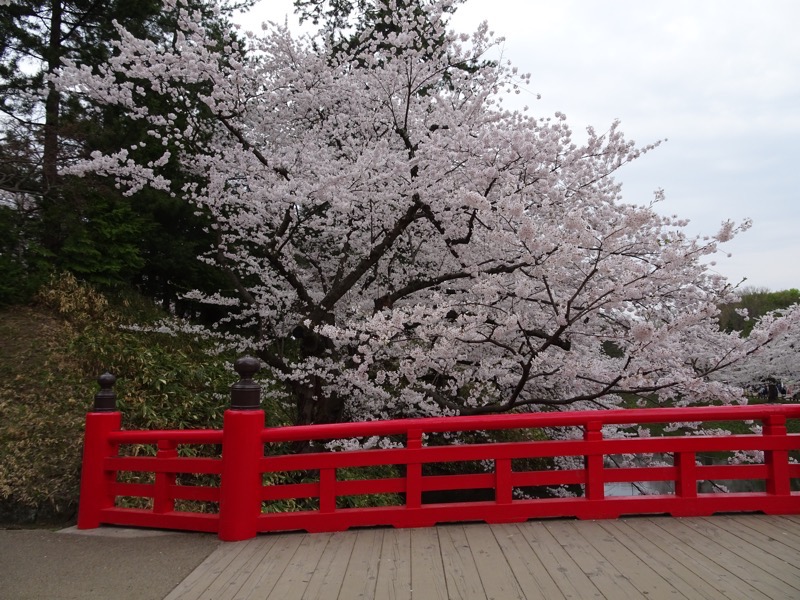



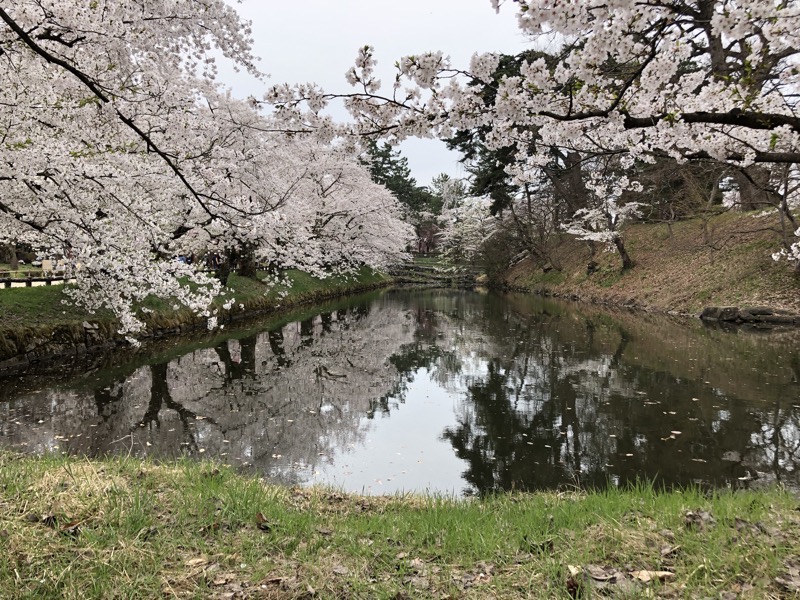 I fucking love this place…
I fucking love this place…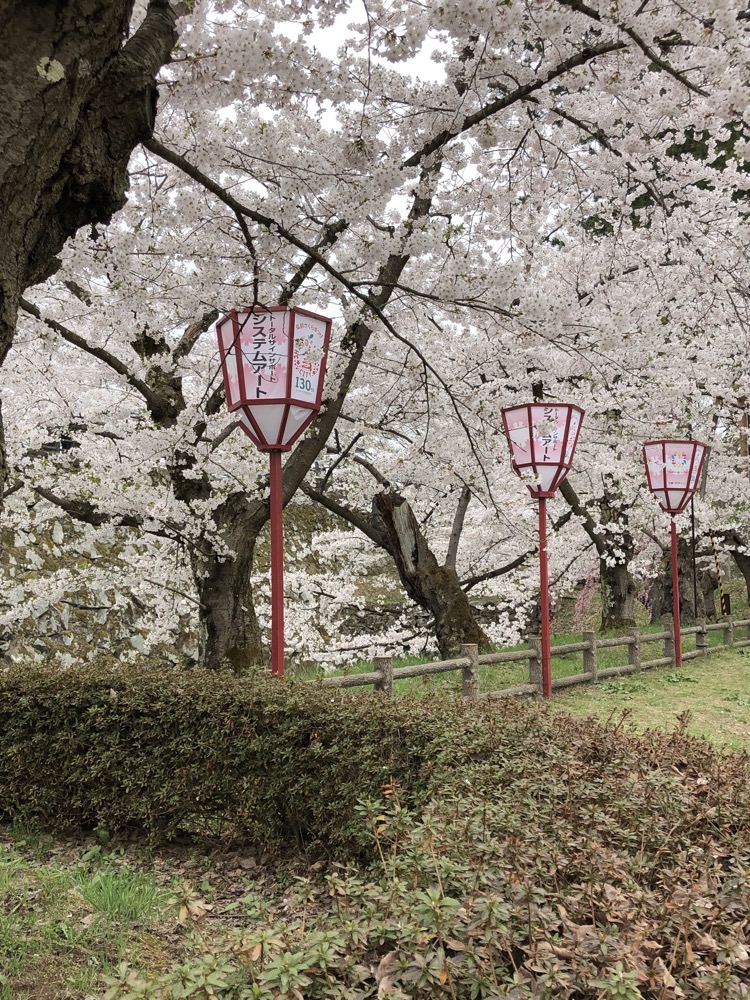 And, I fucking love this man.
And, I fucking love this man.